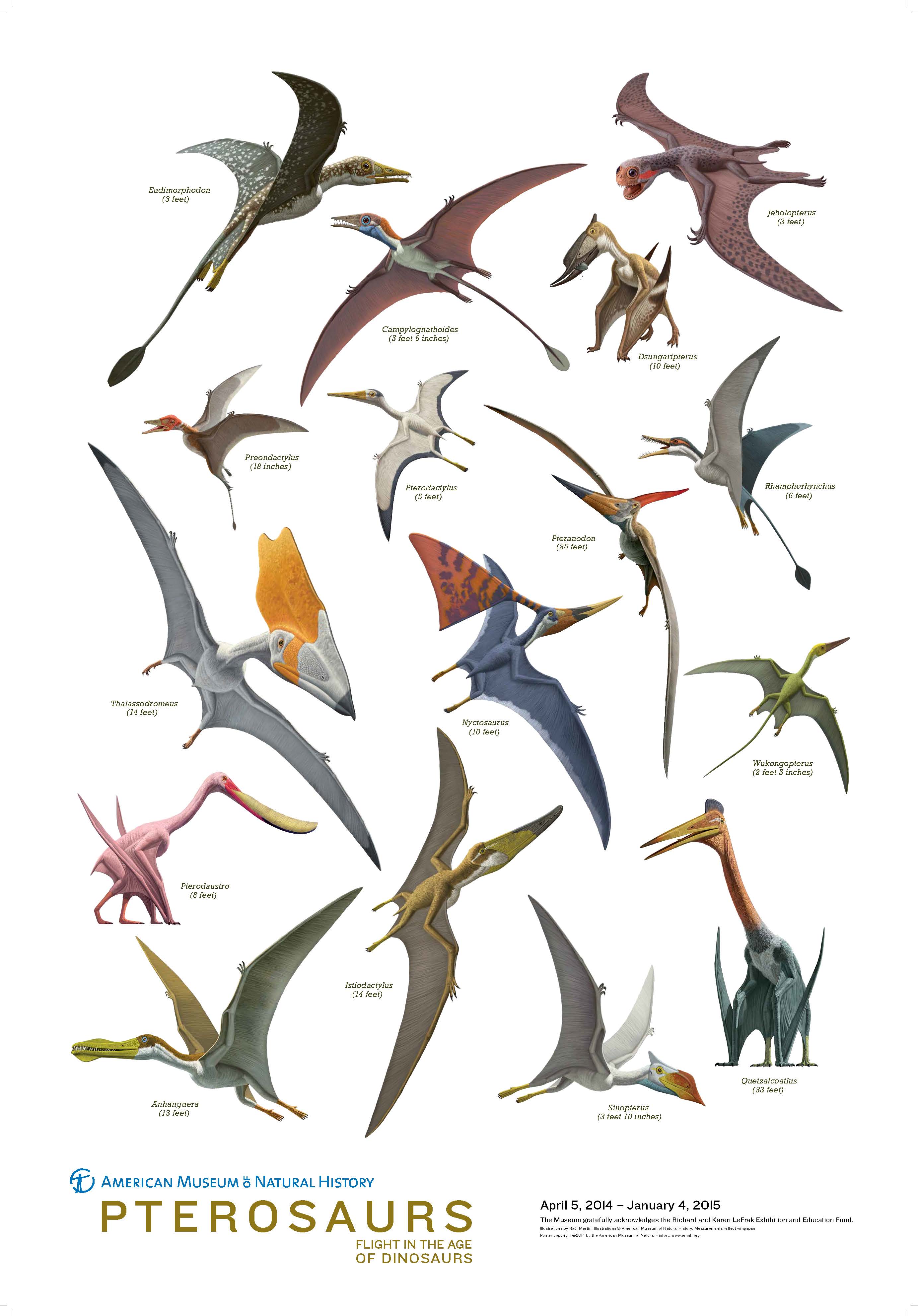
Credit: American Museum of Natural History.
Click on image for large view.

|
|
Figure 1. Poster showing reconstructions of various fossil pterosaurs Credit: American Museum of Natural History. Click on image for large view. |
© 2004-2020, Glen J. Kuban
Part of Kuban's web sites
Last revised: 5 Dec. 2020
Pterosaurs are prehistoric winged reptiles of the order Pterosauria, sometimes informally called "pterodactyls." The word "pterosaur" comes from the Greek term for "winged lizard." Pterosaurs are a diverse group (Figure 1), with over 100 recognized genera (Castro, 2016). Although they are also often called "flying dinosaurs," pterosaurs are not actually dinosaurs, but a separate group of reptiles. Their fossils range from late Triassic to the end of the Cretaceous (about 228 to 65 million years ago). Many early forms had long tails and many sharp teeth (Figure 2a), while others Pterodactylus had long snouts but reduced tails (Figure 2b). Later forms such as Pteranodon (Figures 3a, 3b) exhibited large head crests but lacked teeth. Paleontologist debate whether head crests served aerodynamic functions, and/or were involved in sexual selection. All pterosaurs had long wings formed by membranes of skin and other tissues stretched over an extremely long forth finger on each arm. Some paleontologists believe the bodies of many were covered with hair-like filaments called pycnofibers, while others have suggested taht some may have had protofeathers (Yang, 2019). More recently Unwin and Martill (2020) argued that most if not all were "bald" (hair and featherless). Their adult sizes spanned a wide range, from some as small as robins to giant forms that were the largest winged creatures of all time. The latter included genera such as Quetzalcoatlus and Hatzegopteryx with wing spans of over 30 feet, although there is some debate over whether these huge forms could fly (Witton and Naish, 2013).
Based on fossil evidence, most scientists believe that pterosaurs went extinct along with non-avian dinosaurs at the end of the Cretaceous Period, about 65 million years ago. Nevertheless, a small number of cryptozoologists (who investigate reported but unconfirmed creatures), and a few young earth creationists or "YECs" (who believe that the Earth and all life forms were created only several thousand years ago) have argued that one or more pterosaur species may have survived into modern times, and may still exist. According to Jonathan Whitcomb, one of the most active and vocal "living pterosaur" advocates, most are similar to prehistoric "rhamphorhynchoid" forms, but with large head crests more typical of Pteranodon-like pterosaurs, which he depicts in some drawings (Figures 7a and 18).
Whereas I acknowledge the slightest possibility of living pterosaurs (hereafter abbreviated "LPs") in remote areas, I and most conventional scientists remain very skeptical, since 1. There is no fossil evidence that any pterosaurs survived past the Cretaceous Period, and 2. Most supposed evidence for LPs relies on reported "sightings" which lack credible photos or other forensic documentation. Such anecdotal evidence is not a sound basis for firm scientific conclusions. Numerous studies have indicated that eyewitness testimony is very unreliable, and can be affected by many factors, including physical and temporal distance, bias, motivations, etc. (Arkowitz, 2010; Engelhardt, 1999).
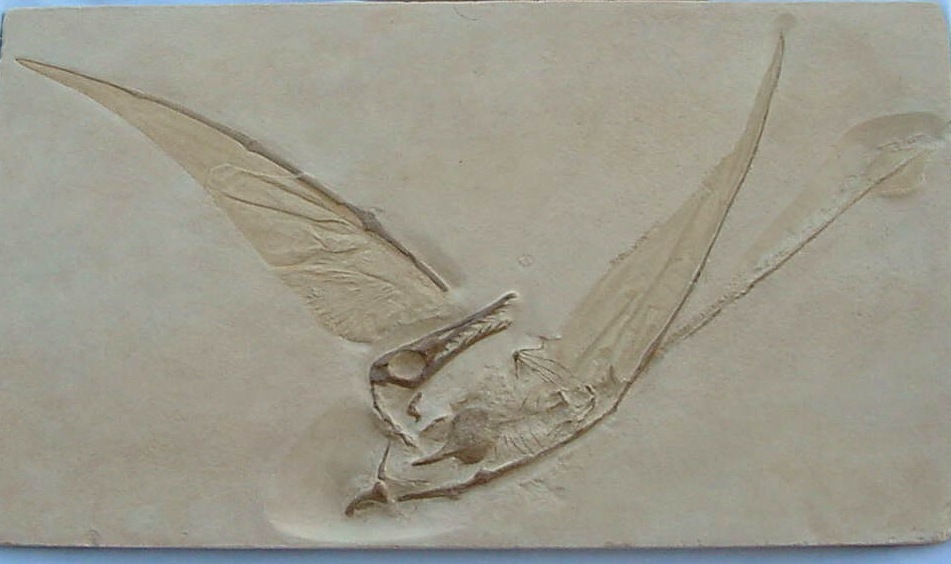
|
|
Figure 2a. Rhamphorhynchus munsteri A long-tailed pterosaur with teeth, showing rare impressions of wing membranes and tail vane Cast by Glen Kuban |
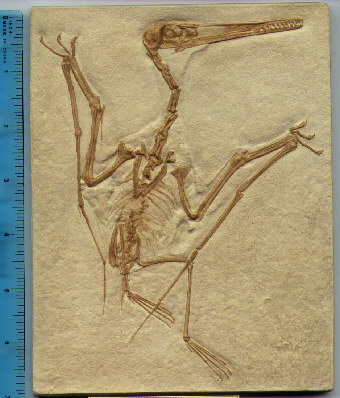
|
|
Figure 2b. Pterodactylus kochi A short-tailed Jurassic pterodactyl, about the size of a crow Solnhofen Limestone, Germany Cast by G. Kuban |

| |||||
|
Figure 3a. Pteranodon longiceps reconstruction by Eaton (2010)
| 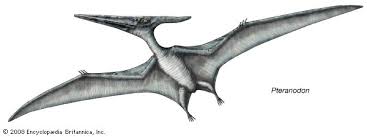
Figure 3b. Pteranodon in flight |
|
|

Figure 4. Heron in flight, resembling a Pteranodon-like pterosaur.
Credit: Janet Fikar |
|
Whitcomb and associates have suggested that mainstream scientists are unduly biased against the idea of living pterosaurs on the grounds that such finds would threaten conventional geology and evolution (Whitcomb, 2017a). However, this is a misguided notion, since the survival a remnant species from a group once thought extinct would be a wonderful discovery, but not the least problematic for evolution or an old Earth. While one can argue that everyone (including me) has some bias, any I have does not exclude the remote possibility of living pterosaurs, even though I and most other scientists are properly skeptical for reasons already discussed. Nor do we "fear" the idea of extant pterosaurs as Whitcomb asserts; in fact, I like most scientists would wholeheartedly welcome such a find, as long as it was properly documented. As evidence, when such "living fossil" finds have been made before, such as Latimeria (a modern genus of lobed-fin, Coelacanth fish thought long extinct until one was caught off the coast of Africa in 1938), and Metasequoia (Dawn Redwood), scientists were not dismayed, nor tried to cover them up, but the opposite: they openly celebrated and widely publicized the discoveries. Moreover, representatives of many other groups that were alive while dinosaurs roamed the Earth are still with us today, including sharks and other fish groups, crocodilians, turtles, lizards, birds, small mammals, etc., although the ancient forms are not the same species as modern ones.
So, the focus of some YECs on finding living pterosaurs or other possible survivors of prehistoric groups, in hopes that this will confirm their young-Earth views and refute evolution is quite misplaced. What YECs actually need to accomplish this is essentially the opposite: reliable evidence of modern forms existing much earlier in the geologic record than evolutionary theory can comfortably accommodate, such as humans or other large modern mammals anywhere in the early Mesozoic, Paleozoic, or Precambrian. This is not too much to ask, since YECism holds that most fossils were deposited together in a worldwide flood just a few thousand years, meaning that there should be countless thousands of such finds. Yet not one reliably documented example exists, as acknowledged even by large YEC groups such as AIG (Answers in Genesis). Therefore, the finding of say an Ordovician or Silurian pterosaur would, ironically, be far more problematic for mainstream geology than a modern one.
Likewise, Whitcomb's frequent lament that conventional scientists are blinded by a "universal-extinction dogma" (that all
dinosaurs and pterosaurs are extinct) is readily dispelled by the fact scientists already accept
that not all dinosaurs are extinct, since almost all modern paleontologists regard birds as a branch of feathered dinosaurs.
So, it is clear that scientific skepticism over the concept of living pterosaurs is not due to prejudice or dogma,
but evidence - fossil evidence pointing strongly to the likelihood of pterosaur extinction, and lack of compelling
evidence to the contrary.
Sightings
"Early 1960s, California - A couple driving through Trinity National Forest reported seeing the silhouette of a giant "bird" that they estimated to have a wingspan of 14 feet. They later described it as resembling a pterodactyl.""January, 1976, Harlingen, Texas - Teens Jackie Davis and Tracey Lawson reported seeing a "bird" on the ground that stood five feet tall, was dark in color with a bald head and a face like a gorilla's with a sharp, six-inch-long beak. A subsequent investigation by their parent's uncovered tracks that had three toes and were eight inches across."
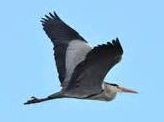
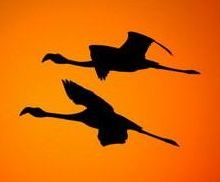
|
|
Figure 6a. Blue Heron (left), Flamingos (right) |
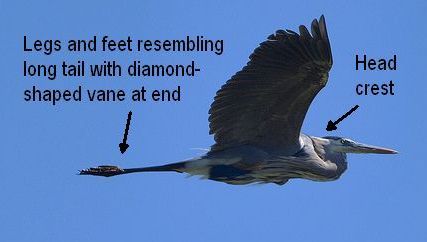
|
|
Figure 6b. Great Blue Heron in flight |
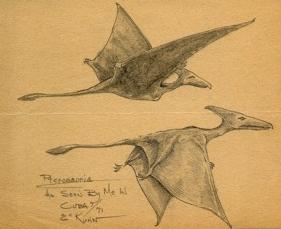
|
|
Figure 7a. Drawing by Eskin Kuhn, often used by Whitcomb to show a typical modern pterosaur, showing a large posterior head crest and long tail - features not found together on fossil pterosaurs. |
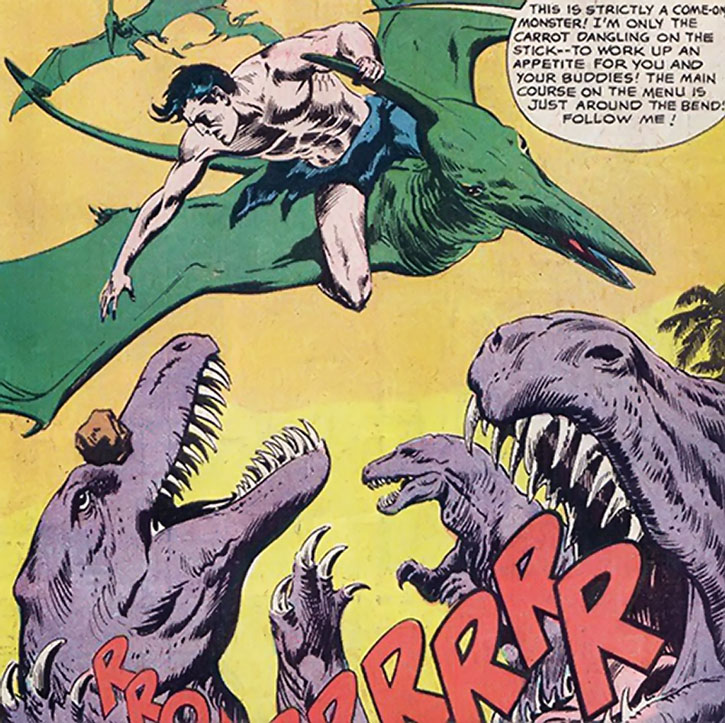
|
|
Figure 7b. DC Comics pterosaur showing a posterior head crest and long tail, as reported in many "sightings," but not real pterosaur fossils. |
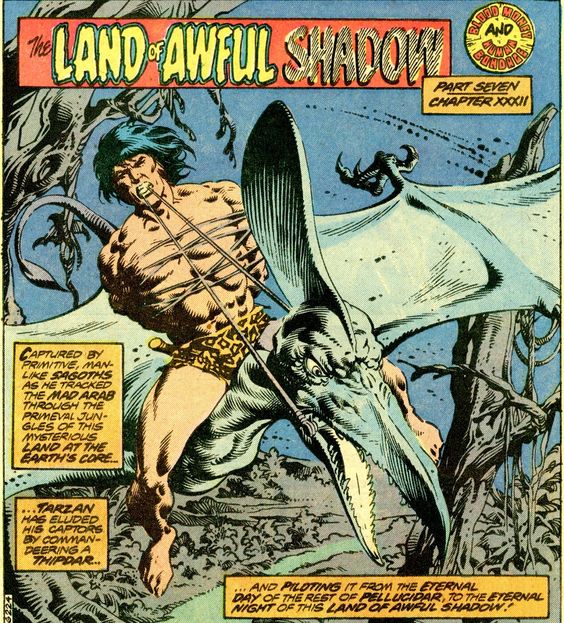
|
|
Figure 7c. Comic pterosaur showing Rhamphorhynchus-like tail and teeth, combined with Pteranodon-like head crest |
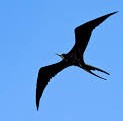
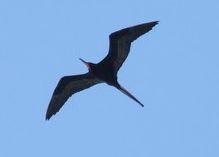
| |
|
Figure 5. Frigate birds in flight. Note the lack of obvious feathers when observed from a distance. When the legs are held together, they can resemble long tails of rhamphorhynchoid pterosaurs |
|
Notice that both accounts specifically call the creatures birds. Only the first even mentions a resemblance to a pterodactyl, and it was seen in silhouette, which tends to obscure potentially important details. As far as the large reported size goes, people are notoriously poor at estimating the size of objects, especially if in the sky or at a distance. In this case, we don't even know how far away the creature was. The second account sounds decidedly more like a large bird than a pterosaur. Besides being called a bird, a "gorilla like" face seems fit a buzzard better than a pterosaur. If it made three-toed tracks, it further supports a bird interpretation, since birds generally make tracks with three toes (or three forward pointing and a rearward pointing toe), whereas pterosaurs had four long toes and one small toe on each hind foot. The reported size of the tracks is also in the range of several large US birds.
Indeed, it is likely that many if not most alleged pterosaur sightings are misidentified birds. Many large birds, including herons, egrets, cranes, eagles, vultures, pelicans, flamingos, and frigates, can present superficially pterosaur-like shapes (Hill, 2014), especially if seen from a distance and/or in silhouette. Some birds such as frigates have long tails can resemble profiles of long-tailed rhamphorhynchoid pterosaurs in flight (Figure 5), as can herons, cranes, and flamingos that dangle their long legs behind them as they fly. Further, their feet in profile can even resemble a pterosaur-like "vane" at the end (Figure 6a, 6b), and head crests on herons and egrets might be mistaken for crests of Pteranodon-like pterodactyls. Other animals in flight, such as certain bats (Figure 22) and large, short tailed birds, can resemble short tailed pterosaurs.
Another complicating factor is that many people have relatively little familiarity with pterosaur anatomy, or with the variety of large birds that may inhabit an area, especially when they (the people that is) travel to new areas. A bird watcher recounts an incident where a Great Blue Heron flew by a nearby man in a bass boat, who shouted (apparently in all seriousness), "It's a pterodactyl! It's an effing pterodactyl!" (Babsje, 2013). Even many bird experts have commented on the way herons and egrets resemble or remind them of pterosaurs --from their long beaks and head crests to their graceful take-offs and soaring with long wings and rearward dragging feet. A website discussing Great Blue Herons remarks: "In the air, these pterodactyl-like creatures with wingspans of up to seven feet are quite a sight to see (Stevens, 2014)." A Birdnote.org article states that this regal bird "Looks Like a Modern Day Pterodactyl...tall and prehistoric looking..." (Grey, 2007). Another states: "The prehistoric-looking Great Blue Heron is one of the largest... " Frank (2015). Similarly, when discussing a soaring frigate bird silhouetted against the blue sky (Figure 5, right photo), blogger Dan Grec writes: "I'm reminded of Pterodactyls when I see these birds" (Grec, 2009).

|

|
| Fig. 8. Radio controlled pterosaurs in flight |
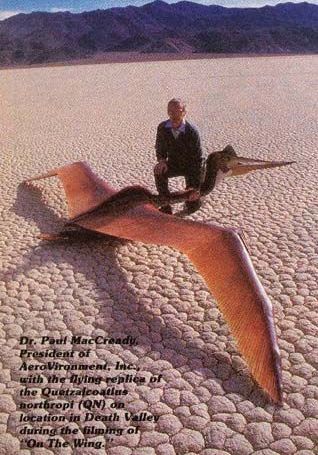
|
|
Fig. 8b. Paul MacCready with his 1984 ornithopter based on the giant pterosaur Quetzalcoatlus |

|
|
Fig 8c. Unnamed model builder with RC pterosaur glider |
Another problem, often neglected or minimized by living-pterosaur advocates, is that a wide variety of pterosaur kites, radio-controlled models, and pterosaur "ornithopters" (models with flapping wings) have been available for decades from commercial sources, while others are custom built by hobbyists. Where Whitcomb does mention "mechanical models" he quickly dismisses them as being inconsistent with witness descriptions or site conditions, but they seem capable of creating at least a few mistaken sightings, especially in developed countries. Some are quite realistic looking, especially when viewed from a distance (Figure 8). At least a few videos of them have been used to promote the idea of living pterosaurs (whether based on mistaken ID or deliberate misrepresentation ). For example, a YouTube video entitled "Real FLYING "DRAGONS" found alive & caught on camera?! (Pterosaurs, Pterodactyls & Thunderbirds!)", which has no narration (just dramatic music) shows at least two radio controlled pterosaur models, as well as some sculpted pterosaurs in trees, and dubious historic photos such as those shown in Figures 5 and 6 below. One of the RC models shows rear leg vanes that are so distinct its specific RC manufacturer (Martson) can be identified. Several other videos on YouTube and other websites purportedly showing living pterosaurs feature similarly dubious footage, most lacking any source information.
In cases like the above video, we have many visual clues to judge the veracity of the claims being made or implied. However, in many "sighting" cases we have no photos or film to go on, making it very difficult to assess a witness's honesty or accuracy. In personal interactions, it may be good to give people the benefit of the doubt, but in science we need more than trust in someone's sincerity and memory to make a compelling case. Many people assume they can accurately judge a person's honesty, and that witness perceptions and memories are largely accurate and stable over time, but scientific experiments demonstrate otherwise on all accounts.
In short, the anecdotal evidence on which LP advocates unreasonably require that we entirely trust all of the following in each "sighting," which I'll term the "chain of uncertainty"
1. The witness was completely honest, sober, sane, and lucid.
2. The witness's perceptions were entirely accurate.
3. His or her memory never faded or changed.
4. The witness accurately described whatever he or she remembered
5. The interviewer or researcher accurately recorded the testimony
6. The researcher accurately conveyed the account in his or her writings
The problem is, in most cases we can't know any of the above for sure, let alone all of them. Moreover, when accounts are related second or third-hand, or from individuals with histories of dubious or unfounded claims, even more levels of uncertainty exist. For these and other reasons explored below, anecdotal evidence is of little if any scientific value unless backed by compelling empirical evidence. Those who fully agree with this may want to skip to the section on "Sightings"; however, for those who need more convincing, the following additional considerations are offered.
Whitcomb acknowledges that many sightings may be misidentifications or hoaxes, but "judges" that at least half are not, and therefore "credible" (Whitcomb, 2017a). However, that is a highly subjective assessment. He admits that a small percentage of sightings (perhaps up to 5%) may also be from individuals with mental issues, but seems to often neglect or minimize other possible complicating factors such as drug or alcohol use, imperfect eyesight or viewing conditions, and most importantly, faulty and faded memories. Those sightings he features in his book he often describes as "credible," implying that we should trust the witnesses as completely honest and accurate. However, scientific studies show that witnesses are often unreliable--either mistaken in whole or part, or less than honest (Arkowitz, 2010; Engelhardt, 1999). Just as relevant, studies also indicate that people, including even police and professional investigators, are generally poor at detecting when others are lying or shading the truth (Navarro, 2012). On p. 102 Whitcomb flatly states, "Eyewitnesses are honest," even though in other places he himself admits to finding evidence that some are not. He often asks why a witness would lie about this or that, even though as we all know, people often exaggerate and lie about many things, for any number of reasons, or no discernable reason. Even if we could know a witness was entirely sincere and honest, it is still usually difficult to rule out faulty perceptions and flawed memories.
Many reported sightings are from people recalling events that happened years or even decades earlier, often when they were only young children. This is of special concern, since scientific studies show that memories are very unstable and pliable (affected by many variables), and tend to change substantially with time --often not much time (Dobrin, 2013; Konnikova, 2015). As disconcerting as it may be, scientific experiments have shown that memories often change significantly in just only one or two days, and with each time an event is recalled (Chant, 2012). Childhood memories have been shown to be especially faulty and unreliable (Vergano, 2013).
Although the scientific evidence for these things is compelling, most readers can probably readily confirm them for themselves. Almost everyone has had the experience of recalling an event from their past with what they feel is complete clarity, only to find friends or family members who remember the same event very differently, often with just as much conviction. Recent studies have helped explain why and how this happens (Dobrin, 2013), but whatever the reasons, the upshot is that mere recollections cannot be considered scientifically reliable without firm empirical evidence to back them up.
Another concern is that Whitcomb actively solicits "pterosaur" sightings in his books and on many of his web pages, often with large clickable banners asking: "Please report your sighting." This may prompt some to fabricate sightings as a joke or lark. The link leads to a notice that witnesses need not leave their. names, and may remain anonymous if their sighting is published. This explains why Whitcomb often refers to witnesses by their initials. In the 2014 edition of his book Searching for Ropens and Finding God (SFR) Whitcomb says that keeping witness identities secret will help avoid "making life too easy for hoaxers." However, his reasoning seems upside-down. The assurance of anonymity may well tempt more people to fabricate or exaggerate a sighting, since it would minimize chances of any negative consequences. Another problem with publishing anonymous accounts is that there is no way to check what a witness said. Even if both the witness and researcher are sincere, mistakes can be made in documenting or interpreting witness statements.
On the other side of the coin, some attention seeking individuals might report a sighting even with their name, in anticipation of seeing it featured in an article or book. They might also be subtly encouraged to enhance or exaggerate what they saw or remembered, or make it conform more to other reports, especially since Whitcomb often praises those who "come forward" to report a sighting as brave and courageous. That he seems to give the most adulations to those who give detailed and uniquely pterosaur-like descriptions might also subtly encourage others to do so, even if they are not quite sure of what they saw or remembered.
Whitcomb acknowledges being biased, and even asks in one place, "Who else has a greater potential, at least theoretically, to be swayed by bias than me?" (Whitcomb, 2017, p. 92), but claims that mainstream scientists are also biased by assumptions and "dogmas" about dinosaur and pterosaur extinction. However, as discussed earlier, scientific skepticism of living pterosaurs is not based on assumption or dogma, but evidence and lack thereof. Again, whereas I and everyone else may be somewhat biased by a variety of factors, I for one have no philosophical stake in whether the Earth is young or old, but accept the latter due to the great preponderance of evidence, which is the same reason I strongly doubt the existence of living pterosaurs, even though I'd be thrilled if a live one were confirmed. In contrast, Whitcomb and his associates seem firmly committed to the idea of living pterosaurs, and strongly motivated by a desire to vindicate their young-Earth, anti-evolutionary views, even though demonstrating the existence of living pterosaurs would do no such thing.
Whitcomb sometimes argues that his motives are not mainly religious in nature, but many of his writings indicate otherwise, including the title of his book "Searching for Ropens and Finding God" (Whitcomb, 2014). In it he discusses his religious beliefs and motivations, including his conviction (as misplaced as it is) that demonstrating the existence of living pterosaurs will help confirm Noah's Flood and refute mainstream geology. One of his web pages entitled "Is the Ropen a Pterosaur", referring to the 2nd edition of Searching for Ropens states, "Be aware: This is a spiritual as well as a cryptozoological book, with much of the appendix disputing the General Theory of Evolution..." (Whitcomb, 2007). Even his Amazon promo for the book reads: "This fully supports the literal Flood of Noah in the Bible..." which he apparently tries to soften by adding "although the genre is nonfiction cryptozoology." Whitcomb sometimes objects to being described as a YEC (young-Earth creationist), on the grounds that he does not believe the entire universe is young. However, he acknowledges rejecting conventional geology and believing in a recent fiat creation of the Earth and all life on it, based on a literal interpretation of Genesis, which by any reasonable definition, makes him a YEC.
"Eyewitnesses" can also be subject to confirmation bias and other influences. Even when entirely sincere, they can be affected by peer pressure, and by things they have seen in movies, books, websites, etc., including all the "sightings" they read about in books and websites that promote "living pterosaurs." In other words, sighting reports and can feed off each other to foster more reports, and more confidence, conformance, and details in them than might otherwise might have been the case --what might be called the "me too" phenomenon. "Witnesses" can also have their memories or perceptions adversely affected with they are startled or frightened by something unexpected or unfamiliar.
Whitcomb relates that his parents were psychologists, and that he therefore is aware of and taking into account all possible psychological factors in witness reports as well as his own bias and methods, but often his arguments and assumptions seem to indicate otherwise. Often he talks about why a witness did not seem insane or dishonest, largely neglecting the more common and pervasive problems of faulty perceptions, altered memories, and the many factors that affect can both.
Besides often describing witnesses as "very credible" with little to go on but their word, he often seems to assume that virtually any reportedly pterosaur-like creature or feature is strong evidence of living pterosaurs. His choice of words often demonstrates complete confidence in the accuracy of witnesses' perceptions, descriptions, and memories, often based on his subjective impressions of their demeanor (even in emails, where body language and such cannot even be seen). He often states matter-of-factly so-and-so "saw" this or that, or that the creature "did" this and that, instead of saying the person reported seeing such and such, or stated that the creature did this and that, which would be more objective and scientific. Often he says that he found no reason to doubt a person's word, as if that settled the matter, neglecting the fact that people often report things inaccurately (whether deliberately or not) without showing any obvious indications of it.
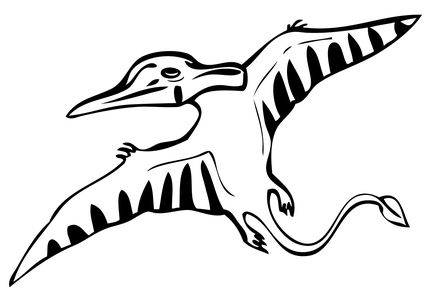 |

| |||||||||
|
Figure 7d. Cartoon pterosaurs showing large posterior head crests with long tails, often reported in "sightings" but not found together on real pterosaur skeletons
|
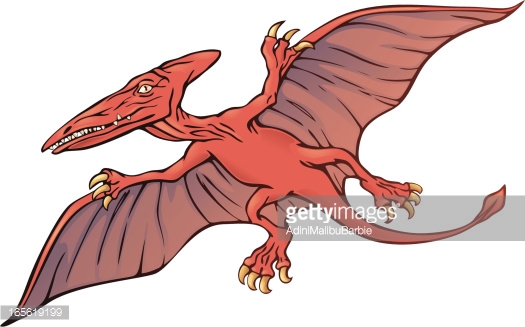
| 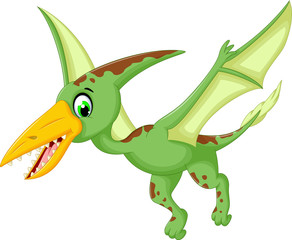
Figure 7e. Cartoon pterosaurs showing large | posterior head crests, long tails, plus teeth, sometimes reported in pterosaur "sightings" but not found together on real pterosaurs
| 
Figure 7f. This was done by an artist to | teach others how to draw pterosaurs, showing a Pteranodon-like head crest with "added" Rhamphorhynchus-like tail | |||||
In view of all this, mainstream scientists have no obligation to address the many anecdotes and other unsubstantiated evidence for modern pterosaurs offered by Whitcomb and associates. However, in view of their increased publicity efforts in recent years, and the curiosity many readers may have about their claims and alleged "evidences," reviewing some of them may be useful and edifying, and hopefully help convey some basic scientific principles along the way.
U.S. Sightings
By 2012 Whitcomb expanded his tally of "credible" U.S. sightings (from both first and second hand sources) to 90 in 33 U.S. states, and
his worldwide total (including the domestic ones) to 128 sightings in several countries (Whitcomb, 2015a). While this might seem impressive
on first blush, on closer examination it seems to actually detract from his argument. Indeed, if large prehistoric reptiles were really flying
around most U.S. states and multiple foreign countries, even if mostly at night (discussed further below), instead of several dozen sightings
over decades, we should expect many more (at least thousands), and on a more regular basis, and at least occasionally good photos and bodily remains.
After all, many other nocturnal animals, including smaller bats and owls, are regularly seen and very well documented.
The discrepancy is accentuated when the sighting tallies are broken down by state. Twenty one of 33 states have only 1 or 2 sightings; another 3
states have 3 sightings; and only 6 states have more than 3. Texas and California have the most, with 10 and 13 each. Whitcomb argues
that many people might be afraid to report sightings for fear of ridicule, but even if this applied to more than half of witnesses, we
should still expect many more sightings, and at least some good photographs and hard evidence (carcasses, eggs, tracks).

|
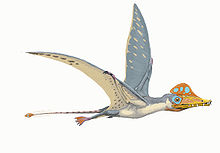
|

|
|
Fig. 9 Scaphognathus crassirostris Original fossil, showing no crest (top) Reconstruction with small, fleshy crest (middle) Reconstruction with no crest (bottom) |
Whitcomb emphasizes that some witnesses describe features incompatible with modern birds, such as teeth, a long tail ending in a "diamond," and the lack feathers. But again, even if we could rule out exaggerations and fabrications, mistaken ID's are not only possible, but in all liklihood, very common. As mentioned earlier, the legs and feet of some birds in flight can mimic pterosaur-like tails, including an apparent vane at the end (Figure 6). Relatively few witnesses refer to teeth, and even they are typically from distances or under conditions that would make it difficult to reliably discern such details. The same goes for feathers. Often they are difficult to distinguish when a bird is seen only briefly or at a distance. Frigate birds in particular have wings that often appear featherless, and the smooth, grey feathers of some herons can appear cloth-like or leather-like.
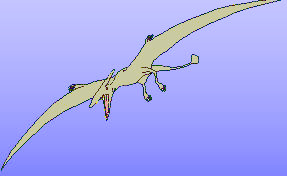
| |
|
Figure 10. Cartoon "Ropen" showing long tail with Rhamphorhynchus-like head crest, used on J. Whitcomb's "What is a Ropen?" web page |
|
Ironically, even if some of these "combo" pterosaur depictions have gone extinct, Whitcomb has done his part to resurrect them, with his books and many pages showing similar drawings. These include his often used Eskin drawing (Figure 7), his "composite" Ropen (Figure 18), and one of the cartoons he uses on his "What is a Ropen" web page (Figure 10). In other words, his own promotions, icons, and depictions of living pterosaurs are, ironically, fostering the same potentially complicating influences that he claims went extinct decades ago. Underscoring these concerns, a study by Kang (2011) demonstrated that "visual working memory" can influence our perceptions; in other words, mental images in the mind's eye can alter the way we see and remember things.
In this vein, it may be telling that LP witnesses seldom describe creatures with fur or hair, even though fossil evidence indicates that most if not all pterosaurs had furry coats made of hair-like filaments called pycnofibers. The likely explanation is that many sightings are influenced by pterosaurs seen in movies and popular literature, in which hair is seldom shown, or not obvious. Likewise, it is also likely that pterosaurs had translucent wing membranes, yet this too is virtually never reported in "sightings." Instead they are often describe them as "leathery" -- again matching popular and fictional depictions more than real pterosaurs.
In short, there is ample evidence that people often conflate (either by accident or intentionally) key features of different pterosaur groups, and thus imagine, describe, and/or illustrate composites such as those seen in many cartoons and films, and described in many "living pterosaur" reports, but which are not found in any real pterosaur fossils.
These things may be worth keeping in mind as we review some alleged U.S. sightings. It would be impractical and tedious to analyze all or even most of those related by Whitcomb and others, but it may be instructive to examine the first several that he describes in his LPA book, since are presumably among those he considers "very credible," if not the best. Afterward several other often touted sightings in the U.S. and other countries will be reviewed, along with a "Civil War" photo that he claims to be proof of modern pterosaurs, and finally, claims that ancient artworks or literature references support the existence of living pterosaurs.
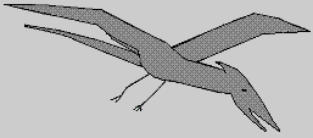
|
|
Figure 11a. A "drawing" that J. Whitcomb misleadingly depicts as a "sketch" by Susan Wooten, allegedly showing what she saw fly by her car in South Carolina in 1989. |

|
|
Figure 11b. Susan Wooten's actual sketch and notes. |
In his 2011 book Live Pterosaurs in America (LPA) and several of his web pages Whitcomb shows what he calls Wooten's "sketch" of the animal. However, it actually appears to be a computer generated digital image (Figure 11a), leading me to question whether it was really Wooten's original sketch. As it turns out, it's not. The original drawing with Wooten's notes beside it are shown by Parker (2018). As the reader can see, it's a rough little sketch (Figure 11b) that looks signifcantly less like a pterosaur than the redrawn version Whitcomb misrepresents as Wooten's sketch, and more compatible with a large bird. Whitcomb writes: "Common sense insists it was a pterosaur" (Whitcomb, 2016b). Actually, it sounds like it is Whitcomb who insists it was a pterosaur, while common sense dictates that the story be taken with a large grain of salt.
Whitcomb states that after Wooten learned of accounts of glowing pterosaurs in Papua New Guinea, she recalled going with friends several times to watch the mysterious "Brigham Lights" or "Ghost Lights" along an old railway and swamp in the nearby community of Brigham, in Dillon, SC. Like similar controversial illuminations reported in other areas, such as Brown Mountain, NC and Marfa TX (discussed below), have been ascribed to many different possible causes, from ghosts and UFOs, to swamp gases, seismic activity, ball lightning, and reflected car lights. However, Whitcomb suggests that they all may be due to "bioluminescent" pterosaurs, having the ability to glow brightly for a few seconds at a time. However, no convincing photos or other empirical evidence demonstrating such a connection (or demonstrating the existence of living pterosaurs, for that matter), has ever been produced (further discussed below).
The third sighting was related by a man identified as "SNW" who saw a "large flying creature" during the day in the San Joaquin Wildlife Sanctuary of Orange Co., CA. According to JW, he described the animal as dark gray or black, about 30 feet long, with about half that being a tail. SNW reportedly did not see any feet, or get a good view of the head, but that it had a triangular-shaped "flange" near the end of the tail. SNW described the wings as having "wrinkles" and not showing feathers, which brings up the same concerns as in the MB sighting--namely, this fits common fictional pterosaurs better than a real one. As far as the alleged long tail and "flange" goes, we're back to the ability of herons and other large birds to foster such an impression (see Figure 6). Whitcomb relates that he subsequently visited the wildlife sanctuary and polled visitors about whether they had seen or heard anything unusual flying there, but reports no promising replies. Nor evidently did any of the many thousands of annual visitors to the park report seeing pterosaurs. Nevertheless, Whitcomb opines that he found SNW's account "credible" and that it "seemed unlikely" to be a hoax, hallucination, or misidentification of any bird or mechanical model. The trouble is, reliable scientific conclusions are not based on subjective evaluations or what "seems" so, but hard evidence.
The fourth account (p. 19-21) is more of a "hearing" than a "sighting" since the witness merely reported being startled by loud "screeching and screaming" sounds outside his house, about 1 a.m. The unnamed man, who at the time was living in Rancho Santa Margarita of CA, said it sounded like "some sort of creature was suffering, or fighting..." in his back yard. He said that when he went outside to investigate the strange and "terrifying" noises, he did not locate the source, but after he went back inside, he formed a mental image of "a large prehistoric bird about 4 feet tall." Remarkably, Whitcomb spends several paragraphs on this story, saying he believes it was "a real encounter," that the man "is credible." He acknowledged that the man did not even see any creature, and that it might "have less value than other reports," but that it "fits into the overall picture of a giant flying creature." He even revisits it later in the book (p. 103), should be considered "secondary evidence" and might someday be useful in some research." One can hardly imagine a more severe example of "confirmation bias." Obviously, even if the man's account were 100% true, the sounds could have come from any number of animals, including cats, raccoons, or other common animals fighting or mating, or even a large bird, as the video-taped heron in distress discussed below shows. Besides that, no one knows what kind of sounds pterosaurs made. In short, the account is not just weak or "secondary" evidence for living pterosaurs as Whitcomb implies; it is zero evidence.
In an on-line essay entitled "Science and the Marfa Lights," originally written by Norman Huntington (one of Whitcomb's pen names), Whitcomb repeatedly refers to himself in the third person as he endorses his own conclusions that the lights are primarily due to bat-hunting pterosaurs (Whitcomb, 2010e). He back-hands those who disagree or who question his objectivity as "shallow minded critics," but as usual, neglects to properly cite their writings. On another web page (Whitcomb, 2010f), and his 2011 LPA book, he gives more coverage to the issue, discussing the research of Edson Hendricks, who concludes that most of the lights are due to atmospheric phenomena, and an eight-year study by James Bunnell, who agrees with other workers that most are due to a variety of inorganic and mostly mundane causes (Bunnell, 2009). Whitcomb acknowledges that he is new to the subject and that most of what he knows about it he learned from these men. Nevertheless, he criticizes them for not accepting his interpretation, and challenges Bunnell's specific objections to it. For example, when Bunnell pointed out in an email that the lights sometimes last for three hours in one place, and that one grew to an enormous size that lit up the clouds, Whitcomb suggested that this is due to "many ropens" gathering together in a competitive "courtship ritual," glowing as brightly and for as long as possible, and making a circle "more than a hundred meters in diameter" (Whitcomb, 2011, p. 86).
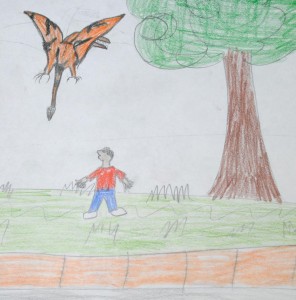
|
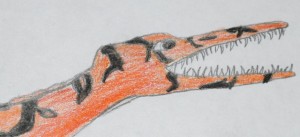
|
|
Figure 11b (top), 11c (bottom). Drawings attributed to Aaron Tullock An 8 year-old boy at the time |
Whitcomb also relates several pterosaur sightings from Texas apart from the Marfa Lights, most of which are not appreciably different than others from other states. However, one that Whitcomb showcases on two web pages (Whitcomb, 2010g, 2010h) might be worth relating. Whitcomb states that a young man named from Aaron Tullock, of Marion Co. Texas, was in his grandparent's yard one afternoon in 1995 (as a boy of 8 years old) when something flew over his head and hovered eight feet above the ground. The creature reportedly had a wingspan of 4 1/2 to 5 feet, a long diamond-tipped tail, crocodile-like teeth, long claws like an Osprey, and "orange and black" color with "tiger stripes." Despite the fact that the event took place 15 years earlier, when Aaron was just a young boy, that the creature's colors did not matching any other accounts from Texas or anywhere else, and that the "long claws" and "hairless" body do not match fossil pterosaurs (which had small claws and hair-like coverings), Whitcomb stated that the details of the story establish the boy's credibility and ruled out a hoax, so that he concluded, "What's left except Rhamphorhynchoid pterosaur?" What's left, I suggest, is that children (even more than adults) often perceive, remember, and report things inaccurately. No offense to Aaron, but as we all know, it's common for children to exaggerate or fabricate things, and to be heavily influenced by things they see in books, comics, TV shows, and movies. Whitcomb mentions, but also seems to disregard, the fact that the boy's own mother dismissed Aaron's story as a product of his imagination. As with many other sightings, Whitcomb seems to reduce his credibility assessment to a simplistic dichotomy of 'hoax vs real pterosaur' or 'hallucination vs pterosaur,' while neglecting or minimizing more common possibilities and factors.
Figures 11b and 11c show drawings attributed to Tullock. I notice that the pterosaur in 11b seems to be drawn considerably darker and with advanced perspective (overlapping body parts and such), than the lighter-toned and perspective-lacking rest of the drawing, which might suggest more than one artist (or time frame?) was involved.
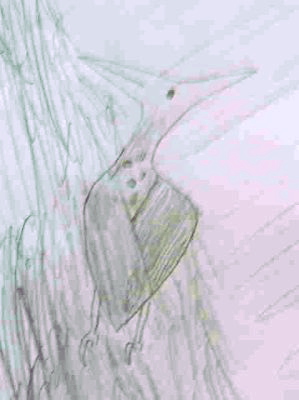
|
|
Figure 12a. Drawing by Phillip O'Donnell (an 11 year-old boy at the time) |
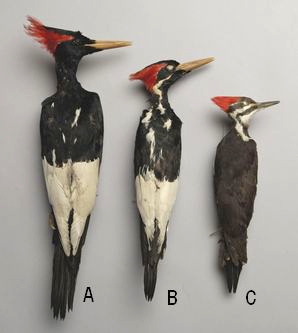
|
|
Figure 12b A. Greater Imperial Woodpecker (male) B. Ivory-billed Woodpecker C. Pileated Woodpecker |
"My name is Phillip O'Donnell. We live in Oregon. I really enjoy this website. The info about living dinosaurs is great! I just thought that you might like to know that in 2003 my brother and I saw a strange bird. It was perched in a tree for about 1 minute. It was about three feet tall with a white chest and black spots. I looked at through the binoculars and so did my brother. It had a horn-like thing protruding out of the back of it's head that was pointing upwards and was not like a heron's tuff of hair. As it flew away we guessed the wingspan to be about 9 feet... The wings were long and pointy. It returned the next year and we saw it in the same field. The sighting only lasted about 5 seconds. We briefly saw a long and very large pair of wings that had red streaks on them." Here is my sketch. Please note that the body is not the right size compared to the head."
Taylor calls this a "Possible pterosaur sighting" but it is likely that O'Donnell saw a bird. Not only did he call it a bird, but if we allow that the "horn-like" thing could be a bird's crest, then both the description and drawing (Figure 12a) seem to match a bird, especially a large woodpecker (Figure 12b), better than a pterosaur. Granted, he said the crest was not-heron like, but even if we can trust a boy's memory, woodpecker crests are proportionally larger and more robust than heron crests. Likewise, if he somewhat overestimated the size (as is often done by adults let alone children), it could have been a common Pileated woodpecker. The red crest might have been mistaken (or misremembered) as red on the wings during flight. Other candidates include an Ivory Billed woodpecker, but that is probably less likely, since they have been on decline and rarely seen in recent decades; some think they may be extinct, or went extinct around the time of O'Donnell's sighting. Dale Drinnon suggests he could even have seen the even larger Greater-Imperial Woodpecker, up to 2 feet long (Drinnon, 2011). Although once widespread in America, it declined sharply after 1950, and many think that it too may have gone extinct in recent decades, despite occasional reports into the 1990's. At any rate, it seems far more plausible to surmise that Donnell saw a large woodpecker or other crested bird (even a very rare one that may now be extinct) than a pterosaur whose last confirmed remains are 65 million years old.
Three years after his sighting, while still a teenager, O'Donnell wrote a short book entitled Dinosaurs: Dead or Alive?
promoting his YEC views and existence of modern pterosaurs and dinosaurs (O'Donnell, 2006). Interestingly, O'Donnell's book, which
is endorsed by Whitcomb, does not mention his own sighting above. It does relate many others that are even more questionable, including
a supposed 15 foot bipedal lizard reported in Milton, OK, small T. rex-like dinosaurs in Colorado, a 25 foot tall reptile along the
"Gulf Coast," a "Troodon"-like dinosaur in Texas, and other supposed dinosaurs and pterosaurs in other countries (including some
of the same ones Whitcomb describes). O'Donnell also promotes (without citations) several alleged out-of-place fossils and
artifacts, including an alleged shoeprint in an Triassic rock, a supposed sandal print with squashed trilobite, and a supposed Cretaceous
hammer, which were were well rebutted long ago (Kuban, 1997, 1998, 2006), and are not supported even by most YECs. Although some
leeway might be allowed for the author's age, O'Donnell is now in his twenties, and still sells the book. It does include a
bibliography, indicating that O'Donnell mainly consulted YEC books and websites, including those of Carl Baugh and Kent Hovind, who have
long histories of unfounded claims, and from whom even most YEC groups distance themselves.
Sightings in Other Countries
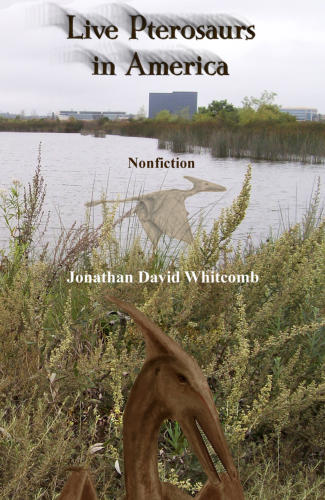
|
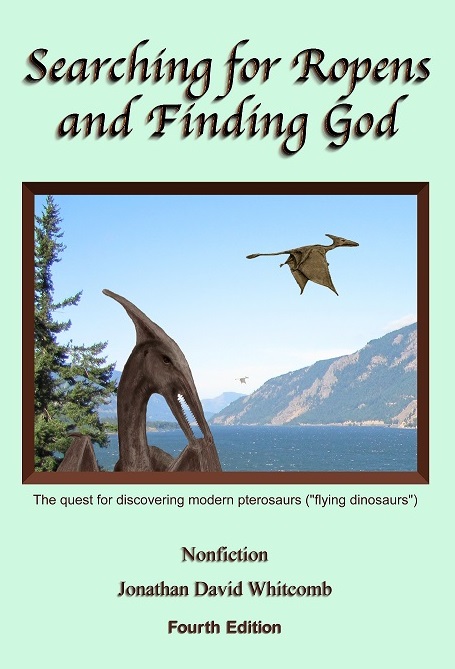
|
|
Figure 13. Covers of Whitcomb's books Live Pterosaurs in America, 2011 (top) and Searching for Ropens and Finding God 4th ed., 2014 (bottom) |
While Eskin seems to describe at least one uniquely pterosaur-like feature (tiny fingers not part of the wing), it's doubtful he could see such details, let alone "vertebrae in the back," at a height of over 100 feet. I say over 100 feet, because Eskin implies the creatures were seen at an angle (looking toward the ocean) rather than directly overhead, meaning that their distance from him would have been far greater than 100 feet --perhaps several hundred feet or more. One might argue that he might still have been able to see bat-like "struts" in the wings from such a distance; unfortunately it does not help the credibility of the account, since pterosaurs did not have bat-like "struts" in their wings. Each membrane on a pterosaur wing extended along a single highly-elongated finger (see Figure 32).
Eskin reportedly drew the sketch (figure 7) that Whitcomb often uses as a symbol of a typical modern pterosaur on his web pages and book covers. Curiously, the sketch curiously does not show the reported "bat-like struts." It does shows a large, posterior head crest and a long diamond-tipped tail, but neither are mentioned in the quoted account, nor is that combination of features found on any real pterosaur fossils (just cartoons and other fictional pterosaurs).
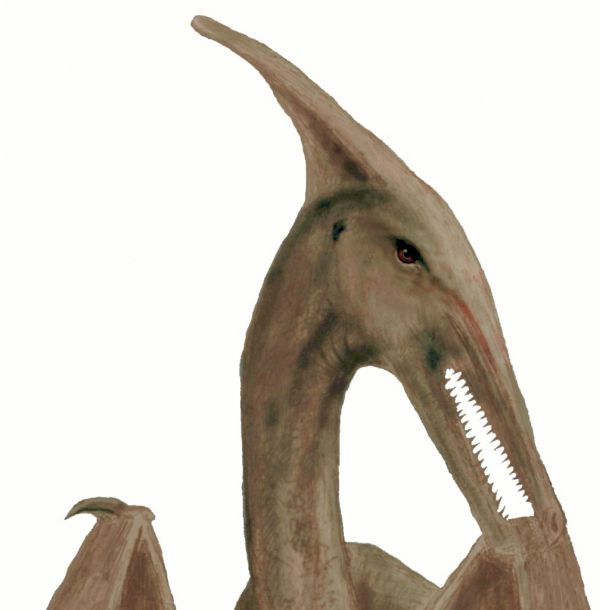
|
|
Figure 14. Patty Carson's drawing of the "Gitmo Pterosaur |
In order to take the account at face value, we have to trust that as a child, Carson could discern details such as the size and color of the eye on a creature moving quickly and only in her sight briefly, then recall them accurately 46 years later. Her mentioning the leathery skin (not matching real pterosaur skin) also undermines the plausibility of the account.
A follow-up article posted by Whitcomb in August 2011 discussed a "preliminary drawing" that Carson made of the creature, but noted that Patty was not satisfied with the eye and other aspects. He also noted that it contained some discrepancies between it and the pterosaurs described by Eskin at a nearby location. Whitcomb wrote: I don't want to publish the preliminary sketch of the pterosaur, for it may lead to some people believing it to be very accurate in its present form (Whitcomb, 2011d)." Whitcomb later published a revised drawing (Figure 14) by her, said to contain "many modifications" (what they were, he did not say). It exhibits a large, posterior, Pteranodon-like head crest and jaw filled with tiny teeth (almost like a porpoise), even though no known pterosaurs had both (Pteranodons were toothless). Whitcomb states, "She is still not satisfied with the sketch, in particular with the mouth and where it connects with the skull, but she likes the eye and sketch" (Whitcomb 2011e). Unfortunately, the eye appears quite different (lacking a vertical slit) that Whitcomb claims helps authenticate a "Ptp" Civil War photo of a Pteranodon carcass (discussed later). Whitcomb subsequently used Carson's revised drawing on many web pages and on his book covers. It shows only the head and upper parts of the creature's shoulders and wings, although it's unclear whether this is because that's all her drawing showed, or because he cropped out the rest.
The drawing appears to show a single bat-like claw on one of the wings, even though real pterosaurs had three small claw-bearing fingers on each wing. One could argue she might miss such details, but if so, one might ask how we can then trust details such as the eye and teeth, especially considering her many "modifications" and her having to recall what she saw as a child over 40 years earlier. The latter alone is a major concern, in view of the evidence discussed earlier regarding the tendency of memories to change with time, and for childhood memories to be especially unreliable. Speaking of which, Whitcomb mentions that Patty's brother "came forward" to say that a year after his sister's sighting he saw a creature flying at about 100 ft that was grayish-tan in color. Whitcomb relates that he could not be sure if it had feathers or not, or if it was the same kind of creature his sister had seen (Whitcomb, 2011e). He argues that his admitting being unsure of such details makes his report credible, but that point is as moot as the account itself, since there is nothing about it to rule out a large bird, even if his childhood memory were reliable.
Whitcomb used Carson's drawing along with Eskin's on the covers of his 2011 and 2014 books (Figure 13), and often displays them together as icons of typical modern pterosaurs on many of his web pages. On the cover of his latest book (2017) he instead uses the what he believes to be a genuine Civil War era photo of a real pterosaur carcass (discussed later). The 2011 cover (Figure 13, top) shows the two pterosaur drawings superimposed along a lake shore, with modern buildings in the background. Evidently to Whitcomb this is not an unrealistic scenario. However, if pterosaurs are really romping and soaring around even developed and densely populated areas, it underscores the difficulty of explaining why no convincing photos of them have ever come to light.
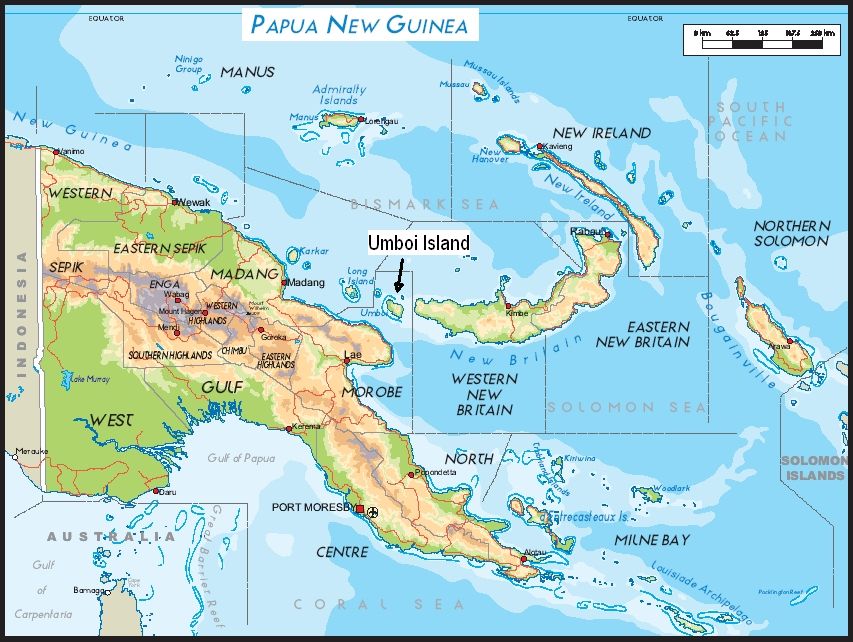
|
|
Fig. 15. Papua New Guinea map showing Umboi Island and New Britain |
Papua New Guinea (PNG) is a country occupying the eastern half of the island of New Guinea, north of Australia. Several young-Earth proponents, including Jonathan Whitcomb, David Woetzel, Carl Baugh, Paul Nation, and Garth Guessman have led or participated in expeditions to PNG and nearby islands in hopes of confirming reports of living pterosaurs, and relating them to local legendary creatures or beings called "Ropens" (sometimes translated as "demon fliers"). Other legendary creatures called "Dah" or "Duwas" by other locals in or around PNG are suggested by some to be the same as Ropens. Although often downplayed by Whitcomb and associates, these legends entail various spiritual and demonic elements. Evidently many locals do not even associate them with physical creatures. Some apparently believe they represent some sort of supernatural beings or human/beast hybrids--perhaps even vampires. Some stories say they have a taste for human flesh and sometimes rob graves (though supposedly they ceased doing this in recent years), and occasionally attack and carry off natives.
Whitcomb and associates attempt to link these legends to "sightings" of living pterosaurs, as well as to unusual nocturnal lights sometimes called "Indava" by natives. However, the mysterious lights, which are similar to others reported at dozens of locations worldwide, are considered by others to be a largely separate phenomenon, with no reliable connection to "Ropens" or living pterosaurs.
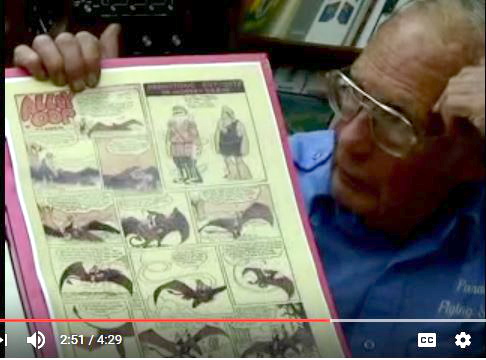
|
|
Fig. 16. Duane Hodgkinson comparing his 1944 PNG sighting to the pterosaur in an Alley Oop comic book |
Whitcomb who communicated with Hodgkinson by phone and email, as related Chapter 3 of in his 2017 book Searching For Ropens and Finding God. argues that this PNG sighting is one of the most credible. However, he acknowledges that Hodgkinson's friend and fellow witness to the incident was a biologist, and denies that they ever saw a pterosaur. Whitcomb speculates that this is because the friend was either distracted by wandering thoughts about teaching, or because a living pterosaur would "drop a bomb" on standard biology." He writes (p. 28). "George [the friend] should have been in a mood to learn something, yet it seems that his mind was set on teaching..." However, neither is sound. First, the distraction idea is contradicted by the fact that Hodgkinson himself indicates during the interview both he and his friend had their attention drawn to commotion in the brush and the creature causing it, and that during the incident they discussed what the creature could be. The second idea is contradicted by the fact that, as discussed earlier, whenever "living fossils" have been found before, scientists have gladly reported and widely celebrated them. In short, Whitcomb displays a large degree of confirmation bias here, by fully trusting Hodgkinson's word and memory, while dismissing without basis the testimony of his more scientifically knowledgeable friend. Excerpts from Guessman's video-taped 2005 interview, posted by Whitcomb, are available on-line at a number of sites, including https://www.youtube.com/watch?v=dl1A2xXnxpU
The video includes subtitles and comments, but never mentions the friend or his denial, despite it's obvious relevance. Likewise, although Whitcomb notes the friend's denial in another book (LPA), he says that the friend was a biology student rather than biologist, and makes no speculations about thoughts of teaching; instead he dismisses the friend's denial due to "dogmatic" views about extinction. On several web pages, including one called "American Soldier Sees Pterodactyl," and in his latest book Modern Pterosaurs (2017) Whitcomb not only fails to mention the friend's denial, and instead implies that both men saw a pterosaur. Unfortunately, this situation, combined with is misleading depiction of Susan Wooten's "sketch" discussed earlier, makes it difficult to trust that Whitcomb fully and fairly relates all relevant information in the sightings he recounts, even aside from other uncertainties inherent in most witnesses' perceptions, recollections and descriptions. This is not to suggest that Whitcomb is routinely deceptive or dishonest, but his obvious passion and YEC inspired drive to prove the existence of living pterosaurs may foster less than objective reporting, and considerable confirmation bias in his perceptions. Reinforcing this impression is that in criticizing this critique, he paints my above depiction of this account as erroneous and misleading, even though it is based on his own statements (see Appendix D).
Whitcomb complains that skeptics often do not adequately explain Hodgkinson's having seen a long tail on the creature. However, Hodgkinson himself says on the video that he did not get a good look at the tail. Whitcomb says he too initially thought that no tail was seen, but says Hodgkinson later estimated the tail to be ten to fifteen feet long. However, besides these inconsistencies, we are dealing with a decades-old recollection, for a moving creature (where size is difficult to judge), and where a co-witness denies any pterosaur was seen.
When David Woetzel (1999-2017a) relates the sighting, he too neglects to mention the friend's denial. Woetzel only briefly states that Hodgkinson recalls that the creature had "dark-gray coloration, long serpentine neck, beak, and distinctive head crest". Evidently Woetzel added the term "serpentine" since during the taped interview, Hodgkinson only mentions a "long neck."
Interestingly, during the taped interview, Hodgkinson holds up an Alley-Oop comic book, which he says reminded him of the creature (Figure 16). The page displayed shows a pterosaur with a Pteranodon-like head crest and long tail, even though as explained earlier, no fossil pterosaurs show this combination. One wonders if Hodgkinson may have been reading such comics before or during the war, possibly influencing his perceptions or recollections.
Evidently realizing that the account involved a lot of uncertainty and could well be compatible with a heron or other crested bird, Whitcomb asks, "Could this have been strange large bird with feathers not easily visible?" However, instead of answering "yes," as would have been appropriate, he remarks, "That 'horn' and long tail suggests a ropen or at least a large flying creature similar to the one seen by Hodgkinson." Evidently lost on Whitcomb was the possibility that Hodgkinson too saw a large bird, especially since the friend Hodgkinson was with denied that they saw a pterosaur. In fact, Whitcomb seems to deliberately set up a misleading straw man at this point by stating, "Neither of these men were along during the sightings: similar hallucinations are even less likely." Besides no one ever accusing the men of hallucinations, Whitcomb is clearly implying here that people with both witnesses supported their interpretations. However, the very opposite is true in the case of Hodgkinson's friend, and we have no information about whoever was with Hennessy, or what they saw or concluded.
In his 2014 book Whitcomb says he showed Hennessy some head profiles to choose from (which seems somewhat leading). Whitcomb says that Hennessy picked his 2006 composite head as being "similar," but that Hennessy added that he "could not see any detail." Considering that admission, that he could not discern whether it had feathers, and that Hennessy himself questioned the accuracy of his memory from 2 decades earlier (as any competent psychiatrist would), the sighting seems weak at best, despite Whitcomb often showcasing it, and scolding any skeptic who leaves it out (Whitcomb, 2015).
Carl Baugh who runs the "Creation Evidence Museum" in Glen Rose, Texas and who has a long history of unfounded claims about ancient human tracks and other matters (Kuban, 2017), states on his website that CEM has sponsored PNG expeditions in 1994 and 1996, and that these excursions resulted in nocturnal, eyewitness sightings of "bioluminescent pterosaurs." Baugh notes that nationals and missionaries in the area describe "flying reptiles with wingspans up to 25' across," known to many locals as "ropens," which have the habit of "scavenging gravesites for food." Baugh's site gives no names of witnesses or photos of the alleged creatures.
Whitcomb relates that Baugh told him in a phone call about a crippled old man with cancer in PNG was attacked by one of the creatures in 1995. Baugh reportedly said that the creature carried the man into the air and dropped him three separate times, before being finally carrying him off and eating him. Apparently taking the sensational hearsay story seriously, despite it's unreliable source, Whitcomb remarks, "It sounded like a dragon story but with the feeling of reality, and recounts other stories about people being carried off by Ropens (Whitcomb, 2014, p. 17). He even suggests some "missing person" reports in Canada and the U.S. may be due to pterosaur snatchings. Such legends and wild speculations may be consistent with cartoons and Hollywood films like One Million Years B.C. and Jurassic Park, but contradict what is known about pterosaur anatomy. Fossils indicate that pterosaurs, even ones the size of the larger "Ropens," did not have strong grasping feet capable of picking up people or large animals. Rather they had very slender, weakly-muscled feet with non-opposable digits (Naish, 2017).

|
|
Figure 17a. Photo of "lights" taken by Paul Nation. From D. Woetzel website |
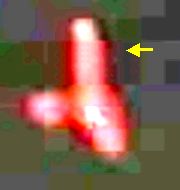
|
|
Figure 17b. Color-enhanced lights reportedly photographed in the Yakima Forest near Spokane, WA. Clifford Paiva suggests they were produced by a glowing pterosaur, with the yellow arrow pointing to the creature's supposed head crest. |
Paiva's original report seems to be unavailable and apparently was never published in print. What is posted on-line is an abridged version that (as a subtitle indicates) was "edited, simplified, and explained by Jonathan Whitcomb." In one of annotated sections Whitcomb states "Paul Nation videotaped two lights that we believe are the bioluminescent glow of creatures very similar to the ropen of Umboi Island" without making clear who "we" is, or whether both report authors concur. On his own web pages Paiva (2014, 2017a) uses other dubious images to promote other sensational claims. Although in most cases he gives no details about when, how, or by whom the photos or videos were taken, the captions and brief desciptions associated with several imply that they show flying or glowing pterosaurs in Washington state and other locations (Figure 17b), but the images are best described as ambiguous blobs. Elsewhere (Parker, 2018) he suggests videos of some vague shapes in San Francisco bay probably represents a 170 foot long sea snake or a prehistoric Elasmosaur, even though most conventional researchers say the video is too indistinct to reliably diagnose and could be due to any number of more prosaic phenomena (Skeptics Forum, 2005). He argues that an ambiguous shape on Mt. Ararat is Noah's Ark, a proposition rejected even by most YEC groups, including AIG (Chaffey, 2016). On various web pages Paiva devoted to conspiracy theories, he also shows questionable photos and videos allegedly showing that the Boston Marathon Bombing and 911 disaster were staged by federal or local government agencies (Paiva, 2014), despite clear evidence to the contrary. I mention these things not disparage Paiva, but to illustrate that he seems to have a tendency to overinterpret and misinterpret ambiguous images. This is relevant not just to the "glowing pterosaur" claims, but also his recent promotions of a supposed "Civil War" photograph, which he and Whitcomb claim to be proof of modern pterosaurs (more on that later).
Whitcomb concludes that the consensus of local witnesses indicates a single, primarily nocturnal rhamphorhynchoid pterosaur species with a long tail and large head crest, having a wing span of 20 to 25 feet, which often uses bioluminescent lights while flying and fishing. He notes that the term "Ropen" is mainly used by people on the PNG island of Umboi, "where in the local language of Kovai it refers to a large nocturnal flying creature that on occasion, and briefly, it "glows brightly." He explains that other native PNG languages appear to have different names for the same or similar creatures, including "Indava", used on the PNG mainland, "Kor," on islands north or Umboi, "Duwas," in other areas on or near Umboi, "seklo-bali," in or around Wau of Morobe Province, and "wawanar", in areas near Pilio Island, off the coast of New Britain Island (Whitcomb, 2015b). However, there seems to be a major inconsistency in his argument for one species, since various witnesses report a short tailed pterosaur, and others a long tailed pterosaur, so if all of their testimonies are credible as Whitcomb repeatedly claims, it implies at least two PNG species (as suggested by Woetzel and other LP advocates).
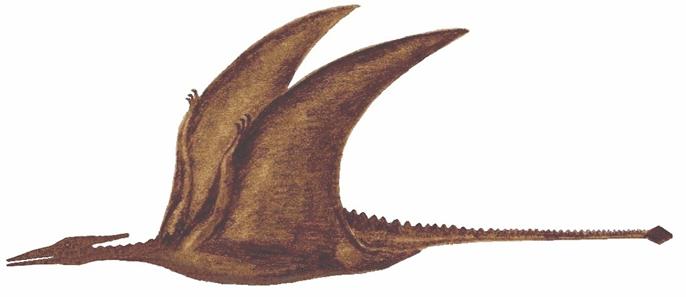
|
|
Figure 18. Composite Ropen drawing, by Whitcomb and Guessman. Compare to composite drawing by Woetzel below |
In 2006 Whitcomb posted a "composite drawing" that he says he an Guessman produced (Figure 18). Interestingly, it differs significantly from the composite drawing by Woetzel (Figure 20a), especially in regards to the head. Whitcomb shows a chart listing various features from several PNG witnesses that were evidently used to produce the composite drawing. Curiously, however, the drawing does not appear to show any legs or feet. In the chart, the only mention of feet is "Feet (tucked in) Hodgkinson". However, in the 2005 interview video, at least the excepts posted on line, Hodgkinson does not mention seeing legs or feet. So, it seems that few if any witnesses saw legs or feet. That seems to lend credence to the possibility that some witnesses may have mistaken the rearward extended legs and feet of a large heron or egret in flight (Figures 6a, 6b) for a Rhamphorhynchoid pterosaur tail.
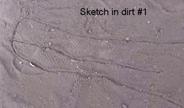
|
|
Figure 19a. Drawing shown on Whitcomb's web page "Is the Ropen a Pterosaur" implied to be a drawing by local Gideon Koro, but evidently just the snout part of the head, drawn by Whitcomb himself. |
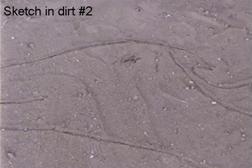
|
|
Figure 19b. Back part of head drawn by J Whitcomb onto which Gideon Koro reportedly added his drawing |
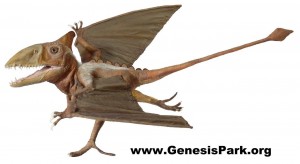
|
|
Fig. 20a. Woetzel's "composite drawing" of a Ropen |
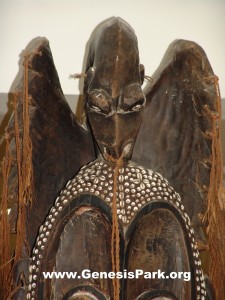
|
|
Fig. 20b. Statue shown by D Woetzel with no obvious link to pterosaurs |
At one point the translator said "He did not show his head," presumably referring to the creature. However, Whitcomb then asks Gideon, "so you did not see the head well," as if encouraging him to say he saw the head to some extent, right after the translator indicated that he did not see the head. Whitcomb then asks Gideon what the mouth was like, again disregarding the translator's statement. Gideon replied "like a crocodile." Whitcomb then used a machete to draw two animal heads in the sand -one supposedly crocodile like and the other pterosaur like, even though they look very similar. Gideon picked the latter, and then scratched in the rest of the creature in the sand. The drawing shows bat-like wings about the same size as the head, bumps on the neck and body, and a long tail without a vane.
Evidently realizing that the drawing did not much resemble what a Ropen is supposed to look like, Whitcomb remarks that the drawing is "not visually accurate as he [Gideon] is not a realistic artist," later adding that neither is he. That seems true, but if so, it largely undermines the drawing's value, even aside from the fact that drawing the head for Gideon was not proper or objective. It also seems curious that Whitcomb would not think to bring some paper and pencil along, or if he did, would not use it in a situation like this, and invite witnesses to do the same, instead of making crude scrawlings in the sand.
A photo of the drawing appears on p. 83 of SFG, but parts of the sketch is cropped of the photo on all sides, and it is a dull, low-contrast photo, making its details difficult to discern. Two of Whitcomb's websites show parts of what is implied to be Gideon's drawing, but each shows only part of the head, which again, was drawn by Whitcomb rather than Gideon. One appears to show the end of the snout (Figure 19a), and the other the back part of the head (Figure 19b). A You Tube video of the interview (Whitcomb, 2013a) also doesn't show the entire drawing, just parts of it. Curiously, none of them, even the head that Whitcomb himself drew, look much like the corresponding parts of a real pterosaur, or Whitcomb's iconic Ropen images (Figures 7a and 18).
The same video includes comments by two other locals who supposedly saw ropens: Mesa Augustin and Gideon's brother, Wesley Koro. However, all they say is that the tail had a "diamond" on it. In Whitcomb's 2014 book, he says that he also asked them, while they were together and with Gideon, whether they saw what Gideon saw, and they nodded yes. However, he says that they Mesa looked frightened and Wesley nervous, and admits that he should not have interviewed all three together, so that they would not influence each other's answers. One must also consider that PNG locals may have been influenced by previous exposures to American ropen seekers, and thus possibly tailored or slanted their stories accordingly. In view of these problems, the discrepancies from the 1994 interview, and the language difficulties, it's hard to know exactly what Gideon actually said and meant in each interview, let alone what he and the others actually saw. Whitcomb's warns on one of his web pages: "Beware of critics who ignore eyewitnesses such as the natives Gideon Koro, Mesa Augustin, and Wesley Koro" (Whitcomb, 2013b). I'm glad to address them; however, Whitcomb's warning seems largely moot, since interviews seem far from objective or convincing.
David Woetzel has a website called "Genesis Park" where he recounts his 2004 PNG expedition with Guessman. Besides the witness interviews mentioned above, Woetzel related his own sighting of "a possible Ropen" on Umboi Island, which he described as "a large, yellowish glow approximately 20-25% the size of the full moon which was observed to fly behind one of the volcanic peaks. The light left no trail and it twinkled around the edges. The whole sighting lasted for only a few seconds." Whitcomb commented on one of his websites that "This may be the best sighting on this island by a westerner in years." If so, it is not saying much, since Woetzel confirmed that all he saw was brief light, no shape or bodily form (Woetzel, 1999-2017).
Woetzel states that during a PNG expedition with Carl E. Baugh, missionary Jim Blume "observed one of the creatures through a monocular night scope and snapped a picture of a strange print in the sand the next morning." However, neither Baugh's nor Woetzel's web sites show the photo in question.
Woetzel's website once reported that a female missionary pilot experienced a "near miss" with the creature in the mid 1980's, and that she "took a fascinating picture of the Ropen off the wing of her plane while flying near Mt. Barik." However, he showed no picture, nor explained what happened to it. More recently Woetzel related that upon doing more research, he concluded that the pilot was not credible, and deleted the questionable account.
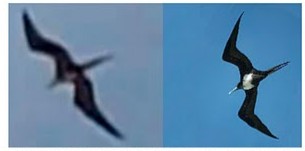
|
|
Figure 21. Screen capture of alleged video of pterosaur from Papua New Guinea (left) and a female frigate bird (right) |
The overall credibility of Woetzel's site is not helped his promotion of a "Japanese plesiosaur" carcass, which years ago was conclusively demonstrated to be a decayed basking shark (Kuban, 1997), after which virtually all other YECs stopped promoting the case. AIG, one of most prominent YEC groups, recommends that no one use the case as anti-evolutionary evidence (Mitchel, 2010).
A Salem-News.com article (Aym, 2010) describes Woetzel's more recent PNG expeditions, includes a photo still from a video, with the caption, "Amazing amateur daylight video of a 'Ropen' (Dimorphodon pterosaur) hunting for fish off a Papua New Guinea beach." Unfortunately, when one compares a silhouette of a frigate bird in flight with a screen capture from the video (Figure 21), it's clear that the animal in question is a bird, not a pterosaur. What's unclear is where the video came from. I have not been able to reach the author, and Woetzel related in personal communication (2017) that it did not come from him. In 2012 Aym posted a similar article entitled "Stunning Evidence of Living Pterodactyls" that omitted the video in question (Aym, 2012).
Whitcomb seemed less pleased with a 2009 production by Monster Quest, which produces similar paranormal/cryptozoology TV programs. Their crew trekked to New Britain Island in PNG to investigate the "Ropen" claims, and featured the topic in their June 2009 (Season 3) episode 15 on the History channel. The show included excerpts from interviews with Garth Guessman and Duane Hodgkinson, as well as comments from a professional paleontologist. Whitcomb (2017) was unhappy that the animation that accompanied the program showed a short-tailed pterosaur instead of a long-tailed one like his composite drawing. The objection seemed questionable, since he himself suggests, based on witness statements, that some pterosaurs in PNG and elsewhere are short tailed. In fact, on his own web page entitled "What is a Ropen" (2004-2014) he shows two pterosaur drawings at the top (one on each side) one of which has a short tail, and the other a long tail (Figure 10).
Whitcomb also objected that the program mentioned the fruit-bat as a possible source of some sightings, and expressed even more displeasure that the program showed the paleontologist stating that he felt the chances of an extant pterosaur were only about one in one hundred million. Whitcomb went on for several paragraphs about how biased and unfair this was, and how in view of this a paleontologist would be "the last person on earth" he would choose to go on a PNG expedition.
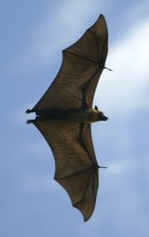
| |
|
Figure 22. "Flying Fox" (large fruit bat) in flight | |
Whitcomb, Baugh, and others insist that the PNG locals are well aware of fruit bats and would have no trouble distinguishing them from pterosaurs. However, this seems less certain when the animals are viewed from a distance, and as discussed earlier, various birds in flight, can also present an even more pterosaur-like appearance. Their tails and rear leg lengths vary considerably, but so did the legs and tails of pterosaurs. Moreover, some "Ropen" reports or other alleged sightings of LPs elsewhere do not mention tails, or refer to short tails. There is a fruit bat called the Long-Tailed fruit bat or Long-tailed Blossom bat, that has a fair sized tail. It is mostly known from areas farther east in the Pacific (mostly Fiji and nearby islands), but the possibility that this bat or one like it (perhaps with an even longer tail) exists in PNG, and the ability of large bats or birds to be construed by some witnesses as "Ropens" seems more reasonable than positing an extant pterosaur. Indeed, as discussed below, the word for bat evidently translates as "bird" or "bat" in some PNG dialects (CreationWiki, 2015).
Of course, no bats are known to be bioluminescent. However, the linkage of pterosaurs to the mysterious lights seems tenuous, since only a few people have claimed to see even vague bodily forms with the lights. Whitcomb (2014, p. 280) states that some owls are reported to be luminescent, and even claims that they may be bioluminescent (capable of generating their own luminescence) based on the writings of Fred Silock. However, if this were verified, it would seem to undermine more than help Whitcomb's case, since it would mean that if the mystery lights in PNG and elsewhere are related to any flying animals, they need not be bioluminescent pterosaurs. Indeed, Silock himself suggests that the controversial "Min Min" lights in Australia and other areas may be related to glowing owls (Silock, 2016).
As to the possible mechanism for the supposed bioluminescence in Ropens, Whitcomb (2014, p. 94) states that PNG missionary James Blume who suggested that it may "related to secretions that seem to drip from the creatures as they fly, like "sparklers" falling to the ground. Apparently he got that idea from a sketchy reported sighting by PNG local Jacob Kepas when he was 12 years old, and caught a "brief glimpse" of the back and tail of a Ropen or "seklo-bali" (Whitcomb, 2014, p. 94).
Although the reported size of many pterosaurs in PNG and elsewhere often exceeds any known birds, as mentioned earlier, people are notoriously poor at an objects estimating size, especially at a distance or in the sky. Furthermore, the larger the creature, the more difficult it is to explain why they are not seen more often and regularly photographed (discussed further below). Incidentally, although a small portion of pterosaurs grew to immense sizes (with wingspans over 30 ft). People are used to seeing pterosaurs in movies and fictional books carrying off animals or people, but the vast majority of pterosaurs species were much smaller, with many only the size of modern cranes or turkeys, and some as small as crows.
Speaking of birds, while discussing Kepas and his fleeting "sighting," Whitcomb mentions that Kepas was surprised that Whitcomb used the term "Ropen" rather than "Seklo-bali," since in Kepas's language "Ropen" means "bird". This seems like a very relevant piece of information, yet Whitcomb and other living pterosaur hardly ever mention it. Likewise, in an article on "Ropens" at "CreationWiki" website, the authors note that several different words in PNG may refer to the same creature, but due to the complexities of the many languages and dialects in the area, sorting them out is challenging. They then state (emphasis mine):
For example, "ropen" near Wau (mainland P.N.G.) means "bird." The same word (ropen) in another areaWell, there you have it, from a YEC source no less. Whereas Whitcomb often ridicules "skeptics" for suggesting that many "ropen" sightings could be large birds or bats, evidently in at least some parts of PNG the very term "ropen" translates as "bird" or "bat". That does not mean every sighting is a bird or bat, but added to the uncertainties and variations in "eyewitness" reports, and potential influences or confusion with elements of various Ropen legends, it does seem to increase reasons to doubt that any sightings are actually modern pterosaurs. Whitcomb himself indicates that about 90% of the sightings are just of the unusual lights, which again, may have little if any relation to real creatures, let alone living pterosaurs.
of the mainland, refers to the giant fruit bat that English speakers call the Flying Fox (CreationWiki, 2015).
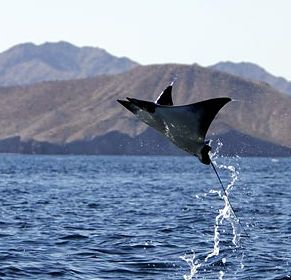
|
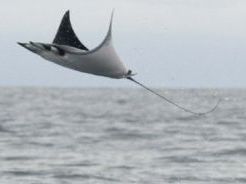
| |
|
Figure 23. Manta rays leaping and soaring | ||
Of course, Whitcomb and associates can continue to say that none of the alternative explanations work, because this and that sighting had 'this and that' feature, or such and such sighting is not consistent with a bird or bat or manta ray, etc. However, that approach presumes the complete accuracy of all witness perceptions, memories, and statements, which again, are subject to all the uncertainties and complicating factors discussed earlier. When they are all considered, it is usually impossible to know exactly what if anything each witness saw.
This comes back to the issue of who has the burden of proof. Skeptics do not have to demonstrate exactly what was seen in each case, or what "Ropens" really are, or even provide reasonable possibilities (though the latter has been done), since they are not the ones making extraordinary claims. The living pterosaur advocates are making extraordinary claims, so they do have the burden to provide the extraordinary evidence (at least compelling photos, and preferably, physical evidence).
Whitcomb next relates a sighting from a twelve year old boy from a farm near Redcliffe, who said that while doing his chores, he was frightened by a large winged creature on the roof, about the size of a man. Whitcomb says the wings were folded to the side and back, "reminiscent of bat wings," but as is often the case when Whitcomb recounts sightings, it is unclear whether these were the boy's own words (Whitcomb does not put them in quotation marks), or Whitcomb's interpretation or paraphrasing. At any rate, Whitcomb does even say that the boy himself thought he saw a pterosaur, and in view of the boy's age, plus the scant and ambiguous information given, there is no reason to conclude that he did.
Whitcomb's third account is from a man from S. Australia who reported seeing what he first thought was a large pelican about 5 km away about 9 pm, but and that when seen by "moonlight" it appeared to be shinning "as if it had no feathers." Whitcomb says the man then searched online for "pterodactyl", and found one of his web pages. The only problem is, if this account demonstrates anything, it is how prone some "witnesses" are to jump to the conclusions, and how eager Whitcomb is to endorse their leap, or make his own longer one. He concludes "I have no doubt about his honesty little doubt that it was a giant ropen." Evidently he did not even consider that the man could be entirely honest, but if he made a mistaken ID, entirely wrong.
The fourth Australian sighting Whitcomb discusses was made by two pilots on a flight from Australia to Indonesia, who at an altitude of about 6500 feet above the sea, reported seeing what they thought was a small dark plane coming at them, but then realized it had the wingspan about that of a pelican. Whitcomb says that the pilots dove the plane as the creature caused a "near miss." Whitcomb says that when he asked about the wings, one of the pilots lot estimated that the elbow was about half way between the body and the wing tip, and that it has a "low aspect" wing ratio (relatively short distance from body to wingtip). Nothing specific was reported about the head or tail. Considering these vagaries, and their compatibility with a pelican (known to sometimes fly very high), it seems likely that the plane just had an unfortunate encounter with a high flying pelican. Whitcomb himself admits that this sighting and the previous one "could be misidentifications." That seems quite likely, since as with the boy, the pilots evidently did not even claim to have seen a pterosaur. In fact, Whitcomb says they discussed whether they had seen some kind of "soaring bird." He acknowledges that the account is "far less convincing than the sighting by Hodgkinson," which seems telling, considering how questionable the latter is, in view of it's suspicious elements, especially the denial by the co-witness friend.
Despite the weaknesses in four of these "down under" accounts, Whitcomb concludes, "We can thus feel confident that Ropens live in Australia." Finally he asks, "What if a nocturnal, bioluminescent Ropen could light up with a brilliant bioluminescence, a glow suggesting old legends of fire-breathing dragons are not entirely fictional?" Of course, this questions seems not only highly speculative, but a little out-of-place, considering that the pilots apparently made their sighting during the day, and did not mention anything about bioluminescence. Moreover, apparently no other Australian pilots have reported any glowing pterosaur-like creatures during the day or night (which you would expect at least some to do, if Whitcomb imaginative suggestion were correct).
Whitcomb, Woetzel, and others, including vocal YECs Kent Hovind and Dennis Petersen (2002), have claimed that living pterosaurs occur in Africa, and may be associated with a legendary creature that called Kongamato, primarily in Zambia, Angola and Congo. Some have pointed out that the term translates to "Overturner of Boats" which might fit other creatures better than a pterosaur. Whitcomb hastily dismisses that point as "irrelevant," as he does Dale Drinnon's suggestion (Drinnon, 2012) that the legend (or the similar legends of "Ropens" or similar creatures in other areas) might relate to leaping and "flying" manta rays (Figure 10).
On a web page entitled "Kongamato: Africa has cryptids," Whitcomb (2012b) indicates that in Kenya natives refer to apparent pterosaurs as "Batamzinga", whereas "Kongamato" refers to other pterosaurs in Zambia. He recounts that in 1956 an engineer named "JPF Brown" saw two flying creatures near Lake Bangweulu in Zambia, described as having a long tail, narrow head, and many pointed teeth. On the same page Whitcomb says a boy from Sudan saw creature on a roof at night, lit by a porch light, described as being four to five feet tall, with leathery skin, a tail like a lion, and a "bone looking thing" on the back of the head. As usual, no photographic or other supporting evidence accompanied the accounts. Referring to himself in the third person as he often does, Whitcomb stated that when the man grew up, he contacted "the American cryptozoologist Jonathan Whitcomb."
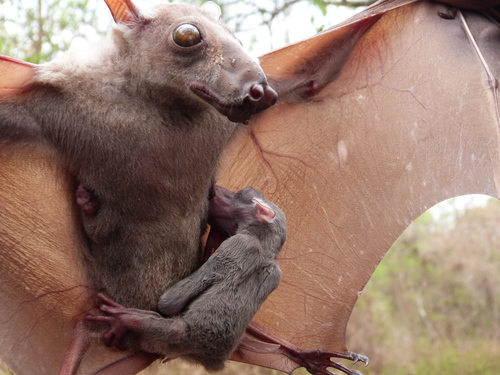
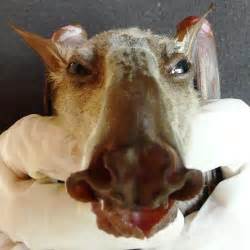
| |||||||
Figure 24c. Hammerheaded fruit bat |
| 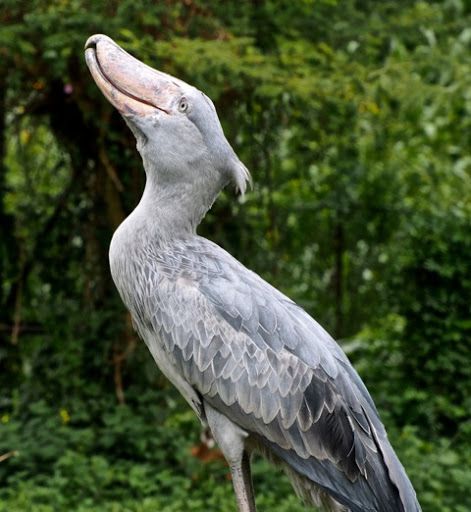
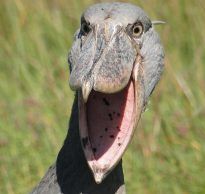
Figure 24b. Shoebill storks, native to Africa. | 4-5 feet tall. Wingspans up to 10 ft. Often described as "prehistoric" looking
| 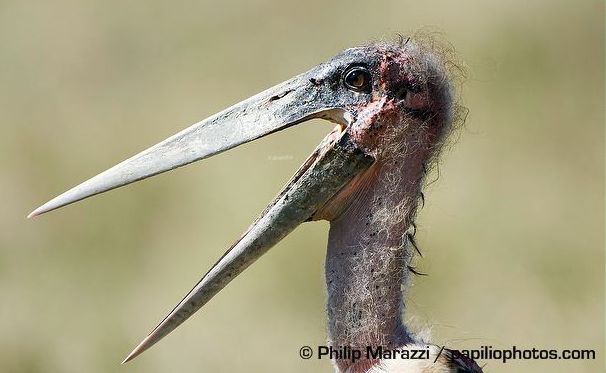
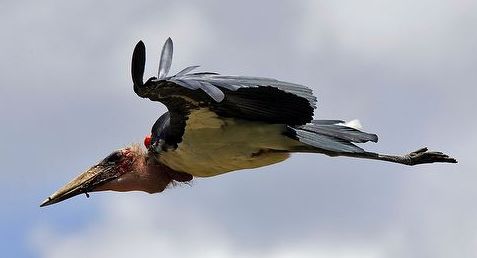
Figure 24c. Maribou stork, Leptoptilos crumenifer |
| |||
In his book Cryptozoology A to Z, Loren Coleman discusses the history of the Kongamato legend, and concludes that the creature "appears to be a form of giant bat, despite some interpretations of it as a reptilian prehistoric creature." He notes that author Ian Sanderson, who reported seeing the creature in Cameroon in 1932, theorized that it was an exceptionally large specimen of the hammerhead bat (Hypsignathus monstrosus), "a particularly ugly-looking fruit bat," which has a long snout and large teeth (Figure 24a). Coleman also notes that the well known cryptozoologist, Bernard Heuvelmans, agrees that Kongamato may be an unknown huge variety of bat, or the hammerhead bat (Coleman, 1999).
Whatever the true nature of the above sightings, as in other areas, large birds or bats probably explain the majority of "pterosaur" sightings on the continent. African is not only home to a number of large fruit bat species, but also many herons, egrets, cranes, hornbills, and vultures, as well as a large, big-billed, crested birds, including the "Shoebill" stork (Figure 24b), which is often described as "prehistoric looking" (Walker, 2017). Another large African bird sometimes described as "pterodactyl like" is the Maribou Stork (Figure 24c).
Perhaps realizing the ambiguous nature of the Kongamato legend and reports, on a web page entitled "Living Pterosaurs in Africa?" Whitcomb writes: "But what about the "flying snake" of Namibia? According to research done by the British cryptozoologist Richard Muirhead, one of these creatures "swooped down" from a cave near Kirris West, in 1942, (sixty miles east of Keetmanshoop, south-west Namibia). It left a trace of something on the ground and a burning smell. Could that burning smell be related to the cause of death of a fisherman who was killed by a kor " (northern Papua New Guinea, 1960's)? "
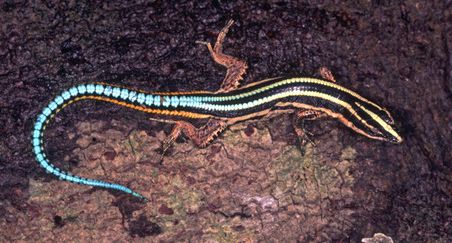
| |
|
Figure 25. Holaspis laevis lizard | |
While science cannot categorically disprove any of these alleged entities, and anyone is free to believe in any or all of them, science cannot accept any as well-established without compelling empirical evidence. This is summed up in the adage, "extraordinary claims require extraordinary evidence." A corollary principle is that when extraordinary claims are made, the burden of proof (or at least compelling evidence) rests on the claimants, not those questioning them. With a little thought, it's clear why this has to be the case. Otherwise, we'd have to accept any fantastic or extreme claim that anyone makes unless one could disprove it, and that is not reasonable. For example, if someone claimed that hoof prints in their yard were made a unicorn (or even zebra) the burden is on them to demonstrate that, not on others to disprove it. This would be especially so if other considerations or evidence undermined the credibility the claim, such as (in this case) the presence of horse stables nearby.
Other misunderstandings by Whitcomb about science and how it operates seem to be revealed when he suggests that paleontologist are probably skeptical due to "fear" which he calls "the enemy of discovery." He asks, "How much better to walk in faith like a little child!" Elsewhere (LPA, p. 108) Whitcomb tells us to "Trust your feelings when you recognize the truthfulness of an eyewitness." However, in science sound conclusions are not based on faith, trust, or feelings, but hard evidence.
While relating some of these accounts, Whitcomb launches into a tirade (p. 171-172) against "skeptics" who question his conclusions. He complains about the "fallacy of insisting an eyewitnesses needs to give skeptics indisputable proof, adding "Why should any person on earth be required to prove anything to any careless skeptic?" However, no one is faulting a witness for not being able to provide a photo or other clear supporting evidence, and Whitcomb and others are welcome to believe any account without it. What he seems to keep missing is that in science, we need more than anecdotes to form reliable conclusions; we need hard evidence.
Whitcomb often stresses how good he is at judging credibility in a witness. However, even if he was perfect at it,
anecdotal sightings are still inherently questionable, since as noted earlier, studies confirm that people often
have seriously flawed perceptions and memories. Moreover, as studies also show, people are generally poor at judging
other's veracity, even when they think they are very good at it. Whitcomb seems to be no exception, since he sometimes cites
as trustworthy individuals who by all evidence are anything but, including Phillip O'Donnell, whose book promotes
things such as T-rex like dinosaurs running around in Texas, and Carl Baugh, who has misrepresented so many things
that even major YEC groups have warned their
followers not to trust his assertions without clear independent evidence (Batten, 1996). Ironically, some of Baugh's
most obviously false claims concern a supposedly live pterosaur (at least momentarily alive) in France, which brings
us to our next topic.
Transparent Hoaxes
"The record states that in France, some workmen, in the winter of 1856, while working on a railway tunnel between St. Dizey and the Nancy lines, came across a huge boulder of Jurassic Limestone, which precedes the Cretaceous by several million years. After they had broken open the limestone, stumbling out of the tunnel toward them was a creature which fluttered its wings, croaked, and collapsed dead at their feet. This creature had a wingspan of ten feet, seven inches, with four legs joined by a membrane like a bat. What should have been feet were long talons. The mouth was arrayed with sharp teeth. The skin was black, oily, and thick. Local students of paleontology immediately identified this creature as being a pterodactyl. This was all reported in The Illustrated London News, February 9, 1856, page 156. They examined the limestone from which the creature had been released and found a cavity in the exact mold of the creature's body. It this is true, it is absolutely impossible for that creature to have lived more than a few thousand years in any form of hibernation...The worldwide, biblical Noahic flood explains this phenomena [sic] far better than the evolutionary process (Baugh, 1989).Many readers will readily recognize the inherent absurdities in this account. While Baugh says the creature could not live inside the rock more than a few thousand years, his own interpretation requires that it be remain buried alive since Noah's Flood--over four thousand years by his own time reckoning (Baugh, 1989). Baugh's reference to hibernation does not begin to explain how it managed to live and breath without any oxygen for a time span orders of magnitude greater than any creature's normal life span. Of course, common sense dictates that the creature could not live inside a sealed rock for thousands of years, or hundreds of years, or even one hour for that matter.
A TalkOrigins archive article adds some interesting background on the newspaper account:
At the time, there was a great Franco-Prussian rivalry, and the Solnhofen Limestone from Bavaria (from which Archaeopteryx would later be discovered) was producing many fabulous fossils which were loudly trumpeted by German paleontologists. When a tunnel was being built in France through limestone the same age as the Solnhofen Limestone, French "gentlemen geologists" took the opportunity to trumpet a story of their own. In the original report, the pterodactyl crumbled to dust, conveniently leaving no evidence." (Isaak, 2005)
Lest the reader wonder whether Baugh intended the story to be taken seriously, he remarks, "...having so many other anomalies, we certainly do not doubt this account..." Evidently by Baugh's reasoning, but since there are many unexplained things in the world, this fantastic story must be true. Baugh also assures the reader that the story was related in "a verifiable publication," as if its appearance in an old newspaper assures its accuracy.
Remarkably, Baugh was not the only YEC to publicize this silly story as a credible account. In an article in Creation magazine, a publication of Creation Ministries International (CMI), entitled "Are dinosaurs alive today?: Where Jurassic Park went wrong!" Robert Doolan described how workmen in France "disturbed a huge winged creature... ... while blasting rock for the tunnel" and that "it died soon after."(Doolan, 1993). Later, a disclaimer on the web version of the article noted Doolan retracted this statement "new evidence shows that it was a hoax" - as if it were not apparent from the start that a creature could not be living inside a rock, let alone live a while longer after being blasted out of it. Another YEC website called "Discovery World" still promotes the story as realistic, along with many other long-ago discredited claims (Anderson, 2017),

|
|
Fig. 26. Silver-haired bat photo (left) onto which a bird head was Photoshopped to foster a pterosaur-like appearance (right). |
Vertebrate paleontologist Darren Naish (1995) remarked on the Dinosaur List (a web-based paleontology forum) that this pterodactyl-in-a-rock story might have been inspired by stories of toads found alive in rocks. He notes that despite such rumors, only one such specimen has been retrieved, and this was "found" by the same man responsible for the Piltdown hoax. Moreover, there are quite plausible explanations for toads in rocks; namely that the creature either crawled in a small hole or crevasse which was not noticed then the rock was broken open, or that eggs or a tadpole might have been laid or fallen in a smaller opening, possibly trapping an adult (which might live for a while from insects passing by). At any rate, there is no evidence that any animals have been found "alive" in a tightly sealed rock, nor any reason to expect they would be. For a more detailed discussion of the French pterosaur hoax see Gross (2009).
Another apparent hoax or parody is a YouTube video entitled "Rare Pterodactyl being saved: Amazing video
of a real Teradactyl [sic]" at:
https://www.youtube.com/watch?v=bf5qBosdgBk
The video shows several people trying to free a long-beaked creature from some type of entanglement on a
muddy lakeshore. The text from "yogwhatup" that accompanies the video states:
"Uploaded on Aug 31, 2009. Update: 9/3/2016. Through digital spectrum analysis we have determined that this
animal is not a bird, including any species of heron. Multiple studies of the video continue as we progress to the identification of this
species. This is groundbreaking as we may actually have the fist true video evidence of a dinosaur living in the 21st century."
Although filmed at night, one can plainly see feathered wings, and by the end of the video, one can see enough to
identify it as a heron, probably a Great Blue Heron. The loud, shrill, almost blood curdling cries of the bird add
an interesting element to the event, and to some may sound "prehistoric." Whether the video was intended as joke or not is
besides the point that large birds are sometimes promoted and/or misidentified as "pterodactyls." .
Several viewers who left comments, agree. One correctly pointed out the irony that since it was a bird, it was a
dinosaur, whereas pterosaurs aren't dinosaurs.
Alleged Photographic Evidence
Only a handful of photographs have been presented as possible evidence for modern pterodactyls, and even these are strongly questioned or rejected by most researchers, including most YECs and cryptozoologists. Some are apparent misidentifications of birds or other creatures, while others are likely or definite hoaxes. Several dubious historical photos in the latter categories are shown on many cryptozoology related websites. One (Fig. 27a), shows a young man holding a creature resembling a long-tailed pterosaur. However, the head is unusually tiny, the wings unusually wide, and no reliable information exists as to the source or age of the photo. Another photo rumored to have been taken in the 1800's (Fig. 27b) shows a rather bunched-up and floppy looking pterosaur, is widely regarded as fake, as are those in Figures 27c and 27d. Whoever created Figure 27c seems to have forgotten to edit out part of a deer that was in the original photo; if you click on the image for a larger view and look near the feet of the third man from the left, you will see the deer's feet. The "pterosaur" in Fig. 12d seems to have a fairly natural-looking head, but like many cartoon and movie pterosaurs, was given bat-like wings, unlike any real pterosaurs. Whereas the membrane on a bat wing is stretched across four elongated fingers, a pterosaur wing bore the membrane on one highly elongated finger, with three much smaller fingers extending outside the membrane (see Fig. 32a). Figures 27e and 27f follow the same theme (gun-toting men proudly displaying a pterosaur carcass), and like the others are of uncertain age and origin.
Mark Chorvinsky (2000) related in a Strange Magazine article that he obtained a copy of an April 26, 1890 Tombstone Epitaph article that indeed did contain a story about a "A strange winged monster." It related that it was shot and killed by two ranchers the Sunday before while returning home from the Huachuca mountains. The creature was described as resembling a huge alligator with immense wings, lacking any hair or feathers, with an elongated tail, a body of 92 feet long, a beak about eight feet long, and a wingspan of about 160 feet. By comparison, the largest known fossil pterosaurs had wingspans of 36-40 ft, and a Boeing 737 jet has a wingspan of about 113 feet. The story ended by saying that "several prominent men" returned to the site in an effort to bring it to town. However, no photograph accompanied the article, nor has any further reliable information on the case turned up, although other versions of the story have circulated in various publications and web sites in recent years. In view of all this, and the incredible reported size of the creature, it seems likely that the original Epitaph story was simply a tall tale, similar to many others common in newspapers of the day.
The story is so dubious that even Whitcomb has not endorsed it, although it has been promoted as credible by a few YECs, including Dennis Petersen (2002). If nothing else, this case seems to further confirms how variable and fallible memories are. Further details on the Tombstone "Thunderbird" saga are related by Hall (2004) and Taylor (2008).
Another photo circulating on the web shows a dead Triceratops dinosaur posed with a troop of Civil War soldiers (Fig. 27f), which may be considered the same genre. Evidently it was originally submitted to the now defunct "Worth1000" website as Photoshopping contest entry.
Two other so-called "Civil War" photographs have recently been the subject of much discussion on the web.
Both photos show a giant Pteranodon-like
pterosaur carcass posed with several rifle-bearing Civil War soldiers.
One, which Whitcomb calls "HFf" for "Haxan Films fake" (Figure 28), is recognized as a hoax by virtually all
researchers, including Whitcomb. It was created with actors and a large pterosaur model in the late 1990's for the
2000-2001 FOX television "Freaky Links" series, produced by Haxan Films. The photo appeared in a June 1998
promotional web page
for the series, where a quaint back-story was concocted for it (supposedly it was found folded up
in a paranormal book from the 1970's). The page was attributed to "Derek" evidently referring to the fictional
character Derek Barnes in the TV program, who was played by actor Ethan
Embry, a.k.a Ethan Randall (Embry, 1998). At the bottom of the page a link leads to
another FreakyLinks page
(dated Aug. 28, 2000) showing a very similar photo (Figure 29a, with the following comments: "Newsflash, Someone sent me this pic from a
hotmail account (but of course). What do you think?".
The "Ptp" Photo
This second photo, dubbed the "Ptp" photo for "Pterosaur photo" by Whitcomb (Figure 29a) has been rejected or strongly questioned by most researchers. Indeed, on the same FreakyLinks page where it first appears are comments from two visitors, describing what they saw as evidence of Photoshopping (discussed further below). Nevertheless, since January 2017 Whitcomb and his partner Clifford Paiva have declared Ptp to be a real "Civil War photograph" showing a real modern pterosaur carcass. Whitcomb has further argued that the obviously fake HFf photo was based on the "real" Ptp photo (Whitcomb, 2017a, 2017b, 2017e).
In early 2017 Whitcomb correctly pointed out that I and others originally confused the two photos, and I thank him for that clarification. However, his assertion that the Ptp photo is genuine and far older than HFf is entirely unfounded. Indeed, upon close examination many serious problems are found with the Ptp photo and creature shown in it. Moreover, recently revealed evidence indicate that both photos were recent (c. 1998-2000) fabrications commissioned by Haxan films, with the Ptp photo created shortly after the HFf photo (more on that later).
Several websites state that the Ptp photo was reportedly taken near Vicksburg, Miss. in 1864, without citing any specific sources for this, or the original source of the photo.
Evidently the HFf photo never appeared in any FreakyLinks TV series, despite being featured in the website promo. However, the Ptp photo appears briefly on a laptop screen in two scenes near the end of the October 2000 FreakyLinks episode entitled "Coelacanth This", which can be seen in a number of YouTube videos. When it first appears, the "Derek" character claims to realize that the mysterious creature that has been attacking people in a small town, could relate to old "Thunderbird" legends and actually be a prehistoric throwback or "Pteranodon" like the one in the photo. He says "everyone's seen the picture." In the last appearance of the Ptp photo about 41 minutes into the program, next to it on the same screen is what appears to be an old hand-written letter (Figure 29b). The letter is diffcult to read, but the accompanying narration implies the letter was found in the Library of Congress, and that it was written in 1865 by Corporal Dan Wilson of the Indiana Riffle Brigade". I have been unable to verify the existence of any such letter, corporal, or brigade. This is not surprising, since the FreakyLinks series was meant as fictional, entertainment based program, not a serious documentary.
When discussing the Ptp photo in his writings, Whitcomb never mentions (and perhaps didn't know) that it's first verified appearances were in the 1998 FreakyLinks promo website and subsequent 2000 TV program. All he states about its history is that he found the photo on some unnamed "web sources" and that "many people," including himself, recall seeing it in some unspecified book during the 1950s, 1960s or possibly 1970s. However, no one recalls exactly what book, and no one has been able to locate it. This too is not surprising, since as will be demonstrated below, evidently both the Ptp and HFf photos were created c. 1998 - 2000 for the FreakyLinks TV series. In view of this, it seems likely that Whitcomb and others were misremembering one more similarly dubious pterosaur photo from the past, or perhaps developed false memories from the many web discussions about the infamous and untraceable "Thunderbird photo" (or even from the fabricated back-story presented by Haxan for the HFf photo).
Of course, one could argue that even though the U & U frame is fraudulent, perhaps the photo inside it is not. Unfortunately for the Ptp proponents, abundant evidence indicates that the original photo is fake as well, and a relatively recent one at that. Until January 2018, this evidence priparily involved problems with the Ptp photo itself (and the creature in it), which will be discussed momentarily. However, on January 9, 2018 A Skeptoid podcast by Brian Dunning confirms that the Ptp photo was a recent (c. 2000) creation of Haxan Films. Dunning indicates that Haxan production designer Steve Wolfe hired the digital FX company "E=MC2 Digital" to create the Ptp photo (Dunning, 2018). He confirmed that Civil War reenactors were used in the photo, and that the artist then "went to work" to produce the rest of the image (implying use of digital manipulation), although details of how the creature was created were not elaborated, such as whether any pterosaur model were used, or simply a pterosaur image from another source. Dunning also cleared up the question of why two very similar photos were created by Haxan. He indicated that Haxan had commissioned the creation of the Ptp photo because in the earlier HFf photo, the pterosaur model (the one now in Loren Coleman's Cryptozoology museum) laid too flat and non-dramatic, and because Haxan had not obtained model releases from all the HFf actors for use in the FreakyLinks TV show. Dunning noted (as Bruce Baryla and I did earlier) that the Ptp photo can be seen on a computer screen in Episode 4 called "Coelacanth This" of the FreakyLinks TV series. He also indicated that 20th Century Fox and Regency Entertainment (affiliates of Haxan Films) assert their copyright (2000) to both images, which would not be the case if either were real Civil War photos. Dunning ends the podcast with the comment "With apologies to the Young Earthers, these aren't the pterosaurs you are looking for." Although it could be argued that these recent revelations make much of the following analysis (most of which was written in 2017) largely moot, I will keep it here for now, in order to illustrate that even before the recent Skeptoid podcast revelations, many other lines of evidence strongly pointed to the fraudulent nature of the Ptp photo.
Soon after Whitcomb began promoting the Ptp photo, Cryptozoological researcher Dale Drinnon also pointed out a number of signs of photo editing, including the lack of fingers grasping the rifle of one of the soldiers, the presence of edge halos typical of Photoshop manipulation, and signs of blur filter usage (Drinnon, 2012)--all of which Whitcomb disputes. Some of Drinnon's observations seemed questionable or moot (for example, alleged missing fingers on one of the soldiers could be due to the man gripping a different part of the guns). Others, such as the possible use of filters, seem more plausible. Indeed, even Even Whitcomb acknowledged that it could have been "digitally altered recently" (Whitcomb, 2017, p. 93). Richter (2017) also noted evidence that the photo was not done on albumen paper as were real Civil War photos. However, aside from these overall issues with the photo, there are other and more obvious reasons to question the authenticity of the photo and creature in it.
Bruce Baryla (2017b) independently noted many of the same features, and agrees that the features are clear evidence that at least one wing was artificially created, probably with Photoshop (see Fig, 29f). More recently Baryla (2017c) has shown that duplicating one wing with Photoshop can be easily done.
Recently Paiva added some photos to his web page showing butterflies with largely matching features on opposing wings. This is misleading, since he is comparing an invertebrate (insect) to a vertebrate. As far as I know such a level of precisely matching features on opposite limbs is unknown among vertebrate animals.
Instead of fully facing the significance of the mirror image evidence and admitting that the creature is fake, Paiva suggests that creating a table showing "pros" and "cons" for the photo might somehow offset that evidence. He states: "The "pros" for example, consisting of the branch in the beak (not readily noticed); the bending of stubs on the ground, indicating dragging the animal over and into position; the men leaning on muskets for stabilization for the required 10-15 second exposure; and of course the highly detailed EYE of the animal. The "cons" on the other hand will certainly include the IDENTICAL wing markings seen below."
However, as will be discussed in more detail later, all these supposed "pros" (and others Whitcomb presents) are either highly dubious or have multiple alternate explanations, and thus do nothing to counter the powerful negative evidence from the mirror image features and Skeptoid podcast revelations discussed above, let alone the many other problems with the creature, soldiers, and photo background yet to be discussed. Obviously, one can find broken saplings in a field for any number of reasons besides a dragged pterosaur corpse, and soldiers (or reenactors) might lean on their rifles in any posed photo (no matter what the exposure time), besides the fact that most of the men in the photo are not even leaning on their rifles, just holding them.Trying to offset compelling evidence of fraud with a handful of dubious or ambiguous features is like arguing that even though a photo of a supposed Bigfoot clearly shows the zipper and price tag on the back of an ape costume, we should largely disregard that because there are some broken branches in the photo, and a possible banana peel on the ground, which could be signs of Bigfoot activity.
In his writings, Whitcomb not only fails to face the implications of the mirrored wing features, he attempts to turn it upside clown, by claiming that the wings "reveal a general symmetry consistent with a natural biological reference." (Whitcomb, 2017, p. 104) Unfortunately, as already noted, his own partner Paiva acknowledges that these features are consistent with a fraud. Despite this, on page 108 Whitcomb shows 5 figures which supposedly refute the mirror-image argument. However, the first two figures at the top of the page actually further confirm it, since one can readily see the mirror-image patterns. Whitcomb tries to discount this by showing two highly magnified figures at the bottom of the page, claiming they show differences in the wing features. However, this exercise is meaningless at best, and deceptive at worse, since Whitcomb fails to account for the fact that one wing was apparently distorted (stretched) artificially in relation to the other, so that it's overall dimensions are somewhat different, and accentuated when greatly magnified. This does nothing to counter the evidence that from lesser magnification or normal viewing, the mirrored features are clear, and entirely incompatible with a real creature. In short, Paiva and Whitcomb demonstrate severe confirmation bias in failing to face this well-supported conclusion, while instead focusing on any possible positive evidence, no matter how weak or questionable.
Whitcomb (2017o) states that although the some patterns of the opposing wings are "similar," others are "morphologically discordant." This too does nothing to help his case. First, as previously noted, many irregular shapes on the wings are not just "similar" but as Paiva himself acknowledged, they are identical. Second, obviously some parts of the creature cannot be expected to be mirror images (since, for example, the head and part of the torso are pointed toward one side), which does nothing to detract from the implications of the precisely matching parts.
He states that evidently neither Baryla nor I have been able to demonstrate that one wing could be digitally produced from the other. However, as mentioned earlier, Baryla has indeed demonstrated this (Baryla, 2017c, click here for the analysis). Moreover, even without such a demonstration, the numerous mirror image features on both wings already demonstrate conclusively that the creature is a fake. Whitcomb notes that neither he nor Paiva have been able create one wing from the other with Photoshop, but in view of Baryla's demonstration, all this indicates is that they are less adept than using Photoshop.
Adding to the problems for Whitcomb and his claims, Baryla corresponded with FOX and found that they own the copyright to the Ptp image (Baryla, 2017c). The only way they could is if they created the photo, since a genuine civil war photo would have no current copyright attached to it, unless it were heavily altered.
Apparently all of this evidence has finally had some affect on Whitcomb. After months of flatly declaring that the Ptp photo is entirely genuine, and that no Photoshopping was involved, he now admits "the possibility of some kind of digital manipulation" (Whitcomb, 2017o). Curiously, he does not say what specific manipulation he is referring to, or how any such manipulation does not severely undermine the credibility of the photo. Instead, he launches into a convoluted analogy about buying a car that has no tires on one side, and no engine. His point seems obscure at best, although the tires do seem to have fallen off his arguments. Perhaps he is suggesting that a real pterosaur lacked a wing on one side, so someone later Photoshopped it in, but if so, it is unclear how this helps his case.
In an apparent last ditch effort to salvage his claims about the Ptp photo, Whitcomb (2017o) notes that "Paiva has also found that the brush under the neck and body of the animal is in front of the animal but the end of the beak is in front of the brush. This is definitely not from a simplistic Photoshop hoax." Apparently he wants us to believe that unless the entire photo was Photoshopped, and in a "simplistic" way, then the creature must be real, which of course does not logically follow.
Evidently seeing the writing on the wall, Whitcomb (2017-O) has recently softened his Ptp photo claims. After months of flatly declaring that the photo shows a real modern pterosaur, he now concedes that he and Paiva do not have a "100% conviction" about that, but conisder it "very likely" (Whitcomb, 2017o). He also says that in January of 2017 he and Paiva agreed that there was a "high level of plausibility" that the photo showed a modern pterosaur, even though previously he implied that they had no doubt about it. Curiously, on the same web page with these equivocations, the caption under the Ptp photo still states "Verified guine image of a modern pterosaur," while other web pages by Whitcomb continue to make similar declarations. Yet other pages by Whitcomb continue to assert that the photo was published by Underwood and Underwood Studios, even though this claim has been well refuted.
While the recent hedging by Whitcomb is interesting, in view of all the evidence presented above, there can be no reasonable doubt that the photo is fake, since actors were used, and at least one wing and parts of the background were photoshopped. There is still some room for debate on whether the head and torso of the creature involved a model, or just an inserted or fabricated pterosaur image. However, these additional questions are largely academic and moot, since no further evidence is needed to conclude that the creature is fake. However, for those who may need more convincing, I will discuss other serious problems with the creature and photograph, and rebut specific claims by Whitcomb and Paiva about them.
Since early 2017, Whitcomb argued that the carcass is a real modern pterosaur, and an "apparent Pteranodon." On his "Living Pterosaurs" blog he often refers to the "Pteranodon photograph" but elsewhere qualifies that the photo shows a Pteranodon or closely related pterosaur. However, besides the mirror image wing features discussed above, the creature shows a number of other serious problems. These include significant differences from a real Pteranodon (points 1-5, illustrated in Figures 3a, 30a and 30b), as well major differences from any real pterosaur (points 6-11), even though Whitcomb often falsely claims I only address the former.
1. The animal appears to have large teeth, whereas Pteranodons and closely related pterosaurs were toothless
2. The upper beak appears thick, downward bent, and blunt at the end, whereas real Pteranodon beaks are slender,
straight or curved upward, and sharp at the end.
3. The lower beak also appears to be shaped unlike that of a real Pteranodon.
4. The posterior crest is essentially parallel to the central line of the beak, whereas real Pteranodon
crests tend to make an upward angle.
5. The head is too small for the size of the body and wings.
6. There appears to be a deep vertical furrow between the beak and eye socket, not found on real pterosaur skulls
7. There are no signs of the three small, clawed digits that should occur on the forearms.
8. The wings have a severely concave shape - what Whitcomb called "canoe-like".
9. Paiva claims the wings show an ideal airfoil shape, but the wings are concave in the wrong direction for an airfoil effect.
Even if one argues the odd convavity is due to rigor mortis or an unatural pose, it invalidates Paiva's argument.
10. The wing membranes appear thick, cloth-like, and opaque, unlike the thin, taut, translucent membranes
paleontologists believe pterosaurs had. That no indications of the soldiers' legs are visible
behind the wings accentuates this problem.
11. If it were a real animal carcass, the head would probably have flopped to one side or the other, rather than
be standing upright. Any rigor mortis would probably have occurred with the head lying flat on the ground, not an upright position.
Assertions by Whitcomb and Paiva about a supposed stick in the mouth or other supporting "props" are weak at best (discussed more later).
David Peters, an active pterosaur researcher, independently noticed many of the same problems, as well as the following (Peters, 2001):
- The head is too wide.
- The crest is too thick. Real Pteranodon crests are very thin (see Fig. 30a).
- The portion of the wing beyond the wrist (where the free fingers should be) appears too short.
- The wing appears to lack propatagia (the anterior wing membranes between the wrist and shoulder--see Fig. 32a)
Paiva (2014) claims the right wing (on the left of the photo) shows a propatagium, but the bunchy, thick material there does
not resemble propatagia of real pterosaurs, which would be thin and taut.
The shape of the crest is especially aberrant for an alleged "apparent Pteranodon," looking essentially tube-shaped, rather than blade-like as in large head crests of real Pteranodons (see Figure 30a). Likewise, the upper beak is far thicker and blunter at the distal end than any known Pteranodon or similar pterosaur.
As a result of all these and other problems, the overall appearance of the animal is quite unnatural and phony looking, and far from anatomically "perfect" as Whitcomb and Paiva claim, not just for a pteranodon, but any realistic pterosaur. Indeed, rather than having a terrifying and "gruesome" appearance as Whitcomb argues, to me it appears somewhat comical and Muppet-like, resembling some of the earliest Pteranodon depictions based on early fossil finds from the late 1800's. These include various illustrations and models for museums, movies, and toys which widespread during the early 1900's, such as the models shown in the 1925 Lost World film (based on Arthur Conan Doyle's 1912 book by the same name), and the 1933 King Kong movie (Figures 31a, 31b).
Even Whitcomb acknowledged in his earlier writings that the photo and creature in it showed suspicious features, including canoe-like wings, although he rationalized that they could have appeared that way due to rigor mortis. (Whitcomb, 2017a).
According to Whitcomb, Paiva always accepted the photo as genuine, but that it took him (Whitcomb) a longer to come to this conclusion. He explains that after realizing that the canoe-like wings were not actual canoes, and discussing with Paiva various positive "evidences" (apparently overlooking or disregarding most of the problems noted above), in January 2017 he and Paiva publically declared that the Ptp photo and creature in it were definitely authentic, and proof of modern pterosaurs. A number of Whitcomb's web page presented some of the following lines of evidence in favor of this conclusion, with the rest advanced in his new Modern Pterosaurs book that followed in April (Whitcomb, 2017b):
1. The shadows are correct for a real soldier's boot on the beak of a real pterosaur.
2. Anatomical features of the head and neck point to it being a real pterosaur.
3. The positions of the soldiers is consistent with a Civil War photograph.
4. Marks on the ground suggest the animal was dragged to a good location for photography.
5. A broken sapling suggests they dragged the animal.
6. The eye shows a reptilian slit-like pupil.
7. The creature has "inverted wings" that a hoaxer would not think to create
8. A branch under the beak was used as a "prop" to hold up the head.
Despite Whitcomb's depicting these as "direct evidence" for the creature's authenticity and thus proof of living pterosaurs, all range from weak or moot to demonstrbly false, and do nothing to counter the more serious problems related above. In fact, some of his claims backfire, and actually provide further evidence that the photo is fake. To be more specific:
Point 1 is irrelevant at best. Even if the shadows were correct, they'd be expected for an actor standing on a model pterosaur, and if an inserted image was used, could readily created by any good photo editor. As it is, many people have pointed out that the shadows from the boot on the beak do not look quite correct, and that the man himself should be casting more of a shadow.
Point 2 is ambiguous and ignores the aforementioned problems with the shape and features of the head, beak, and crest. Whitcomb suggests that an apparent humped shape of the neck is indicative of a real pterosaur and not something a hoaxer would know about or create. However, I see nothing special about the neck features that would be unlikely or difficult for an artist to create (either with a model or an image). After all, if Whitcomb could notice certain pterosaur features, so could a hoaxer.
Points 3 and 4 are also moot, since the positions soldiers could simply be the result of actors recreating a Civil War photo, while the marks on the ground could be due to a number of different causes, including dragging or carting a model pterosaur, tripods, or other equipment for a staged photo.
Point 5 is a stretch at best. Even aside from many other possible causes, if real soldiers could break a tree sapling to clear the way for a real pterosaur carcass, actors and/or their equipment could as well. One can imagine any number of other causes for a broken sapling in a field, that might have nothing to do with the photo. The way the sapling is broken also argues against intentional breakage. Whitcomb suggests it was broken to minimizing possible damage as the pterosaur was dragged into place for photography. The problem is, the tree is broken to the right, which would force the animal to be dragged 'against the grain' of the branches and twigs, whereas if the soldiers wanted to minimize damage and resistance, they would have broken it in the opposite direction, or just dragged the animal around the tree.
Point 6 has multiple problems. Even with magnification the details of the eye pupil are not clear (Figure 32b). Instead of usual reptilian slit shape, which should be widest at the center, it appears to show are darker area at the top and bottom, and lighter area in the middle (although some of this could be artifacts of shadows or imperfections of the photo). Even if the eye did have a more typically reptilian eye-slit pupil, it means little, since not all reptiles have slit-pupil eyes, and it's uncertain what kind of eye pupils Pteranodons had. Whitcomb suggests that using a slit-like pupil is not something a hoax creator would think of, whereas it actually seems entirely plausible that someone taking the time to manufacture a model pterosaur might also take the time to check what type of eyes most reptiles had.
Point 7. Ironically, Whitcomb's argument about the "inverted" or oddly concave wings, is itself up-side down. Indeed, he seems to use convoluted logic in reasoning that unrealistic looking wings are somehow evidence that the carcass is real, on the grounds that a model maker would not think to make them look so unnatural. In his Modern Pterosaurs book he says (p. 92) that when considering the authenticity of the photo, he did some research, and when he could find "no image of a canoe in North America that looked like those wings" he "moved up to around the half-way point, the twilight zone between doubting it and believing it." He then says that what "tipped the balance" (in favor of the photo being genuine) was when he consulted a "canoe expert." In other words, he apparently concluded that if the unnatural-looking, canoe-like wings were not actual canoes, the animal is probably real. Ironically, on the next page Whitcomb warns readers to be wary of critics and their "fuzzy thinking."
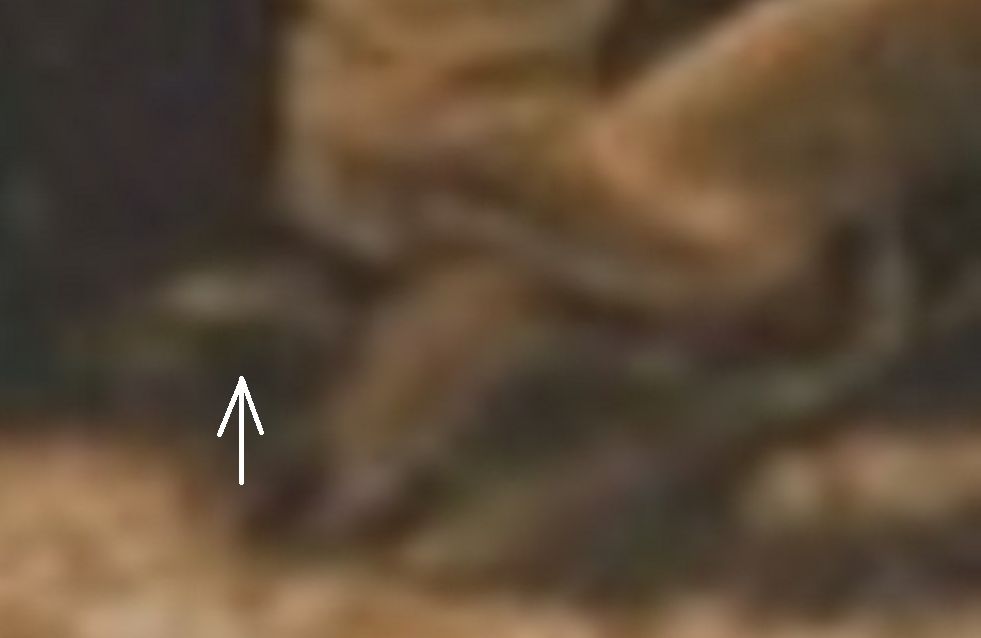
| ||
Fig. 32c. Arrow points to alleged tree branch "prop" |
| 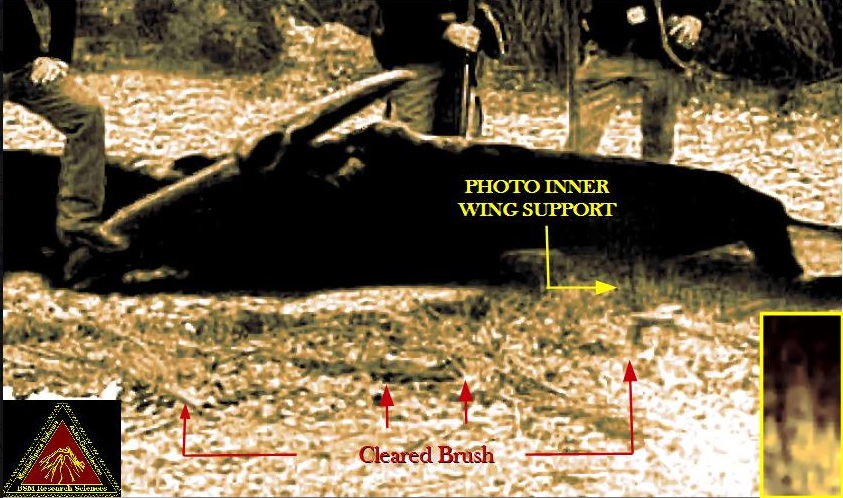
Fig. 32d. Paiva's alleged "cleared brush" and "wing support" | Photo from Whitcomb (2017i) web page, used under "fair use" provision of U.S. copyright law. |
Whitcomb (2017g1) makes the odd claim that close inspection of the wings shows that they do not contain wooden structures, even though to my knowledge, no one ever claimed they did. Even if wood was used in a physical model or partial model (with some features digitialy created or duplicated), it would be under the outer coverings, and thus not show in a photograph.
In the same posting Whitcomb asks how 19th century soldiers would know how to fold wings. This again makes the unfounded assumption that the soldiers are real Civil War soldiers rather than actors, besides the fact that the wings do not look properly "folded." Indeed, they are kinked in a very unnatural way. Paiva shows several diagrams illustrating the supposed air-foil shape of the wings, but this argument backfires too, since as mentioned earlier, the wings are concave in the wrong direction!
Point 8 is subjective at best. Whitcomb (2017, p. 98-99) argues that a "tree branch" used as a "prop" is visible under the creature's beak (Figure 32c), and that it not only supports the authenticity of the photo, but shows that it was taken in the 1800's, because the exposure times in those days would have been too long for the man's boot and creature's head to remain steady without a prop. However, the feature in question is very indistinct, so it is not even clear that it is a branch. Even if it is, it appears too small and flimsy to do much good in steadying the large head. Last and most important, if it was used as a prop, or as something to hold the mouth open (perhaps to show teeth?), it could have been used to do these things with a model pterosaur rather than a real one.
Whitcomb argues that such props would only be needed before about 1870, when advances in photography removed the need for long exposure times. However, this is another moot point, since the alleged props are ambiguous at best, and the creature would have been just as inert whether it was a real dead animal or just a model.
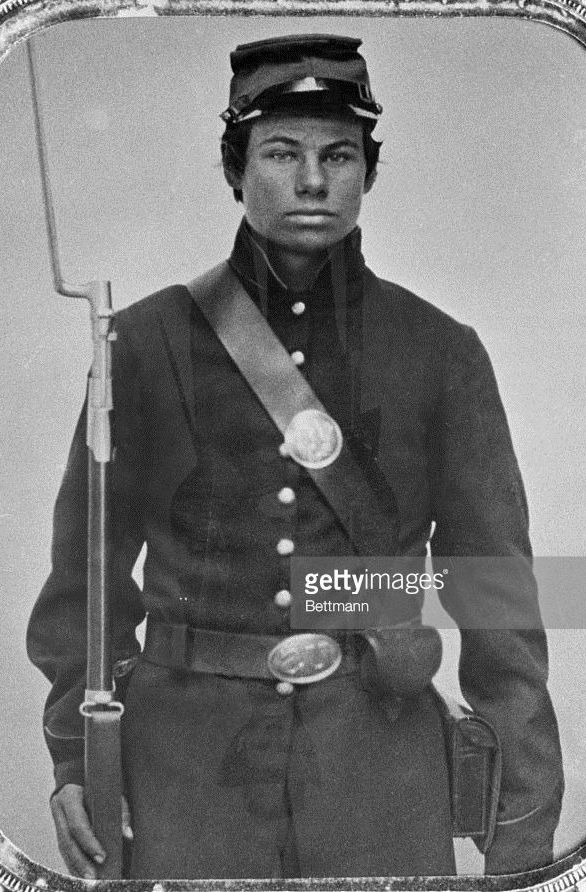

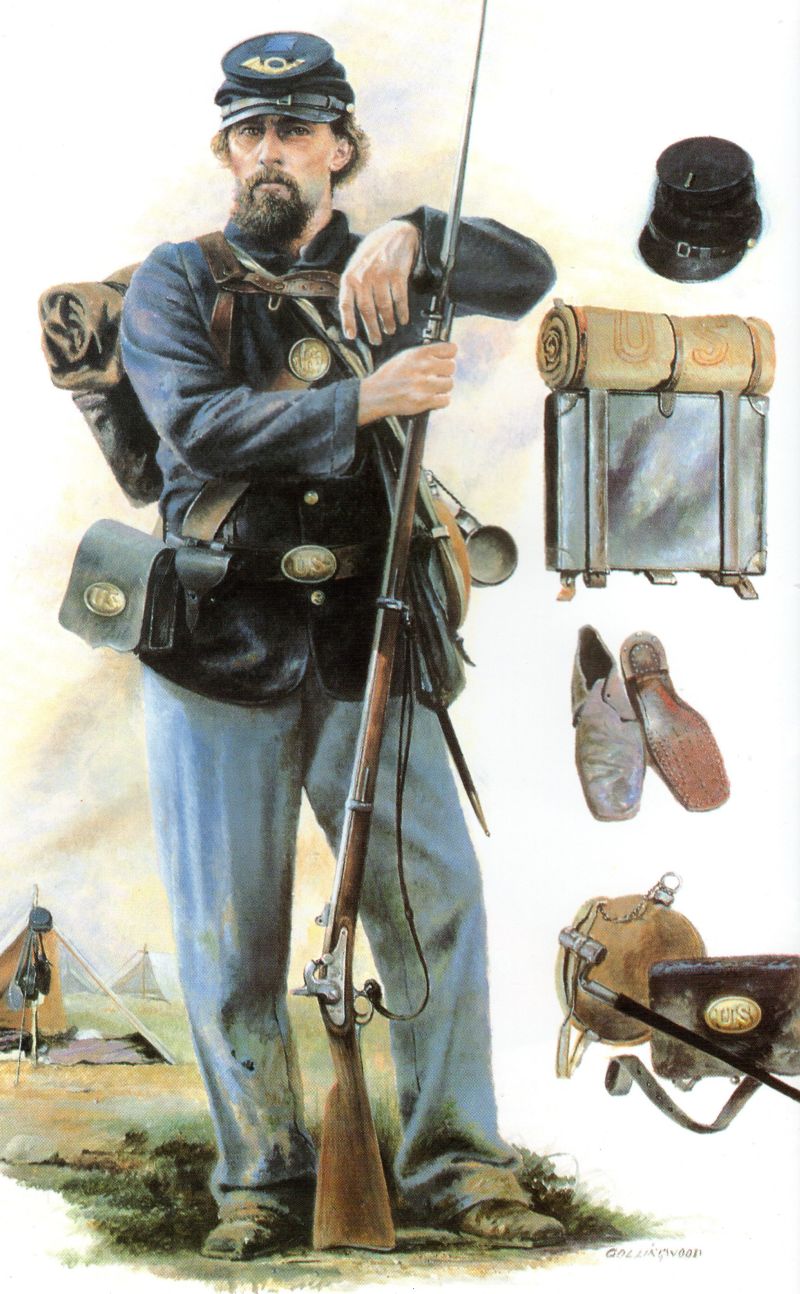
|
|
Figure 32e. Union infantry soldiers showing oval buckles and centered breast plates. Left two photos show real soldiers. Painting at right by Chris Collingwood illustrates a typical Union soldier's uniform and gear. From Smith and Field (2004). |
Whitcomb often speculates about the soldiers' behaviors, but surprisingly never discusses whether their uniforms and gear are compatible with real Civil War soldiers. On a web page entitled "Monster" in a Civil War Photograph, Whitcomb makes the curious statement, "Paiva and I have not made any statements supporting the idea that the photo was taken during the Civil War." However, this seems contradicted by the very title of the page, and as well many other web pages where he refers to the "Civil War photograph" or "Civil War Soldiers" (Whitcomb, 2017m, 2017n). Moreover, Whitcomb sometimes specifically argues that the Ptp photo shows evidence of being of Civil War age. For example, on a web page entitled "Modern Pterosaur in a Civil War Photograph" he states that the subjects of the photo are "all in reasonably good focus, a characteristic of Civil War photography" (Whitcomb, 2017g1). On another page he writes, "I want to be objective about this photo that appears to have come from around the time of the American Civil War..." (Whitcomb, 2017e). Despite these inconsistencies, it may be understandable that Whitcomb wants to hedge on whether the photo was actually taken during the Civil War, since there are problems with that proposition.
The general appearance of the soldiers' uniforms in the photo suggests they are enlisted Union infantrymen (not officers, Calvary, or special unit members). Although Civil War uniforms were not particularly "uniform" due to many variables in their manufacture, distribution, and other factors, the men in the photo appear exceptionally irregular. As indicated by Civil War uniform experts (Smith and Field, 2004), the vast majority of infantrymen wore oval rather than rectangular belt buckles, so it would be highly unusual to see a group of several or more where all were wearing rectangular buckles (Fig. 32e). The circular breast plates on the diagonal straps used to hold cartridge boxes are normally centered on the chest or nearly so, but in four of the soldiers the circular plates are far off center, and two soldiers appear to lack them. One is not even wearing his hat. The pants of real soldiers were usually baggier and (unless freshly issued) more soiled and worn. Whereas one might rationalize a few of these irregularities, collectively they point to the men being Civil War actors. Indeed, all of the Civil War and photography experts I consulted agree that the photo shows multiple indications of being fraudulent, irrespective of the creature in the photo (Heberton, 2017; Morgenweck, 2017, Richter, 2017; Woolf, 2017; Zeller, 2017). The problem is, if the men are not real Civil War soldiers, or even if there is serious doubt about that (as even Whitcomb seems to allow), then it further undermines his claim that the photo and creature are real, unless he wants to argue that a group of Civil War reenactors or reunion attendees decided to get together with live ammunitoon, and happened to shoot down a giant pterosaur.
Ironically, Paiva's BSM website shows the Ptp photo next to a painting of a typical Union soldier (Fig. 32e, far right) with the caption: "Consistency of Union Uniforms in 19th Century Pteranodon Photo", even though the painting actually helps illustrate the above mentioned inconsistencies, including the incorrect belt buckles and misplaced breast plates.
In his 2017 MP book and on several web pages, Whitcomb makes additional arguments about the Ptp photo that range from weak and illogical to entirely baseless. When discussing the creature in it (MP, p. 102), Whitcomb lists only three options: 1) It was real animal, 2) It was a physical model, and 3) It was a digital construction. These greatly oversimplify the possibilities. Whitcomb seems to only consider a hoax staged with a large pterosaur model in Civil War times, neglecting a more recent hoax, combinations of options 2 and 3, or the partial use of a model, and one or more inserted images or partial images. To be fair and thorough, he should have fully considered all of these possibilities and others outlined in Appendix B.
Whitcomb suggests that if the photo were "any kind of hoax," the soldiers would be placed in front of the creature to cover weaknesses in "monster". However, he ignores the possibility of an inserted image rather than a model, and that even if a model were used, it wouldly make sense to take the time to create it and then not show it off, as long as it was somewhat realistic. He can't logically claim it was a poorly made model, since he argues that the creature is not only realistic, but real. Moreover, the HFf photo thoroughly refutes his argument here, since he agrees that it is a hoax using a pterosaur model, and it's even less realistic than the Ptp creature (see Fig. 29b), yet the soldiers are positioned in the same way as in the Ptp photo.
Whitcomb argues that the Ptp creature is too realistic for soldiers to have built in the 1800's, and asks, how they would know how to build a model that could "stand up to rigorous examination by two 21st century scientists" (2017g1). Here Whitcomb is making at least three unfounded assumptions: that the soldiers are real Civil War soldiers, that creature is an anatomically correct pterosaur, and that he and Paiva are well qualified to evaluate pterosaur anatomy. By all evidence none of these is true.
Whitcomb (2017g1) asks "Why would a group of soldiers, in or around the late 19th century, construct a realistic model of a pterosaur in the bushes and then drag it into a clearing to be photographed?" Besides again unnecessarily assuming a 19th century time frame, this does not make sense from a logistics standpoint. Even if a large model were made, it would have been more logical to build it inside a covered facility, where materials, tools, protection from wind and rain, and other amenities would be more available and controllable, that to try to build it in an open field. But again, there is no reason to assume a large model was needed, since the creature could be based on a small model image enlarged for the photo, or simply a pterosaur picture merged into the photo.
Whitcomb states that Paiva also found "more cleared brush in front of the animal. This was probably done to show a clearer view for the camera." However, as with the sapling claims discussed earlier, there are many possible reasons for cleared brush in a field, including preparation for a staged photo.
Whitcomb also reports that Paiva found "potential evidence for blood flow in at least two areas: under the neck and more to the right." However, this is just another example of Witcomb's and Paiva's overactive imaginations and confirmation bias, since the areas of the photo in question are very dark and blurry, showing no distinct features. Paiva's states that "indications that muscle structure can be seen in the neck," but all one can see are some surface folds, which are just as compatible with a model pterosaur or inserted image of a pterosaur.
Whitcomb (2017e) also notes that he and Paiva examined the sizes of the soldiers' belt buckles and found that the results confirmed that the man in the foreground was closer to the camera, declaring this "direct evidence for the authenticity of the pterodactyl photograph." However, the same results would be expected for a photo of Civil War actors. Ironically, while focusing on moot aspects of belt buckles, they evidently failed to notice (or to report) the problematic shape of the buckles and other serious problems noted above concerning the soldiers, creature, and photo background.
Whitcomb argues that the HFf and Ptp photos show too many common features for the similarities to be coincidental, and that since the Ptp photo is older, the HFf photo must be an imitation based on the "real" Ptp photo. I agree that the two photos show too many similarities to be coincidental. However, Whitcomb has provided no convincing evidence that the Ptp photo is older than the HFf photo, and evidently did not consider that one fake could be based on another fake, which turns out to be the case. Again, by all evidence both photos were fabricated under the direction of Haxan Films between 1998 and 2000, with the Ptp photo being created shortly after the HFf photo. Evidently both photos used Civil War reenactors and digital editing, with at least the HFF photo also involving a pterosaur model.
Whitcomb's frequent claim that the Ptp photo was seen by himself and others in some unspecified book in the 1950's, 60's, or 70's is based on nothing more than vague recollections. As noted earlier, they probably misremembered one or more of the similar fake photos discussed earlier. Attempting to turn doubtful recollections into meaningful evidence, Whitcomb states: "...we don't have to prove it 100%..." Since this is like a civil trial, my side has no obligation to provide a copy of that book before the jury gives some degree of credence as existing before Photoshop... we have three witnesses who have testified that it is quite likely that old. What evidence does the opposing side have that Ptp is not old?" These comments suggest that Whitcomb has some serious misunderstandings about science and how it operates. Science is not a civil trial, nor does it deal in absolute "proof." However, as mentioned earlier, when extraordinary claims are made, the burden rests squarely on the claimants to fully support their assertions, not on others to prove them wrong. In this case, skeptics do not have to prove that pterosaurs no longer exist or that the Ptp photo is fake (although the great weight of evidence supports those conclusions), or demonstrate exactly how and when the photo was made (although we now have good evidence that it was a recent fabrication). In contrast, those claiming that multiple species of pterosaurs still exist, and that Ptp photo shows a real pterosaur carcass from the 19th century, do have to rigorously demonstrate their assertions, and to rule out all other possibilities. So far they have not come close to doing either, while neglecting or dismissing extensive and compelling contrary evidence.
Important 2018 UPDATE
In June of 2018 I received an email from Vasil Vasilev, a Bulgarian university student who noticed a striking resemblance between the wings in
the Ptp photo and the wing of the dying Ornithocheirus pterosaur near the end of Episode 4 of the 1999 BBC TV series
Walking with Dinosaurs (WWD), entitled "Giant of the Sky." The creatures in this program were produced with CGI (computer generated imagery).
Vasil included an annotated screenshot from the relevant scene (Figure 32-d2), noting that the Ptp photo creator evidently used the
WWD wing to digitally generate the Ptp wings, an observation I entirely agree with. Indeed, all of the blotches and patterns on
the WWD video match precisely, allowing for relatively minor digital manipulation (some stretching and flattening, and in the case of the
second Ptp wing, a horizontal flip). Vasil's observation this explains wherethe Ptp wings came from, and why one was used to duplicate
the other (since only one wing in the dying WWD pterosaur is visible). The 1999 production of the BBC program also fits well with the year 2000
release of the FreakyLinks program which includes the first confirmed appearance of the Ptp photo. One of the few remaining questions is
where the head of the Ptp creature came from (whether from a model, or another image source), but that issue is largely moot and academic,
since there is already overwhelming evidence indicating that the Ptp photo is fake, and
how major parts of it were created. I hope Whitcomb finally acknowledges this, and accordingly corrects his many web pages that promote the Ptp
photo as real. He should also stop selling his Modern Pterosaur book that does the same, or at least include an update or insert
retracting his Ptp claims.
In July 2018 I emailed Whitcomb to make sure he was aware of the above latest information. Unfortunately, he made no reply, and continued to actively promote the Ptp photo as authentic on numerous sites and blogs despite incontrovertible evidence to the contrary, while implying that I and other "skeptics" suffer from confirmation bias. 2019 note: In late 2018 Whitcom finally stopped promoting the PTP photo (more on this below).
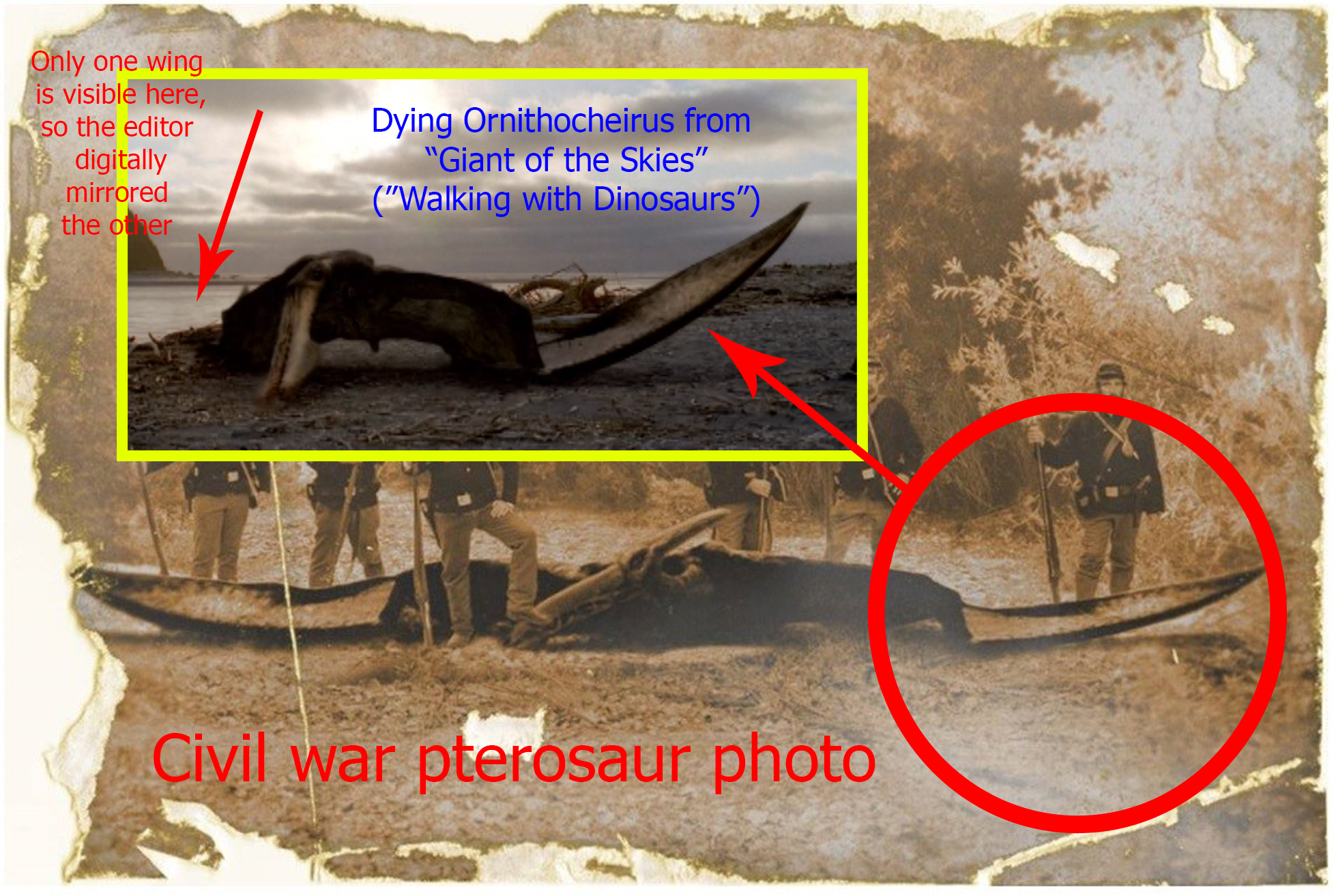
|
|
Fig. 32-d2. Video clip and annotations by Vasil Vasilev showing of a dying Ornithocheirus pterosaur in Walking With Dinosaurs TV series compared with the Ptp wings. |
Whereas Whitcomb and Paiva argue that the both the photo and creature in it are real, several lines of evidence conclusively show that neither are. Even before the Jan. 2018 Skeptoid podcast confired that the Ptp and FFf photos were both Haxan Films creations, and Vasil's discovery about the origin of the Ptp wings, the Ptp photo showed abundant evidence of being a fairly recent photo showing an unrealistic-looking pterosaur and extensive digital manipulation. Although the source of the Ptp creature's head is still unknown, compelling evidence indicates that Ptp wings were digitally produced from the CGI-generated wing of a dying Ornithocheirus pterosaur in the BBC series Walking with Dinosaurs, that the soldiers were merely Civil War reenactors, and that the background was digitally altered. In short, the Ptp photo is just one in a long line of fake photos showing a large pterosaur carcass posed with armed men.
Whitcomb attempts to explain away the last problem by suggesting such newspapers were only interested in war related stories. However, this is readily dispelled by the fact that many surviving copies of such papers, which are available on websites such as "Accessible Archives" , show that many other topics were also commonly covered, including sports, fashion, arts and leisure, commercial matters, and social events (UT, 2017). All such stories would be far more mundane than the downing of a giant flying monster. Indeed, there is little doubt that such a stupendous event would have been considered very newsworthy, as well as become the subject of much subsequent discussion and scientific interest (unless the soldiers buried it immediately, and never said a word about it, which seems highly unlikely). Yet there is no evidence that it was ever mentioned in any publication of the day, popular or scientific. Nor is there any information on what became of the carcass. That too seems telling, since many museums, schools, natural history buffs and collectors, etc., would surely have clamored to obtain such an astounding specimen, and been glad to pay handsomely for it.
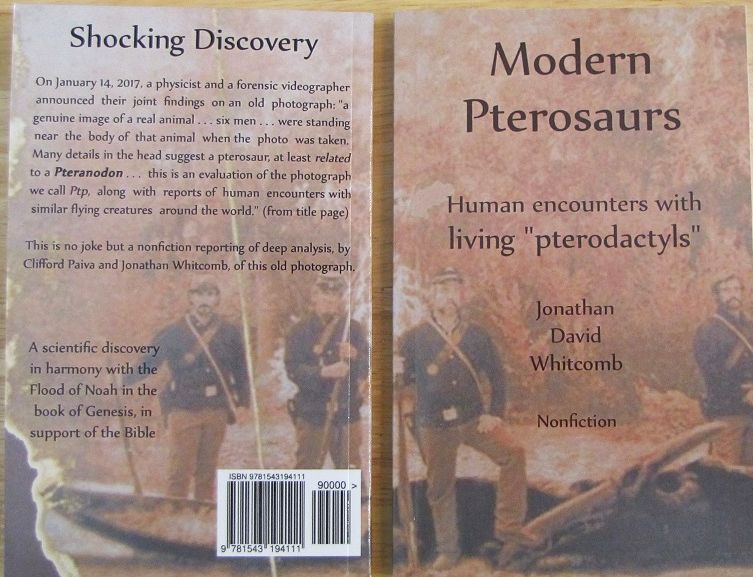
|
| Fig. 33a. John Whitcomb's 2017 Modern Pterosaurs book |
In early 2017 Whitcomb launched a major publicity campaign focusing largely on the Ptp photo - flooding the Internet with numerous articles, blog entries, and "press releases" declaring it to be proof of modern pterosaurs. This was on top of his scores of previous sites promoting "living pterosaurs." Indeed, it appears that Whitcomb has over two dozen web domains registered just for these purposes, and within them and other sites (by his own count) over 1000 articles and blog entries. While he seems to regard this as a positive achievement, it is academically questionable at best, since many of the articles rehash or overlap the same material, and the effect is that when someone does a web search on the topic of living pterosaurs (or even pterosaurs), his writings dominate the results. This makes it difficult to readily find and compare other writings or rebuttals on the issue, or to keep track of any new or altered claims Whitcomb makes. It also makes it difficult for Whitcomb to make necessary corrections when warranted. For example, as of Feb. 2018, some of his web pages still complain that I have not addressed many of his "best evidence," such as Wooten's and Hodgkinson's sightings, even though I had done so many months earlier. These problems are exacerbated by the fact that when Whitcomb criticizes me and other skeptics, he seldom properly cites or links to our writings.
Also of concern is the fact that in many of the "press releases" and blogs Whitcomb often refer to himself in the third person, and/or positively reviews his own articles and books as if they were independent, authoritative sources. In the past he sometimes used the pen names "Nathan Coleman" and "Norman Huntington" while doing this. Even though he no longer does, he still often promotes his views and writings in the third person, and sometimes leaves his own positive remarks or links to his other writings or books in the Comments section of a blog, then closes the comments.
In April 2017 Whitcomb published a little book (Whitcomb, 2017a) entitled Modern Pterosaurs: Human encounters with living "pterodactyls" (Fig. 33a), which focuses heavily on the Ptp photo. Perhaps as a sign of being rushed into print, MP contains no index or references. When he criticizes skeptical scientists and their writings (including mine) in it, he does not mention names (just initials or acronyms) or include proper academic citations. Calling my critique "bampp" (big anti-modern-pterosaur page) he advises that this skeptic "needs to get out of his imagination and open his eyes..." As he does on some of his web site, he complains that I wrote "31 paragraphs" criticizing his views but did not adequately addressing some of best evidence. I trust this expanded version does that. However, no matter how much I or others write, he and other "living pterosaur" proponents can always point to new sightings as better evidence, which is why scientists have no obligation to address any such claims, unless they are backed up by hard evidence, and the Ptp photo is hardly that.
Among the likely reasons Whitcomb and Paiva latched strongly onto the Ptp photo as proof of modern pterosaurs, besides YEC-driven motivations and confirmation bias, is that they evidently neglected to consult with any paleontologists or Civil War photo experts while evaluating the photo. Whitcomb often emphasizes that a "scientist" (Paiva) has confirmed the authenticity of the photo and anatomic correctness of the creature in it. However, as far as I know neither Paiva nor Whitcomb have any significant training, experience, or expertise in paleontology, let alone fossil pterosaurs. That does not necessarily prevent them from doing good research. It does mean that before sticking their necks out, it would have behooved them to seek input from others with expertise in these areas. . Even if they did not trust input from any mainstream scientists, they could still have consulted with one of the few YEC paleontologists, such as Kurt Wise.
It is also normal scientific protocol to publish a scientific paper before launching any publicity campaign, but evidently this too was not done in this case. What Whitcomb calls two previous "peer reviewed" papers (Whitcomb, 2009) did not even address the Ptp photo, and appeared in the Creation Research Society Quarterly, a staunchly YEC publication that apparently does not have the level of rigorous peer review of most mainstream scientific journals.
March 2019 UPDATE
In November 2018 Whitcomb published another little book, entitled The Girl Who Saw a Flying Dinosaur (Whitcomb, 2018e).
Aimed primarily at young readers (the back cover states "For readers 8-14 years old"). This 56 page booklet focuses
heavily on the 1971 sighting by Patty Carson (as discussed earlier), who was just six years old
at the time. Emphasizing this account seems rather odd, considering that even memories of adults have been shown to be
unreliable after only days or less, making decades old recollections from a little child suspect to say the
least. Whitcomb uses Carson's drawing (drawn and redrawn as an adult) as his cover illustration, despite anatomic oddities--
such as it showing one claw on the creature's wrist; whereas all known fossil pterosaurs had 3 clawed digits on each wrist (and
the single elongated finger bearing the wing membrane). Whitcomb also summarizes the Eskin Kuhn sighting and a few other
dubious living pterosaur reports, as well as the Papa New Guinea expeditions discussed earlier. As usual, he depicts all of
these as strong evidence for living pterosaurs, despite the lack of any supporting photographs or physical remains.
Curiously, he does not mention the PTP photograph, but continues to actively promote it as genuine on multiple blogs and web sites,
despite being made aware months earlier of the indisputable evience against it. So far the book seems to have been ignored
even by cryptozoology and creationist groups. Like his other books promoting modern pterosaurs, Whitcomb uses the label
"Nonfiction" on the cover of his latest book, and the back cover proclaims, "A True Story!" Of course, legitimate nonfiction
books do not usually carry or need such labels.
According to one of Whitcomb's web pages (Whitcomb, 2018c), he started acknowledging his error on Nov. 4, 2018, and apparently updated many of his pages around that time or shortly afterward. However, even today (June 27) at least two of his pages still promotes the PTP photo (Whitcomb, 2017q, 2018d). The first example To give Whitcomb the benefit of the doubt, this may due to the problem noted earlier: that he had installed so many largely redundant pages it makes it hard to keep track of all of them. On the other hand, I was able to find the remaining PTP promoting pages in minutes with Google searches, so it seems like Whitcomb could have also. Also, even his earliest retraction on Nov. 4, 2018 came several months after I informed of the definitive Walking with Dinosaurs evidence in July, 2018, over a year after Bruce Baryla (2017a) demonstrated that both wings were digitally produced, and over four years after his own partner Clifford Paiva (2014) provided evidence of the digital duplication of the wings and called that "consistent with the photo possibly being fraudulent." I supposed one could say "better late than never", but there are still some remaining curiosities.
One is that some of Whitcomb's pages continue to imply that the soldiers in the photo might be real. It is not clear why he does this, since it would not help his case in the least even if a fake pterosaur were superimposed on a photo of real Civil War soldiers. Whitcomb oddly focuses on the fact that the photographic perspective of the buckles is correct for real people, apparently forgetting that they could be real people but not real Civil War soldiers (just reenactors). Ironically, the belt buckles are actually strong evidence that the soldiers are reenactors, and not even good ones, since they are dressed in Union infantry uniforms, but are rectangular buckles (instead of the standard oval ones).
Another curiosity is that whereas Whitcomb often mentioned collaborating with Clifford Paiva in deciding that the PTP photo was authentic, his retractions make no mention of whether Paiva has clanged his views as well, Paiva's website continues to promote the PTP photo as of this writing (June 28, 2019).
Of more concern, Whitcomb seems not to have learned many lessons from his Ptp errors. First, he seems not to realize the negative implications about the soundness of his logic and reasoning ability, since obviously the dozens of arguments he made in support of the photo cannot be correct. Second, he seems not to realize what the Ptp being fake implies for the reliability of the many sightings he calls "credible." After all, he repeatedly claimed that he and others recalled seeing the PTP photo in books decades ago. Since we now know that those memories were innacurate, when he says (while making some of his retractions) that he still stands by signtings in his books, one must ask, on what basis? Afer all, they too rely on nothing but memories (often decades old memories), without any credible photos or a shred of physical evidence.
How much influence Whitcomb's promotions have had on the public and most YECs is difficult to say, partly because his dozens of largely redundant web sites and articles dominate search engine results on the topic of "living pterosaurs." However, many comments on cryptozoology sites have been skeptical or negative. Renown American cryptozoologist Loren Coleman rejected the authenticity of both the Ptp and HFf photos in a Cryptomundo website column (Coleman, 2007), and has expressed skepticism of Whitcomb's "living pterosaur" claims in general (Coleman, 2009a, 2009b). As far as I know no other leading cryptozoology researchers have endorsed either photo. This further reinforces the hollowness of Whitcomb's complaints about scientists being blinded by "dogmas of extinction," since most cryptozoologists not only have no such dogmas, but much of what they do involves searching for creatures that others think are likely extinct.
Nor do any major YEC groups such as ICR, AIG, or CMI have "extinction dogmas" or a-priori biases against living pterosaur claims (any biases would be in favor of them). However, as far as I know, none have clearly endorsed the idea of modern pterosaurs, let alone Whitcomb's claims about the Ptp photo. A 2017 book How Do Dinosaurs Fit in the Bible discusses pterosaurs, but makes no mention of allegedly living ones (Biddle, 2017). Moreover, at least one of Whitcomb's fellow LP promoters, David Woetzel, does not consider the Ptp photo convincing (Woetzel, 2017).
Although it pre-dates the Ptp photo flap, an excellent summary of "living pterosaur" claims is provided by Darren Naish in his book Hunting Monsters: Cryptozoology and the Reality Behind the Myths (Naish, 2017). PZ Meyers wrote an especially frank and hard-hitting critique of Whitcomb's claims on the Pharylingula Blog, with emphasis on his ethically questionable promotional methods.
Recently Whitcomb has attempted to rebut my critique by posting a variety of criticisms on a
number of his web pages, including claims that my review is largely a product of "confirmation bias" and "wishful
thinking," and that I deliberately misrepresented some of his views and statements. However, none of these accusations hold up
to careful examination, as addressed further in Appendix D. I invite readers to carefully compare our respective
writings and judge for themselves their relative merits, and whether Whitcomb's criticisms better apply to mine or his own.
Other Reasons to Doubt "Living Pterosaurs"
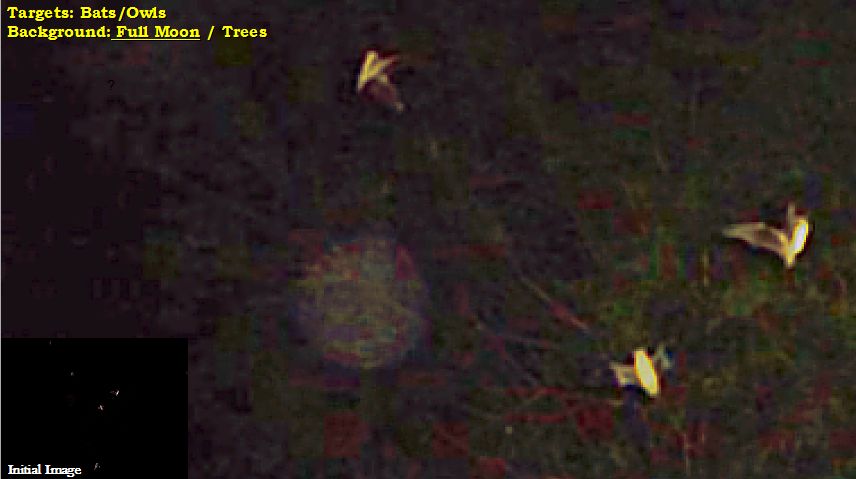
|
| Figure 33b. Photo of bats flying in moonlight, from C. Paiva's blog |
Years ago I suggested to Dave Woetzel that he give PNG locals cameras in order to increase changes of recording any pterosaurs there. Recently he informed me that he had done this, but that so far it has not been productive. Likewise, Whitcomb reportedly gave some cameras to locals, also with no significant results, and in 2013 set up a game camera in his backyard in Lakewood, CA, in an attempt to film a pterosaur after one was "sighted" nearby, again with no results (Whitcomb, 2014, p. 320). The lack of any photos from PNG seems especially telling, since Whitcomb implies that Ropen sightings are quite common by locals there. On his "Woetzel-Guessman Expedition" web page he notes that one of the locals sees Ropens flying over Opai "about once per month."
In his 2017 book (p. 8) Whitcomb suggests that a major reason for the shortage of good pterosaur photos is that people often forget that they have a camera or camera-ready cell phone with them. However, many people do remember, and the satellites and other automated cameras don't have to. Moreover, in regards to PNG sightings, it seems implausible that the locals would constantly "forget" to take pictures of the creatures they supposedly see on a regular basis, and which they know Whitcomb and others are dying to get clear evidence of. Whitcomb also suggests (p. 10) that in the U.S. many sightings are from moving cars, which would make photography difficult. However, most sightings are not from cars, and those that are would tend to be inherently less reliable, since the witnesses would often need to deal with the movement of both the car and the creature.
While on the subject of photographs, it should ne noted that even though the handful of putative photographs of living pterosaurs offered so far are all likely fakes, in view of ever-improving technologies, from advanced CGI and photo editing capabilities, to sophisticated model making and staging capabilities, it may become increasingly difficult to determine whether a particular photo or video is authentic, or exactly how it was made. In cases of alleged cryptids and other extraordinary claims, this will make the need for compelling physical evidence all the more vital. Some have claimed that certain historic artworks or literature may help their case in this regard, but as will shown, the examples often proposed are typically very subjective and questionable.
The nocturnal hypothesis also begs the question of where most pterosaurs go during the day. Whitcomb suggests that in PNG they dwell in high cliff overhangs which the locals call "caves" (Whitcomb, 2017a, p. 22). However, this explanation doesn't fly for heavily populated areas, especially most U.S. states, which either don't have high cliffs, or where any caves large enough to hide large pterosaurs have been well explored by spelunkers, naturalists, and scientists. In a web page entitled, "Can Ropens Hide in Caves" Whitcomb (2014b) argues that smaller ones could bunk in "holes" in rock faces. He states that we should remember that "not all of those featherless flying creatures are gigantic... A small hideaway room on the side of a cliff is better than being homeless.." However, Whitcomb himself claims that most living pterosaurs range from large to huge, and he has to account for where they all hide during the day, not just the smaller ones. He declares, "potential spots could number in the billions, if ropens were very careful about concealing nests and they were built both inside and outside caves." However, no matter how "careful" they were, it is simply not credible to imagine that entire populations of giant pterosaurs (and populations would be needed to sustain the species) could build nests (presumably large ones) even "outside" caves, without any of the animals or their nests, eggs, and hatchlings ever being seen or documented.
Whitcomb suggests that pterosaurs may not breed in all areas where they are seen, and may sometimes fly large distances, even over entire continents and oceans. However, this only moves the problem from one area to another, plus creates new problems. If giant pterosaurs are doing such things, it is odd that they are never detected by pilots, satellite cameras, or radar. Proposing that they fly low to the ground would not help, since it would exacerbate the problem of why more people do not report and photograph them, and even night flights of large pterosaurs would be detected by radar. After all, some are claimed to be the size of small planes.
Whitcomb's assertions also involve a "Catch-22". He suggests there are too many sightings for all to be misidentifications of hoaxes, yet the more sightings there are, the harder it is to explain the lack of good photos and physical evidence. Indeed, even if the Ptp photo were legitimate, and even some of his sightings are, he seems to have a serious problem explaining why no other credible photo has surfaced in over 150 years, and why no credible photos showing a living pterosaur has ever been produced, let alone any tracks, carcasses or bones.
Worsening the problem even further, Whitcomb makes the astounding claim: "During the past 50 years, over the entire planet, over 7,000,000 persons have encountered a living pterosaur at night" (Whitcomb, 2014, p. 306). Lest one wonder if this could be a misprint, on the next page he spells it out, writing: "Seven million eyewitnesses of live pterosaurs!" He bases this on some fuzzy math and his assumption that far more people have seen living pterosaurs than report them. He even states on the next page that his estimate was "conservative", although elsewhere on the same page he states (perhaps forgetting his earlier estimate, or perhaps making a typo this time), that "about 70,000 persons worldwide" have seen pterosaurs. That's only 1% of his first estimate, but orders of magnitude greater than the "less than 200 credible reports" he reportedly collected, and 200 more than the number I and most scientists consider reliable reports of living pterosaurs. In the Comments section of a YouTube video posted by Whitcomb earlier this year (2017d), he offers yet another estimate of the number of people who have encountered some kind of living pterosaur, announcing that based on his "investigation into probabilities involved in worldwide eyewitness sightings" his "startling conclusion" is that the number is "between 7 million and 128 million." I'm not sure "startling" is the only or best adjective that applies here, but I'll leave it at that.
Alleged Pterosaurs on Artifacts and Ancient Artwork
A petroglyph at Black Dragon Canyon, Utah (Fig. 34), has been suggested by Dennis Swift (1997) and other YECs to depict
a pterosaur seen by Native Americans. However, without selective highlighting the image is ambiguous at best, and is
interpreted by archaeologists to not even be a flying creature (Senter, 2012). Even if it were, there is nothing about it to
favor a bird over a pterosaur, and the supposed wings are very odd and unsymmetrical, and don't look much like bird
or pterosar wings. Other pictographs or petroglyphs alleged to show pterosaurs or dinosaurs are similarly doubtful (Kuban, 2013).
Jonathan Whitcomb, Carl Baugh, Don Patton, and Dennis Swift have claimed that pterosaurs and dinosaurs are depicted in ancient figurines from Acambaro (Figure 35a), Mexico and on ancient pottery found near Ica, Peru (Figure 35b), often referred to as the "Ica Stones" (Whitcomb, 2015b).
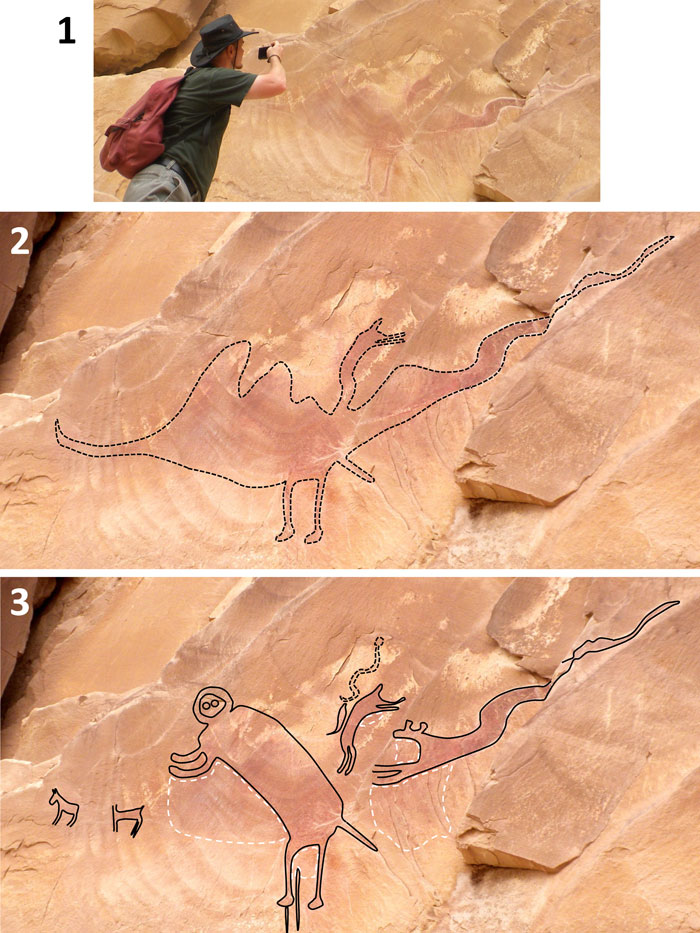
|
|
Fig. 34. Pictograph from UT claimed by some to be a pterosaur
Image 1 (top) shows unhighlighted image. |
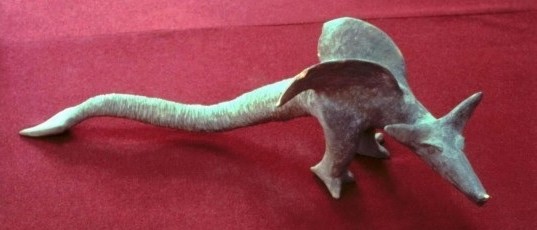
| ||
|
Fig. 35a. Acambaro figurine, interpreted by Whitcomb as a "Crude depiction of a long-tailed pterosaur."
| 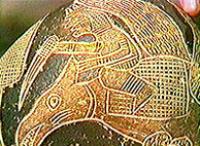
Fig. 35b. Ica stone showing man riding a supposed pterosaur
| |
"Dating both the Acambaro figurines and Ica stones has proved inconclusive. Unfortunately, both the stones and figurines have been removed from their original settings, making reliable dating difficult, if not impossible. In the Peruvian case, the curator and discoverer of the artifacts, Javier Cabrera, a medical doctor, refuses to reveal the location of a cave where he allegedly found the stones, leading archeologist Neil Steede, who investigates both cases on Cote's Jurassic Art, to question the doctor's story. So, we come to the end of the tale, and we still don't know what's behind the Acambaro dinosaurs."(Blanton, 1999)In an article by Robert Todd Carroll we find additional reasons to question the Ica stones:
The Ica stone craze began in 1996 with Dr. Javier Cabrera Darquea, a Peruvian physician who allegedly abandoned a career in medicine in Lima to open up the Museo de Piedras Grabadas (Engraved Stones Museum) in Ica. There he displays his collection of several thousand stones. Dr. Cabrera claims that a farmer found the stones in a cave. The farmer was arrested for selling the stones to tourists. He told the police that he didn't really find them in a cave, but that he made them himself. Other modern Ica artists, however, continue to carve stones and sell forgeries of the farmer's forgeries. In 1975, Basilio Uchuya and Irma Gutierrez de Aparcana claimed that they sold Cabrera stones they'd carved themselves and that they'd chosen their subject matter by copying from "comic books, school books, and magazines" (Polidoro 2002b).
Another inconsistency regarding the Ica stones concerns the question of why some of the stones supposedly show images of surgery, telescopes, powered flight, and other sophisticated technologies, yet no artifacts demonstrating or even hinting at such things exist outside the Ica Stones themselves. That raises the related question of how such a supposedly advanced civilization had no other means of recording such activities or communicating in general other than scrawling cartoon-like images on rocks. Further evidence against the reliability of the Ica stones is discussed by Matthews (2007) and Meyers (2005).
Thus, unless the proponents of the Ica Stones and Acambaro figurines provide better evidence of their authenticity, they seem dubious at best. Indeed, even most creationist and cryptozoologist leaders have refrained from endorsing such artifacts as credible evidence that humans coexisted with dinosaurs or pterosaurs.
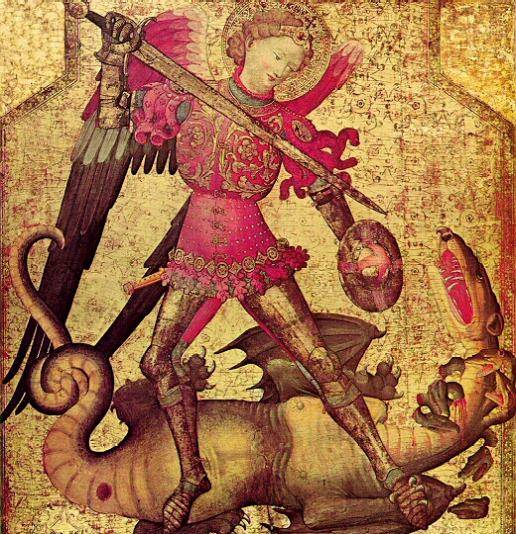
|
|
Figure 36. Painting of St. Michael and the "dragon," by unknown Spanish painter, c. 1405, showing little resemblance to a pterosaur or dinosaur |
Dragon Legends
Whitcomb, Woetzel, Baugh, and other living pterosaur advocates join many other YECs in suggesting that dragon legends from
Europe and China may help support the idea of living or recently living pterosaurs and dinosaurs. Whitcomb even suggests
that "fire-breathing" dragons may refer to bioluminescent pterosaurs. However, besides the latter being quite a stretch,
simpler explanations exist for dragon legends, including the tendencies of many cultures to combine features of various
modern animals such as snakes, and lizards (including large monitor lizards such as "Komodo Dragons", and exotic forms like
Dracos or "flying lizards") into more fantastic mythical forms (Kuban, 2013).
Whitcomb notes that both Celtic "dragons" and pterosaurs often show featherless wings and long tails with diamond shapes at the end. However, he ignores multiple major differences. For example, most dragon depictions show scales instead of hair, bat-like (strutted) wings rather than pterosaur-like wings, four legs instead of two, multiple horns, and other features not found on any known pterosaurs (Whitcomb, 2011f). If dinosaurs or pterosaurs were involved in these legends at all, it may be that some were inspired or influenced by the occasional finding of fossil remains. In other words, in a sense Whitcomb and associates may be right that dragon myths may relate to dinosaurs or pterosaurs, but fossil ones rather than living ones. Indeed, some shops in China still sell dinosaur teeth, claws, and bones as "dragon" remains.
David Woetzel has a web page entitled "Dragons in History" promoting the idea that dragon legends support the idea of modern dinosaurs and pterosaurs (Woetzel, 1999-2017). He relates several dragon legends, but in none of them does the described creature bear more than a vague similarity to fossil dinosaurs or pterosaurs. Moreover, to imagine that real dragons, pterosaurs, or dinosaurs were terrorizing local European or Asian populations only begs the question of why no historic artworks or literature from either region clearly describe and depict them realistically (further discussed below), and why no carcasses or skeletons of the "slain" beasts were preserved (all known pterosaur remains are fossils and tracks in Mesozoic rock strata).
By YEC reasoning and the type of evidence accepted, one could as easily argue that in past centuries people regularly saw griffins, Cyclopes, unicorns, sphinxes, and mermaids. More likely, these mythical creatures were also based on imaginative combinations of various living animals and/or fossil remains (Kuban, 2013). For example, the Cyclops legend is believed to relate to the finding of mammoth and mastodon skulls, whose merged eye sockets were probably interpreted to house one giant eye.
Suggestions by a few YECs that a Bible verse referring to St. Michael slaying the dragon (Figure 36), or depictions of St. George slaying a dragon, are based on actual slayings or real "dragons", dinosaurs or pterosaurs, are as misguided and unfounded theologically as they are scientifically. Depictions of St. George slaying the dragon are based on nothing more than fanciful and often contradictory stories from Medieval folklore. One Bible verse mentions St. Michael slaying a dragon (Revelation 9:7); however, the very next verse clarifies that the dragon is "the old serpent called Satan." While some old paintings depict St. Michael slaying an actual dragon (Figure. 36) others show him slaying the devil as a winged humanoid. None closely resemble dinosaurs or pterosaurs. Other Biblical passages offered by some as evidene of "living pterosaurs" are discussed below.
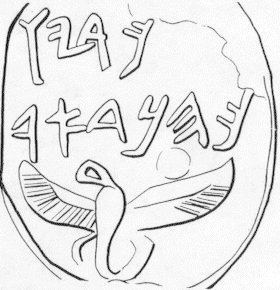
|
|
Figure 37. Seal with alleged "flying serpent" showing bird-like wings. |
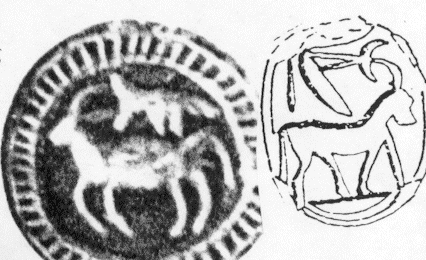
|
|
Figure 38. Seals from Israel imagined by John Goertzen to show pterosaurs attacking an ibex |
Creationist John Goertzen has a website entitled "Revolution Against Evolution" advocating the idea of living and recent pterosaurs, suggesting that the Bible and other ancient writings refer to such creatures. However, all of the literature passages cited seem to require very speculative interpretations to support a pterosaur reference. For example, Goertzen states: "The spiritual and symbolic knowledge of pterosaurs is found primarily from the teaching of the Lord Jesus Christ Himself when speaking with Nicodemus (Jn. 3:14)." However, John 3:14 simply refers to Moses lifting up a "serpent" which most scholars assume is a snake, not a pterosaur.
Goertzen declares that the scientific basis for recent pterosaurs is "established by unmistakable artifacts that depict morphological details," including various Egyptian artifacts and seals. However, none of those he shows depict clear pterosaur images. In fact, some appear to show feathered wings (Fig. 37) and thus resemble birds more than pterosaurs, whereas others look more like generalized animals than pterosaurs (Fig. 38). Ironically, the lack of clear pterosaur images in Egyptian art actually undermine his case. Many animals are depicted with significant detail in various Egyptian artworks--in some cases allowing individual species to be identified--but none show clear pterosaurs.
On his website Goertzen also promotes various "living pterosaur" claims from other YECs, and notes that "Sightings of pterodactyls in Mexico are so frequent that creationist missionary John Pendleton is setting up a trap on a rooftop to see if they can be photographed" (Goertzen, 215) In a video interview by Stephen Meyers (2013), Pendleton says that he set up three motion detecting cameras. As they say, "Good luck with that."
Conclusions
There is no reliable evidence of living or recently living pterosaurs. The few researchers who argue
otherwise appear to be largely motivated by anti-evolutionary views, and primarily rely on unverifiable
anecdotal "sightings," dubious or ambiguous artifacts and artworks, and questionably interpreted Bible passages.
Woefully lacking are any compelling
photographs or physical remains. The relatively few photos depicting supposed modern pterosaurs range from
highly dubious to demonstrably fraudulent. None are not considered convincing even by most YECs and cryptozoologists.
The single photo (Ptp) promoted for years as genuine and compelling by Whitcomb and Pavia shows abundant evidence of being
a relatively recent (c. 2000) fabrication comissioned by an entertainment film company, which was finally
acknowleded as such by Whitcomb in late 2018.
If populations of large pterosaurs really did inhabit several countries and
many U.S. states as some claim, we would expect far more clear and convincing photos and forensic
evidence. Despite these and other reasons to be highly skeptical of "living pterosaurs", if they were
someday verified, it would be a wonderful scientific discovery, but do nothing to undermine mainstream geology.
In the meantime, those who actively promote modern pterosaur claims based on highly questionable evidence
will probably do more to undermine than bolster YEC credibility.
To avoid confusion by creating a new numbering system with Whitcomb's list of 3 possibilities for the Ptp photo, I will keep the numbers but refine them with sub-numbers and further explanations.
Whitcomb's list:
1) A real animal
2) A physical model
3) A digital construction
Expanded possibilities that Whitcomb and Paiva should have considered (several options in 2 and 3 are not mutually exclusive):
1. A real animal in a real Civil War photo (contradicted by several lines of evidence)
2. A physical model or partial physical model with later editing
2A. Staged photo with real Civil War soldiers and large pterosaur model
2B. Staged photo with Civil War reenactors and large model pterosaur
2C. Photo of Civil War actors with inserted model pterosaur image (from other source or small model)
2C1. Manually inserted (probably pre-1980)
2C2. Digitally inserted (post-c.1980)
2D. Real Civil War photo with manually or digitally inserted model pterosaur image (largely ruled out)
3A. "Digital Construction" - Whitcomb's term for a complete Photoshop creation, evidently implying digit insertions of both soldiers and creature (unlikely)
3B. Digital editing to add, enhance or alter features (which could be done subsequent to most of the above). 4. Combinations of the above options, such as staged photo with actors, an inserted pterosaur image, and subsequent digital editing of the pterosaur and photo background.
Whitcomb not only failed to consider many of these possibilities and combinations, but promotes the most unlikely one (Option 1) while shooting down the essentially straw-man Options 2A and a total Photoshop creation (3A alone). As it turns out, the evidence points to a combination of options 2 and 3 done around 2000, involving Civil War reenactors, a fake pterosaur (either a model or image from another source), and digital editing.
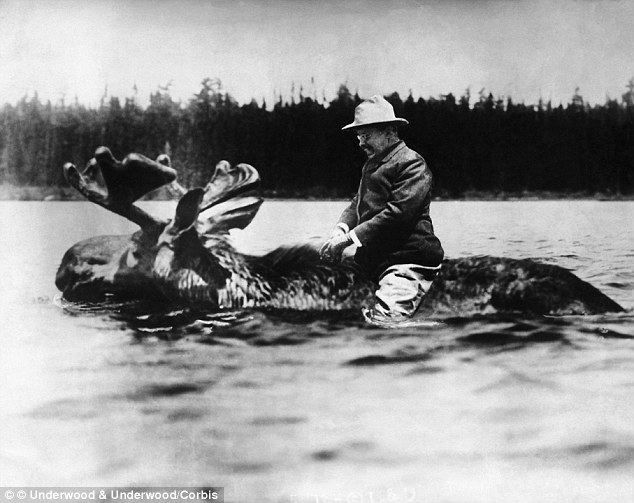 |
|
|
Figure C1. Theodore Roosevelt riding a moose. A manually faked photo by and Underwood Studios In September 8, 1912 New York Tribute Newspaper | |
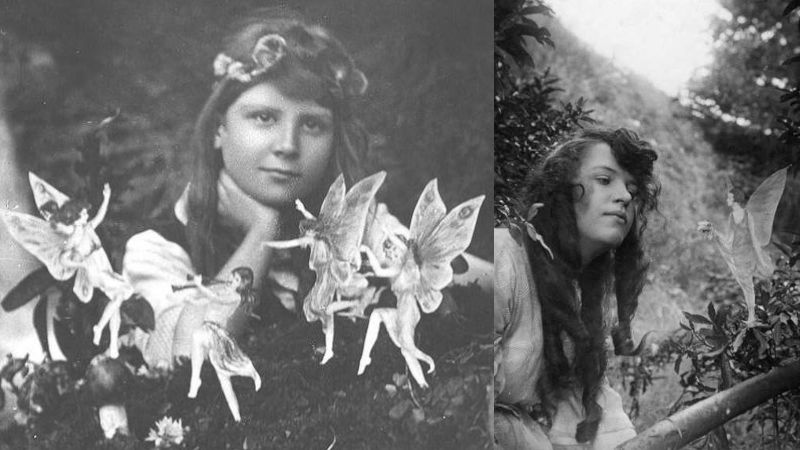 |
|
|
Figure C2. 1917 photos of "Cottingley Fairies" with Frances Griffiths (age 10) and Elsie Wright (age 16) |
Another famous photo hoax during this time was the famous 1917-1920 case of the "Cottingley Fairies, where two young girls in England claimed to have photographed tiny winged humanoids in their garden (Figure C2). Some spiritualists, photo experts, and even Sir. Arthur Conan Doyle, declared the photos real, since the girls seemed sincere and "credible", and they could find no evidence that the photo prints or negatives had been tampered with. In the 1980's the women finally confessed that it was a hoax (Sakulich, 2017). They had simply photographed themselves with paper cut-outs of the creatures mounted on hat pins.
During this same time period (early 1900's) many fake or "tall tale" photographs were produced by several small companies and creative individuals using a variety of manual editing techniques. These included carefully inserted and overlaid images, retouched negatives and prints, multiple exposures, and sometimes constructed props or staging sets (Brook, 2012). Two prolific creators of such photos were William "Dad" Martin, and Alfred Stanley Johnson, Jr., who began working around 1908, each of whom produced dozens of post cards or "boast cards" featuring subjects such as giant fish, farm animals, and crops. In the 1930's common subjects include insects such as giant grasshoppers, as they were common pests in the Great Plains during that period. Examples of such photos are shown below.
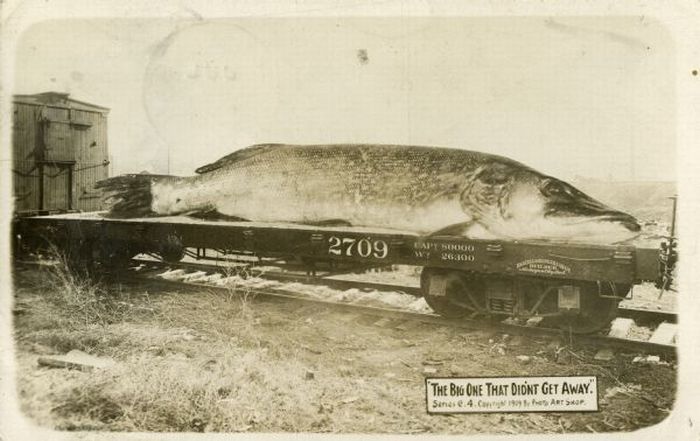 |
|
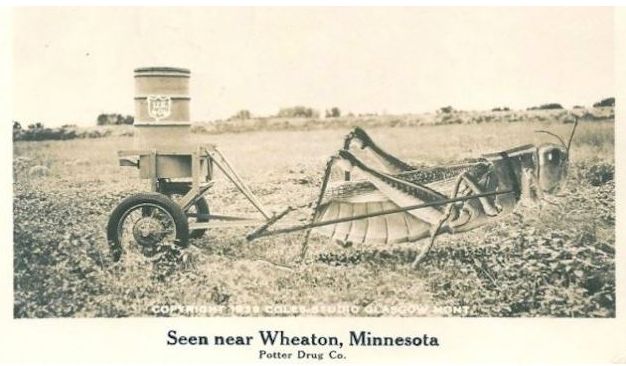 |
|
Figure C4. 1909 "Tall tale" post card |
Figure C5. 1909 William Martin "boast card" |
Figure C6. 1938 "Tall tale" post card |
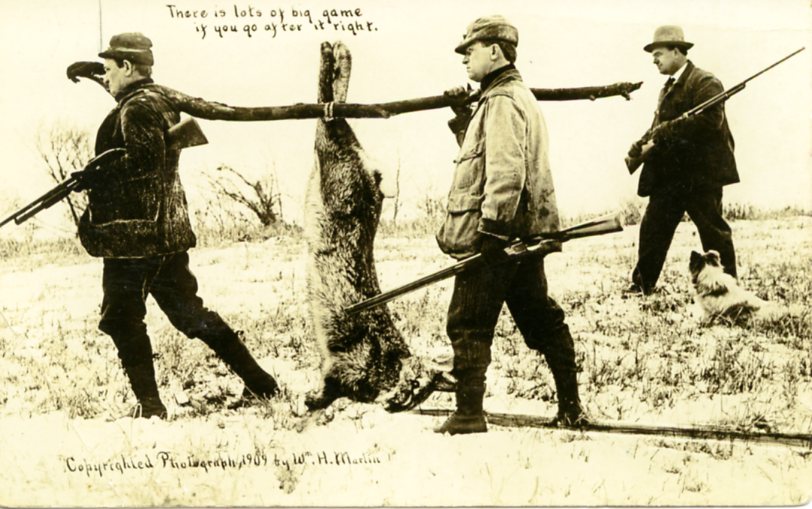 |
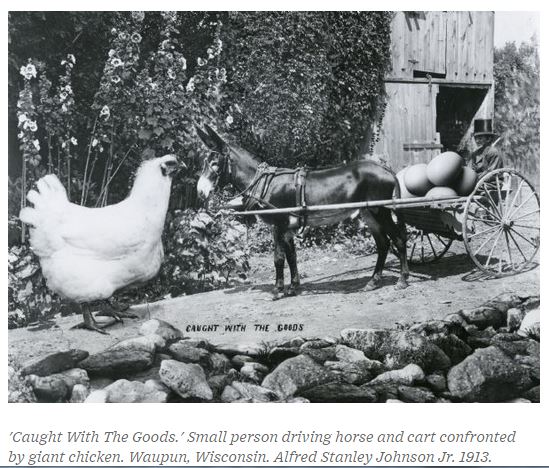 |
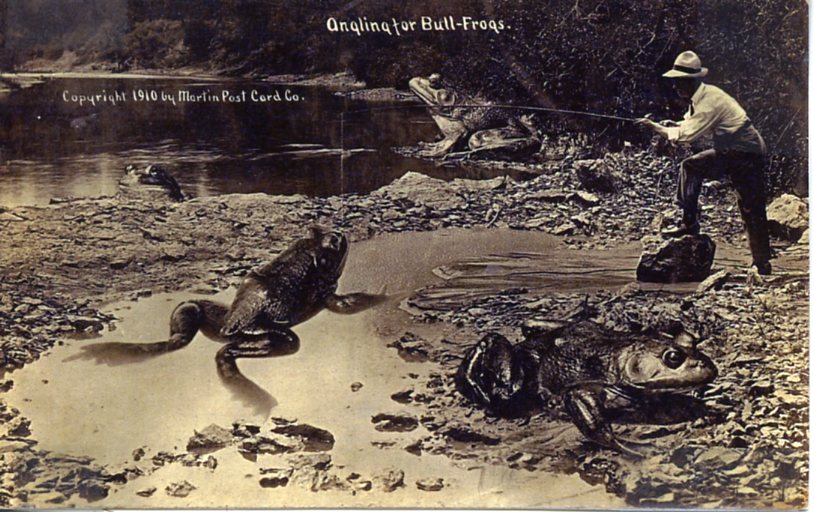 |
|
|
Figure C7. 1909 "Tall tale" post card |
Figure A8. 1913, Alfred S. Johnson, Jr. post card |
Figure A9. 1910, William Martin post card |
For example, Whitcomb (2017k) accuses me of misrepresenting the Duane Hodgkinson (DH) sighting. He asserts that I falsely called DH's friend George a biology professor, and suggests that this was entirely a product of my imagination, stressing that it could not be a "simple error." However, Whitcomb himself calls George a biologist (SFR, p, 28) and implied that he taught school, making my inference that he was a biology professor entirely reasonable. Indeed, on the same page Whitcomb states, "George should have had his mind on learning something, yet it seems his mind was set on teaching". Later on the same page Whitcomb further suggests that George was too biased to admit that he had seen a pterosaur, even though Whitcomb admits that he never interviewed George. So, if anyone was overspeculating, it was not me. Nevertheless, in deference to Whitcomb's comments, I have gladly removed the identification of George as a biology professor. In contrast, Whitcomb continues to imply on multiple web pages that DH and his friend George both saw a pterosaur, despite George's denial.
Where he does admit Geroge's denial, and makes the comment about him being "distracted by thoughts of teaching" Whitcomb attempts to justify his imaginative speculation by asking, "what else can explain the friend's reaction?" I would say, how about his not seeing a pterosaur? Remarkably, Whitcomb states, "Contrary to what the critic [referring to me] has written... I never said or insinuated that DH's army buddy was distracted and so did not see the animal". Attempting to obscure the apparent contradiction, Whitcomb states, "Let's look at what is actually printed in SFG (4th edition)...". He then quotes passages before and after the ones that demonstrate the apparent contradiction. To use Whitcomb's own term, this seems hard to explain as a "simple error." I myself do not claim to know what either man saw. However, what seems clear is that Whitcomb's implying that both men saw a pterosaur based on DH's statements, while dismissing or (more often) failing to even mention Geroge's denial seems to fall far short of fair and objective reporting.
An especially odd criticism of Whitcomb is that I did not communicate with Duane Hodgkinson (Whitcomb, 2017). Even if I had wanted to, I could not have, since I did not begin my research on Whitcomb's claims concerning DH until 2016, whereas Hodgkinson died in Sept. 2015. Whitcomb knows that, since he wrote a tribute to DH's upon his passing (Whitcomb, 2017p). Whitcomb also complains that I did not contact other eyewitnesses of living pterosaurs, but that too seems disingenuous, since he provides no contact details for his reported eyewitnesses, and a number of them are also reportedly deceased. Moreover, his criticism misses a major point of this critique, which is that anecdotal reports without supporting empirical evidence are of little value, for all the reasons noted earlier. I am glad to stipulate that many alleged eyewitnesses are probably sincere, so there would probably be little to gain from seeking contact with them. Indeed, debating subjective "credibility" levels of eyewitnesses is moot, since without corroborating empirical evidence, they are no more scientifically significant than reports of mermaids, leprechauns, or space aliens.
Another odd criticism that Whitcomb repeats many times in his books and web pages is that "Westerners" and "Western scientists" are closed minded and biased against his claims. It appears to smack of anti-western prejudice (I assume he is suggesting that Asian science and scientists are inherently superior), which seems ironic considering that Whitcomb himself is a "westerner." Moreover, I don't know of any evidence that reputable scientists in the eastern world endorse Whitcomb's claims any more than western scientists.
As to Whitcomb's claim that my arguments are based on mere "confirmation bias" and "wishful thinking" I will leave to the reader to judge whether that criticism better fits his writings or mine. Whitcomb claims I could find no examples of confirmation bias in his writings, and yet I have explicitly identified a number of such examples, and implied many others. Besides the DH case discussed above, other obvious and severe cases include his depicting a man hearing nothing more than screeching noises in his backyard as a "credible encounter" and "secondary evidence" for living pterosaurs, and his suggestion that unusually large "Marfa lights" represent massive mating rituals by glowing pterosaurs. Many other examples include his depicting as "credible" sightings that entail many ambiguities and inconsistencies while lacking any corroborating photos or physical evidence, and his actively promoting alleged "evidences" for the Ptp photo (such as dubious "blood" and "props") that range from moot and weak to demonstrably false, while ignoring or dismissing many strong lines of contrary evidence.
Whitcomb (2017o) ridicules the length of this critique and the number of times I mention his name, showing specific word counts on each. However, since he is by far the most prolific advocate of "living pterosaurs" and one of only a few individuals actively promoting the Ptp photo, I could hardly have addressed his many claims about them in a thorough manner without providing considerable detail and mentioning his name many times. Ironically, in the past he complained that I and others did not adequately his best sightings or Ptp evidence, so he can hardly have it both ways. Moreover, despite this review being considerably longer than most, it is only a fraction of the volume of LP promoting material in Whitcomb's three printed books, one eBook, two CRSQ articles, and over 10000 web pages and blog entries on the subject. Even the number of times I mention his name is, ironically, far less than the number of times he refers to himself while promoting his views and writings, often in the third person. Moreover, my review is also all in one place, allowing readers to readily find it and any updates as they are made. In contrast, Whitcomb's many separate and often overlapping web pages and blog postings make it difficult for others to even keep track of what he is claiming, and where and when. Moreover, Whitcomb's carpet-bombing tactic causes his many redundant pages to clog searches engine results, and push out dissenting articles (possibly the reason he engages in it), which is widely regardled as an academically improper practice.
In a recent web page Whitcomb (2017g1) implies that "the most vocal skeptic" (referring to me) proposed a 19th century "model conjecture," which is patently false; what I actually stated was that the photo was probably staged with Civil War actors and a pterosaur model or inserted image in the 20th century or 21st century. More recently this has been narrowed down to a c. 1998-2000 fabrication by Haxan Productions.
Whitcomb (2017g1) comments that because I mentioned that the creature resembles a Pteranodon, that he and Paiva "have stated something very similar to what Kuban states or implies" (Whitcomb, 2017g), and dismisses my "two lists" as "irrelevant." However, as anyone can readily verify, what I stated was actually very different from what Paiva and Whitcomb have claimed, as lists he dismisses as "irrelevant" and associated analysis amply demonstrate. Whitcomb implies I only refute the creature being an actual Pteranodon rather than a similar pterosaur, whereas I actually described how the carcass differs from both a Pteranodon and from any real pterosaur.
Another odd criticism by Whitcomb (2017k) is that after I corrected my initial error about the Ptp photo being a FreakyLinks hoax, he states that he found no evidence of a "transition stage" in my article updates, where I simply admitted a mistake but didn't "proclaim" that Ptp was a hoax. He states, "That in itself is very suspicious." I'm not sure why he would expect such a transition "stage" or find it's lack suspicious, since as soon as I viewed the Ptp photo, I regarded it as a likely hoax. So it was entirely fitting for me to say so promptly, and give reasons why. What seems more is suspicious is Whitcomb's apparent tendency to see nefarious motives even in the most innocuous and appropriate actions by me or others. Similarly troubling is his tendency to belabor minor and moot points, while ignoring or dismissing compelling evidence against his claims, and his not making necessary timely corrections even after plain errors are pointed out (such as his U & U photo claims).
Anderson, Chuck, 2017. Modern Day Sightings of Strange Flying Creatures, "Discovery World" Web article at: https://www.discoveryworld.us/dinosaur-world/modern-day-sightings-of-strange-flying-creatures/
Arkowitz, Hal, and Lilienfeld, Scott O. 2010, "Why Science Tells Us Not to Rely on Eyewitness Accounts" Scientific American, January 1, 2010. Web version at: https://www.scientificamerican.com/article/do-the-eyes-have-it/
Ashley, T. R. 1993. The New International Commentary on the Old Testament, The Book of Numbers, Eerdmans, USA, pp 405-406
Aym, Terrence, 2010. "Jurassic Park in New Guinea? Not quite, but close..." Salem-News.com article at: http://www.salem-news.com/articles/august122010/live-dinosaur-ta.php
Aym, Terrence, 2012. Stunning Evidence of Living Pterodactyls. Web article at: http://beforeitsnews.com/alternative/2012/04/stunning-evidence-of-living-pterodactyls-2064568.html
Babsje (screenname), 2013. "It's an Effing Pterodactyl" Bellowed the Fisherman, Web article at: https://babsjeheron.wordpress.com/2014/07/13/its-an-effing-pterodactyl-bellowed-the-fisherman/
Barnes, Derek, 1998. "How Many Pterodactyls Did You Kill in the War, Daddy?". Website article at: http://www.haxan.com/archived/freakylinks/WWWFRE~1.COM/FREAKO~1/TAILS_~1/THUNDE~1.HTM
Baryla, Bruce, 2017a. There is no evidence Underwood & Underwood published John David Whitcomb's "Civil War Soldiers and Pterosaur" photo. Web article at: http://web.newsguy.com/bruceb/underwoodfake.htm
Baryla, Bruce, 2017b. Incontrovertable Proof that the Civil War Soldiers and Pterosaur" photograph claims to be authentic by John David Whitcom and Clifford Paiva is a modern "photoshopped" image. Web page at: http://web.newsguy.com/bruceb/whitcombfake.htm
Baryla, Bruce, 2017c. How and Why the "Civil War Pterosayr" photo promoted by Johanthan David Whitcomb and Cliff Paiva was really made." Web article at: http://web.newsguy.com/bruceb/civilwarpterosaurrealstory.htm
Baugh, Carl E., 1989. Panorama of Creation. Hearthstone Publishing, Ltd.,
Div. of Southwest Radio Church, Oklahoma, OK. pp. 19-20.
Baugh, Carl E., 1989b. Article by David Bassett at Baugh's Creation Evidence Museum web site at www.creationevidence.org. Bassett states that the great Flood of Genesis took place "definitely 4,300-4,400 years ago".
Biddle, Daniel A. 2017. How Do Dinosaurs Fit into the Bible?, Genesis Apologetics, Zondervan. 82 pages.
Blanton, John, 1999. Newsletter of North Texas Skeptics, October 1999.
"Blubabalu.blogspot.com" (date uncertain). Website at: https://www.pinterest.com/pin/260364422177946034/
Brook, Mike, 2012. Early 1900s Postcards Show Off Primitive 'Photoshopping' Skills. Web article at: https://www.wired.com/2012/08/primitive-photoshop-postcards/
Bunnel, James, 2009. Hunting Marfa Lights. Lacey Publishing Co; 2nd printing edition, 302 pages.
Castro, Joseph, 2016. Pterodactyl, Pteranodon & Other Flying 'Dinosaurs'. "Live Science" web article at: http://www.livescience.com/24071-pterodactyl-pteranodon-flying-dinosaurs.html
Chaffey, Tim, 2016. Has the Ark Been Found? Answers in Genesis web article at: https://answersingenesis.org/noahs-ark/noahs-ark-found/has-ark-been-found/
Chant, Ian, 2012. You Remember That Wrong: Brain Distorts Memories Every Time It Recalls Them. Web article at: https://www.themarysue.com/memory-distortion-in-brain/
Chorvinsky, Mark, 2000. Shooting a Monster: The Tombstone Epitaph. Strange Magazine, Vol. 21. Web version at: http://www.strangemag.com/strangemag/strange21/thunderbird21/thunderbird1_21.html#
Cline, Austin, 2017. Eyewitness Testimony, Memory and Psychology: Human memory is unreliable and so is eyewitness testimony. Web article at: https://www.thoughtco.com/eyewitness-testimony-and-memory-250498
Coleman, Loren, 2007. Comments at the Cryptomundo website at: http://cryptomundo.com/cryptozoo-news/c-w-dinos/
Colemen, Loren, 2009a. Creationist Imagines Pterosaurs Soaring Over America. Web article at:
Colemen, Loren, 2009b. Creationist Imagines Pterosaurs Soaring Over America. Web article at:
CreationWiki, 2015. Ropen. Web article at: http://www.creationwiki.org/Ropen
Dobrin, Arthur, 2013. Am I Right? Your Memory Isn't What You Think It Is. Web article at: https://www.psychologytoday.com/blog/am-i-right/201307/your-memory-isnt-what-you-think-it-is
Doolan, Robert, 1993. Are dinosaurs alive today? Where Jurassic Park went wrong! Creation 15(4) (Sept.): 12-15. Web version at: http://www.answersingenesis.org/creation/v15/i4/dinosaurs.asp
Drinnon, Dale A., 2011. Greater Imperial Woodpecker (New Category). Web article at: http://frontiersofzoology.blogspot.com/2011/05/greater-imperial-woodpecker-new.html
Drinnon, Dale A., 2012. "Surviving Plesiosaurs and Pterosaurs Part 1." Frontiers of Zoology. N.p., 16 May 2012. Drinnon expressed similar views on Web. 21 June 2014 at: http://frontiersofzoology.blogspot.com/2012/05/surviving-plesiosaurs-and-pterosaurs.html
Dunning, Brian. 2018, "The Civil War Pterosaur." Skeptoid Podcast. Skeptoid Media, 9 Jan 2018. Available on web at: http://skeptoid.com/episodes/4605
Embry, Nathan, 1998. "How Many Pterodactyls Did You Kill In the War, Daddy?", FreakyLinks "Freak-o-pedia" promo web page at: http://www.haxan.com/archived/freakylinks/WWWFRE~1.COM/FREAKO~1/TAILS_~1/THUNDE~1.HTM
Engelhardt, 1999, "The Problem with Eyewitness Testimony," Commentary on a talk by Barbara Tversky and George Fisher, Stanford Law School, April 5, 1999, sponsored by the Stanford Journal of Legal Studies, Web version at: http://agora.stanford.edu/sjls/Issue%20One/fisher&tversky.htm
Frank, Lenny, 2015. Wild Florida: The Great Blue Heron. Web article at: https://lflank.wordpress.com/2015/12/27/wild-florida-the-great-blue-heron/
Gerhard, Ken, 2007. Big Bird: Modern Sightings of Flying Monsters. CFZ press. 93 pages.
Goldsmith, N. F. and Yanai-Inbar, I. 1997. Coelacanthid in Israel's Early Miocene? Latimeria tests Schaeffer's theory. Journal of Vertebrate Paleontology 17 (supp. 3), 49A.
Good, Marcus, 2017 (June). Email communication.
Grec, Dan, 2009. "The Road Choose Me" website article at: http://theroadchoseme.com/more-work-for-stay
Grey, 2007. Regal Great Blue Heron: Looks like a modern-day pterodactyl. Web article at: http://birdnote.org/show/regal-great-blue-heron
Gross, Mike, 2009. The French Pterodactyl: a Fortean Folly. Magnolia, Issue 21. Web version at: http://magonia.haaan.com/2009/ptero/
Guessman, Garth, 2007. Defunct "Creation in the Crossfire" web page, formerly at: "http://www.creationinthecrossfire.com/Articles/pterosaurs.htm
Hall, Mark A., 2004. . Paraview Press, NY. 208 pages.
Heberton, Craig, 2017. Email communications, June 2017. Heberton is Director of Imaging an CCWP
Isaak, Mark, 2005. Article CB930.4 at Talk Origins archive: http://www.talkorigins.org/indexcc/CB/CB930_4.html
Lindee, Herbert, 1992. "Ghosts Lights of Texas," Skeptical Inquirer, Vol. 166, No. 4, Summer 1992, pp. 400-406
Heberton, Craig. 2017. Email communications. Craig is associated with The Center for Civil War Photography.
Heuvelmans, B. 1996. Lingering pterodactyls, Part 1. Strange Magazine 6, 8-11, 58-60 and Part 2. Strange Magazine 17, 18-21, 56-57.
Hill, Sharon, 2014. "Prehistoric Survivors? They Are Really Most Sincerely Dead," Web article at: http://www.csicop.org/specialarticles/show/prehistoric_survivors_they_are_really_most_sincerely_dead
Kang, M.N., et al, 2011. Visual working memory contaminates perception. Psychonomic Bulletin Review. Web summary at: https://www.theguardian.com/science/neurophilosophy/2011/aug/17/memory-contaminates-perception
Konnikova, Maria, 2015. You Have No Idea What Happened. The New Yorker, Feb. 15, 2015. Web version at: http://www.newyorker.com/science/maria-konnikova/idea-happened-memory-recollection
Kuban, Glen, 1997. Sea Monster or Shark?, Reports of the National Center for Science Education, May/June 1997, Vol. 17, No. 3, pp. 16-28. Web version at: http://paleo.cc/paluxy/plesios.htm
Kuban, Glen, 1997. The London Hammer. Web article at: http://paleo.cc/paluxy/hammer.htm
Kuban, Glen, 1998. The "Meister Print," web article at: http://paleo.cc/paluxy/meister.htm
Kuban, Glen, 2006. The Nevada Shoe Print, web article at: http://paleo.cc/paluxy/nevada.htm
Kuban, Glen, 2013. Alleged Dinosaurs in Ancient Art. Web article at: http://paleo.cc/ce/dino-art.htm
Kuban, Glen, 2017. "Paluxy website" at: http://paleo.cc/paluxy.htm containing many articles on alleged human tracks in ancient rocks and related issues.
Massimo, Polidoro, 2002a. "A Pterodactyl in the Civil War - Notes on a Strange World." Skeptical Inquirer May, 2012.
Massimo Polidoro, 2002b, "Ica Stones: Yabba-Dabba-Do!: Notes on a Strange World", Skeptical Inquirer, Oct-Sept. 2002. Website article at: http://www.csicop.org/si/show/ica_stones_yabba-dabba-do
Fitzpatrick-Mathews, Keith, 2007. The Ica Stones. Web article at: http://www.badarchaeology.com/out-of-place-artefacts/mysterious-objects/the-ica-stones/
Meyers, Stephen, 2013. John Pedleton on Catching a Pterodactyl. YouTube video at: https://www.youtube.com/watch?v=aLX8Mt5rWlk
Meyers, Stephen C. 2005. "Dr. Dennis Swift - Inca Stones". IBSS website article at: http://www.bibleandscience.com/otherviews/swift.htm
Mitchell, Tommy, 2010. Didn't a Fishing Boat Find a Dead Plesiosaur? Arguments Christians Shouldn't Use. AIG web article at: https://answersingenesis.org/creationism/arguments-to-avoid/didnt-a-fishing-boat-find-a-dead-plesiosaur
Morgenweck, Ray, 2017. Email correspondence. Morgenweck is an expert on Civil War photos.
Meyers, P Z, 2014. There are no living pterosaurs, and "ropen" is a stupid fantasy. Pharyngula Blog article at: https://freethoughtblogs.com/pharyngula/2014/08/17/there-are-no-living-pterosaurs-and-ropen-is-a-stupid-fantasy/
Naish, Darren, 1995. Dinosaur List forum, http://dml.cmnh.org/1995Nov/msg00759.html , Nov. 13, 1995, post
Naish, Darren, 2007. Tetrapod Zoology, Pterosaurs alive in, like, the modern day! Web article at: http://scienceblogs.com/tetrapodzoology/2007/12/23/pterosaurs-alive/
Naish, Darren, 2017. Pterosaur.net: Myths and Misconceptions, Web article at: http://pterosaur.net/myths.php
Naish, Darren, 2017. Hunting Monsters: Cryptozoology and the Reality Behind the Myths. Sirius Publishing, London. 240 pages.
Navarro, Joe, 2012. The Truth About Lie Detection: We do it every day, but most of us only do it half right. Psychology Today website article at: https://www.psychologytoday.com/blog/spycatcher/201203/the-truth-about-lie-detection
Nickel, Joe, 2016. "The Brown Mountain Lights: Solved! (Again!)", Investigative Files, Skeptical Inquirer Volume 40.1, January/February 2016
Paiva, Clifford, and H. Slusher, 2007. Results of Investigations Concerning Pterosaur Sightings In Papua New Guinea. BSM Associates Technical Monograph 2007-1. Web article at: http://www.ropens.com/report/pg-01/
Paiva, Clifford, 2014. "US Criminal Government: Pentagon Detonations; Adm. Stavridis; SECDEF HAGEL; FRAUD". Web page at: https://www.linkedin.com/pulse/20140811223707-157650470-us-criminal-government-pentagon-detonations-adm-stavridis-secdef-hagel-fraud
Paiva, Clifford, 2017 (originally posted, Sept. 2014; updated 2017). Pterosaur and ROPEN Chemiluminesence Sightings Globally. Website blog at: http://pterosaur-ropen.blogspot.com/
Parker, Chris (pseudonym), 2004. A New Look at an Alleged Living "Baby Pterosaur" & Perfect Pterosaur Found in Fossil Egg. Website article at: http://s8int.com/articles/66/20th-Century-Dinosaurs-Page-11.htm
Parker, Chris (06 Feb 2018 download). South Carolina Pterosaur Sighting, Between Columbia and Florence. Web article at: http://s8int.com/articles/196/Eyewitness-Accounts-Page-32.htm
Peters, David, 2001. The post was originally in his "ThePterosaurHomepage" website blog, which no longer exists. A copy of it was related in an article by Derek Barnes of the FreakyLinks series (Barnes, 1998).
Petersen, Dennis R. 2012. Unlocking the Mysteries of Creation (2nd Edition). Creation Resourse Publications, El Dorado, CA. 240 pages.
Richter, John, 2017. Email communications. Richter is Director of Imaging at The Center for Civil War Photography.
Sakulich, Aaron, 2017. The Cottingley Fairies Hoax. Web article at: http://www.theironskeptic.com/articles/fairy/fairy.htm
Senter, Phil, 2012. More dinosaur and pterosaur rock art that isnít. Article number: 15.2.22A Palaeontological Association, July 2012. Web article at: http://palaeo-electronica.org/content/2012-issue-2-articles/275-rock-art-dinosaurs
Shuker, Karl P.N., 1997, From Flying Toads to Snakes with Wings, Llewellyn Publishing, St. Paul, Minnesota.
Shuker, Karl, 2014. Seeking The Missing Thunderbird Photograph - One Of Cryptozoology's Most Tantalizing Unsolved Cases. Web article at: http://karlshuker.blogspot.com/2014/11/seeking-missing-thunderbird-photograph.html
Silock, Fred, 2016. A Review of accounts of luminosity in Barn Owls Tyto alba. Web article at: http://www.owlpages.com/owls/articles.php?a=18
Skeptics Forum, 2005. Skeptic Website, discussion forum at: http://www.skepticforum.com/viewtopic.php?t=1098
Smith, Robin, and Field, Ron, 2004. Uniforms of the Civil War: An Illustrated Guide for Historians, Collectors, and Reenactors, The Lyons Press, Guilford, Conn. 288 pages.
Stevens, Lillian, 2014. Blue herons are nesting among the bald eagles, but why? Web article at: http://www.wm.edu/news/stories/2014/blue-herons-are-nesting-among-the-bald-eagles,-but-why123.php
Swift, D.L. 1997. Messages on stone. Ancient rock art challenges evolutionary theory. Creation Ex Nihilo Technical Journal, 18(2):20-23.
Taylor, Troy, 2008. The Mysterious Thunderbird Photo. Web article at: http://www.prairieghosts.com/tbirdaz.html
Taylor, Scott, 2014. Pterosaurs in the Bible. Web article at: http://www.angelfire.com/mi/dinosaurs/flyingserpent.html
Unwin, David M. and David M. Martill, 2020. "No protofeathers on pterosaurs." Nature Ecology & Evolution. DOI: 10.1038/s41559-020-01308-9
UT (University of Texas), Tyler. 2017. Civil War newspaper excerpts. Web page at: http://scholarworks.uttyler.edu/cw_news/
Vergano, Dan, 2013. Brain Science: Early Childhood Testimony Unreliable. National Geographic. Web version at: http://news.nationalgeographic.com/news/2013/10/131030-child-memory-testimony-neuroscience/
Walker, 2017. A Giant Prehistoric-looking Bird. http://www.bbc.com/earth/story/20170203-a-giant-prehistoric-looking-bird
Whitcomb, Jonathan, 2004-2014. What is a Ropen? Web page at: http://www.laattorneyvideo.com/nonlegal/pterosaurs/what/
Whitcomb, Jonathan, 2005. Woetzel-Guessman Expedition. Website article at: http://www.laattorneyvideo.com/nonlegal/pterosaurs/G-W/
Whitcomb, Jonathan, 2006. Composite Drawing of a Ropen. Web page at: http://www.laattorneyvideo.com/nonlegal/pterosaurs/composite/
Whitcomb, Jonathan, 2007. Is the Ropen a Pterosaur?" Web page at: http://www.laattorneyvideo.com/nonlegal/pterosaurs/ropen/#
Whitcomb, Jonathan, 2009. "Reports of Living Pterosaurs in the Southwest Pacific." Creation Research Society Quarterly, Volume 45, Number 3.
Whitcomb, Jonathan, 2010a. Wikipedia and Tiny Minorities, Web article at: http://www.floodofgenesis.com/pterosaurs/?tag=whitcomb
Whitcomb, Jonathan, 2010b. Living Pterosaurs in Africa? Web article at: http://www.livingpterosaur.com/blog/2010/02/20/living-pterosaurs-in-africa/
Whitcomb, Jonathan, 2010c (posted April 17, 2010). Eyewitness Brian Hennessy. Web article at: http://www.livingpterosaur.com/blog/2010/04/17/eyewitness-brian-hennessy/
Whitcomb, Jonathan, 2010d (posted Feb. 17, 2010). Strange Rhamphorhynchoid. Web page at: http://www.livepterosaur.com/LP_Blog/archives/240#comments
Whitcomb, Jonathan, 2010e (posted Dec. 22). Science and Marfa Lights. Web page at: http://www.modernpterosaur.com/?p=286
Whitcomb, Jonathan, 2010f, Marfa Lights and Min Mins. Web page at: http://www.livingpterosaurs.com/blog/?p=77
Whitcomb, Jonathan, 2010g, Sighting in Marion County, Texas. Web page at: http://www.modernpterosaur.com/?p=39
Whitcomb, Jonathan, 2010h, Boy Sees Pterosaur in Texas, Web page at: http://www.livepterosaur.com/LP_Blog/archives/609
Whitcomb, Jonathan, 2011. Marfa Lights and Ropens. Web article at: http://www.searchingforropens.com/marfa-lights/
Whitcomb, Jonathan, 2011b. Live Pterosaurs in America. CreateSpace Independent Publishing Platform, 154 pgs.
Whitcomb, Jonathan, 2011c. Living Pterosaurs at Guantanamo Bay, Web article at: http://www.live-pterosaur.com/Prodigy/cuba_pterosaur/
Whitcomb, Jonathan, 2011d. More on the 1965 Sighting in Cuba, posted Aug. 29, 2011. Web article at: http://www.modernpterosaur.com/?p=937
Whitcomb, Jonathan, 2011e. More on Pterosaurs in Cuba. Web article at: http://www.modernpterosaur.com/?p=990
Whitcomb, Jonathan, 2011f. Winged Dragons and Modern "Pterodactyls." Web article at: http://www.objectiveness.com/dragons-1/
Whitcomb, Jonathan, 2012. Live Pterosaurs in Australia and in Papua New Guinea. Free on-line book at:
Whitcomb, Jonathan, 2012b. Kongamato: Africa has Cryptids. Web article at: http://www.live-pterosaur.com/Prodigy/Africa/
Whitcomb, Jonathan, 2013a. Pterosaur Seen by Gideon Koro. You Tube video at: https://youtu.be/zDrivk4SfFA
Whitcomb, Jonathan, 2013b. Gideon was Terrified by the Ropen: Gideon Interview, 2004. On Pterosaurs Still Living Website, at: http://www.laattorneyvideo.com/nonlegal/pterosaurs/boy/
Whitcomb, Jonathan, 2014. Searching for Ropens and Finding God. 4th Edition, CreateSpace Independent Publishing Platform, 360 pages.
Whitcomb, Jonathan, 2014b. Can Ropens Hide in Caves? Web article at: http://www.modernpterosaur.com/?p=1993
Whitcomb, Jonathan, 2015a. New to the Public: Sightings Data for USA. Web posting at: http://www.livepterosaur.com/living pterosaur_Blog/archives/7718
Whitcomb, Jonathan, 2015b. Introduction to an Apparent Modern Pterosaur, web article at: http://www.ropen.us/ropen-wiki/ Whitcomb, Jonathan, 2015c. Are Modern Pterosaurs "Pseudo-Dragons?". Web article (posted Jan. 2015) at: http://www.livingpterosaur.com/blog/2010/04/17/eyewitness-brian-hennessy/
Whitcomb, Jonathan, 2016. "Dinosaurs Living With Humans" Website article at: http://www.knowablenews.com/dinosaurs_and_pterosaurs/?p=933
Whitcomb, Jonathan, 2017a, Modern Pterosaurs, Human Encounters with Living "Pterodactyls". CreateSpace Independent Publishing Platform. 1st edition (April 2, 2017). 116 pages.
Whitcomb, Jonathan, 2017b. "Is the Civil War Photograph a Trick?", Web article at www.applaud-health/pterosaur-fossils/2017/07/
Whitcomb, Jonathan, 2917c. "Ropen Seen by Duane Hodgkinson", Web page at: https://livepterosaur.wordpress.com/
Whitcomb, Jonathan, 2017d. Ropen-pterodactyl American eyewitness. YouTube video and "Comments" at: https://www.youtube.com/watch?v=XT7EhE7YJbI
Whitcomb, Jonathan, 2017e. Careful With That Photo of a Civil War Monster. Web page at: http://www.floodofgenesis.com/pterosaurs/?p=3496
Whitcomb, Jonathan, 2017f. Confirmation Bias and Living Pterosaurs. Web page at: https://livepterosaur.wordpress.com/2017/05/19/confirmation-bias-and-living-pterosaurs/
Whitcomb, Jonathan, 2017g1. Modern Pterosaur Discovery in a Photograph. Web page at: http://www.livepterosaur.com/LP_Blog/archives/8785
Whitcomb, Jonathan, 2017g2 (dated June 6, 2017). A Wonderful Discovery: a Modern Pterosaur in a Photo. Web page at: https://www.livingpterosaur.com/blog/2017/06/06/a-wonderful-discovery-a-modern-pterosaur-in-a-photo/
Whitcomb, Jonathan, 2017h. (posted April 29, 2017). "Monster in a Civil War Photograph". Web page at: https://livepterosaur.wordpress.com/2017/04/29/monster-in-a-civil-war-photograph/
Whitcomb, Jonathan, 2017i. More Evidence for the Civil War Photograph. Web page at: http://www.c-s-lewis.com/clear-thinking/2017/05/02/more-evidence-for-the-civil-war-photograph/
Whitcomb, Jonathan, 2017j. Pterosaur Sightings of Photos of...Whatever. Web page at: http://www.livepterosaur.com/LP_Blog/archives/4856
Whitcomb, Jonathan, 2017k. Posted May 19. Living Pterosaurs and the 1944 Sighting. Web page at: http://www.livepterosaur.com/LP_Blog/archives/8713
Whitcomb, Jonathan, 2017m. "Flying Dinosaur" Shot Down by Civil War Soldiers." Web page at: http://newnonfiction.com/print/2017/04/04/flying-dinosaur-shot-by-civil-war-soldiers/
Whitcomb, Jonathan, 2017n. "Pterodactyl Photograph With Civil War Soldiers." Web page at: http://www.uncoveratreasure.com/ropen/2017/01/pterodactyl-photograph-with-civil-war-soldiers/
Whitcomb, Jonathan, 2017o. Posted Sept 29, 2017. "Answering an Extreme Skeptic on the 'Civil War' Pterosaur Photo", Web page at: http://www.livepterosaur.com/LP_Blog/archives/9007
Whitcomb, Johathan, 2017p. "Passing of Duane Hodgkinson," Web page at: http://www.livepterosaur.com/LP_Blog/archives/7336 Whitcomb, Johathan, 2017q. "Discovery of an Old Photograph: An apparent modern pterosaur in a 19th Century Photograph." Web page at: http://www.sfrfg.com/news-release/discovery-photograph/
Whitcomb, Johnathan, 2018a. Support Removed for the Ptp Photograph. Web article at: https://www.livepterosaur.com/LP_Blog/archives/9727
Whitcomb, Johnathan, 2018b. Nore Evidence for the "Civil War Pterodactly Photo." Web article (with Nov. 2018 update) at: https://www.livepterosaur.com/LP_Blog/archives/8561
Whitcomb, Johnathan, 2018c. More Evidence for the "Civil War Pterodactyl Photo" (Nov 4, 2018 update). Web page at: https://www.livepterosaur.com/LP_Blog/archives/8561
Whitcomb, Johnathan, 2018d Web page at: https://modernpterosaurs.blogspot.com/2017/03/modern-pterosaur-in-old-photograph.html
Whitcomb, Johnathan, 2018e. Whitcomb, Jonathan, 2018. The Girl Who Saw a Flying Dinosaur. No publisher listed.
Witton, M. P. and Naish, D. 2013. "Azhdarchid pterosaurs: water-trawling pelican mimics or terrestrial stalkers?" Acta Palaeontologica Polonica. Web version at: http://markwitton-com.blogspot.com/2013/10/azhdarchid-pterosaurs-terrestrial.html
Woetzel, David, 1999-2017. Dinosaurs in History. Web article at: http://www.genesispark.com/exhibits/evidence/historical/dragons/
Woetzel, David, 2006. "The Fiery Flying Serpent," Creation Research Society Quarterly, Volume 42, March 2006
Woetzel, David, 2017. Email communication, April 24 - 26, 2017.
Woolf, Steve, 2017. Email communications. Woolf is associated with The Center for Civil War Photography.
Zixiao Yang et al. 2019. Pterosaur integumentary structures with complex feather-like branching. Nature Ecology & Evolution. 3: 24-30; doi: 10.1038/s41559-018-0728-7
Zeller, Bob, 2017. Email communications. Zeller is associated with The Center for Civil War Photography.
Zell-Revenheart, 2013. Living Pterosaurs. Web article at: http://newpagebooks.blogspot.com/2013/10/creature-of-month-living-pterosaurs-by.html